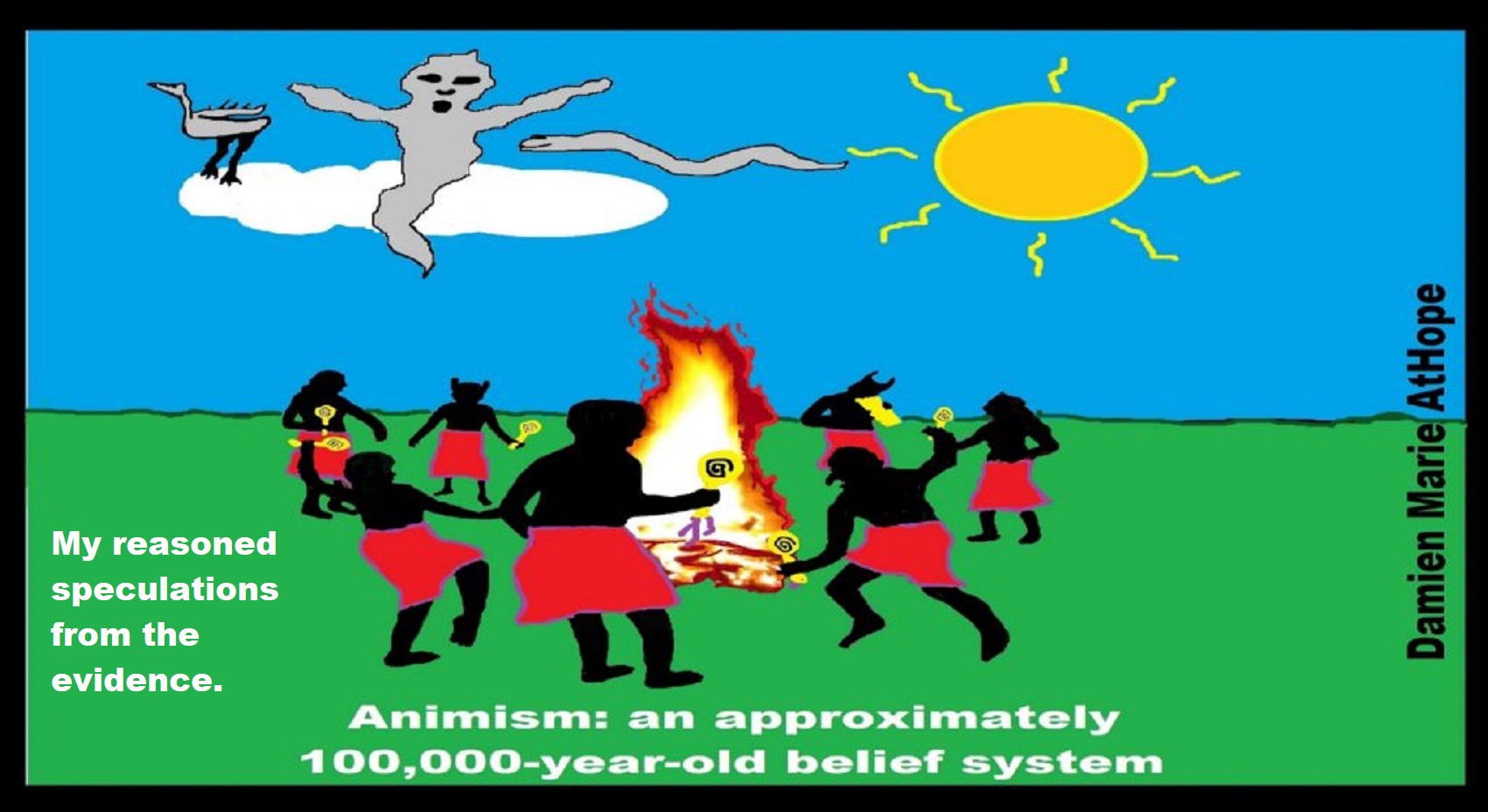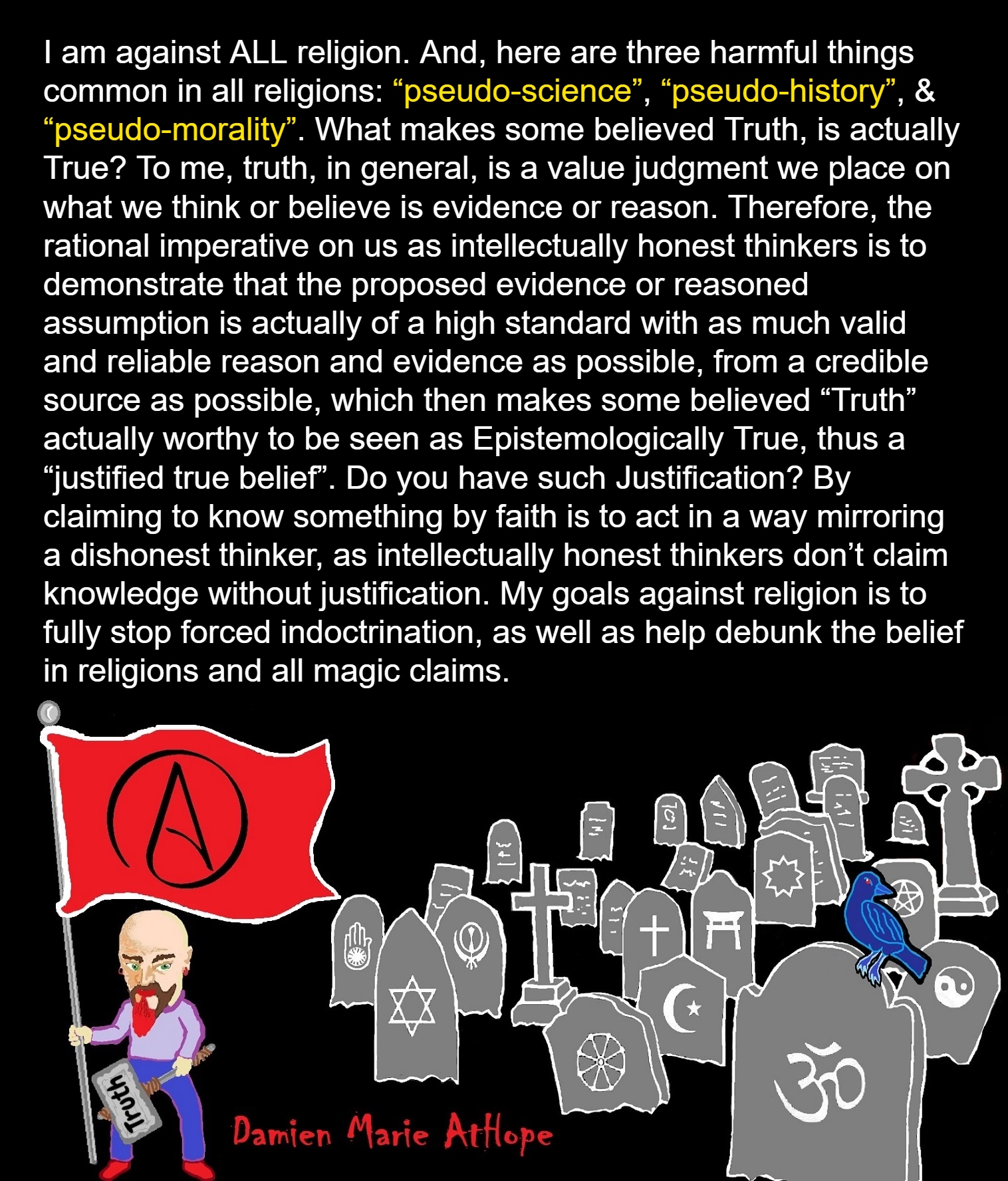Understanding Religion Evolution per Damien’s speculations from the evidence:
Pre-Animism (at least 300,000 years ago) possibly Africa, Middle East, and Eurasia
Animism (at least 100,000 years ago) possibly Southern Africa or maybe Central Africa
Totemism (at least 50,000/45,000 years ago) possibly around Germany, France, or somewhere in West Europe
Shamanism (at least 30,000/35,000 years ago) possibly West Siberia or East Russia
Paganism (at least 12,000/13,000 years ago) Turkey And/or Levant: “Israel, Jordan, Lebanon, Palestine, Syria”
Progressed organized religion (at least 5,000 years ago), (Egypt, the First Dynasty 5,150 years ago)
I think animism started 100,000 years ago, totemism 50,000-45,000 years ago, and shamanism 30,000-35,000 years ago.
Animism (simplified to me as a belief in a perceived spirit world) passably by at least 100,000 years ago “the primal stage of early religion” To me, Animistic Somethingism: You just feel/think there has to be something supernatural/spirit-world or feel/think things are supernatural/spirit-filled.
Totemism (simplified to me, as a belief that these perceived spirits could be managed or related with by created physical expressions) passably by at least 50,000 years ago “progressed stage of early religion” A totem is a representational spirit being, a sacred object, or symbol of a group of people, clan, or tribe.
Shamanism (simplified to me as a belief that some special person can commune with these perceived spirits on the behalf of others by way of rituals) passably by at least 30,000 years ago Shamanism is an otherworld connection belief thought to heal the sick, communicate with spirits/deities, and escort souls of the dead.
Animism (such as that seen in Africa: 100,000 years ago)
Did Neanderthals teach us “Primal Religion (Pre-Animism/Animism?)” 120,000 Years Ago? Homo sapiens – is known to have reached the Levant between 120,000 and 90,000 years ago, but that exit from Africa evidently went extinct. 100,000 years ago, in Qafzeh, Israel, the oldest intentional burial had 15 African individuals covered in red ocher was from a group who visited and returned back to Africa. 100,000 to 74,000 years ago, at Border Cave in Africa, an intentional burial of an infant with red ochre and a shell ornament, which may have possible connections to the Africans buried in Qafzeh.
Animism is approximately a 100,000-year-old belief system and believe in spirit-filled life and/or afterlife. If you believe like this, regardless of your faith, you are a hidden animist.
The following is evidence of Animism: 100,000 years ago, in Qafzeh, Israel, the oldest intentional burial had 15 African individuals covered in red ocher was from a group who visited and returned back to Africa. 100,000 to 74,000 years ago, at Border Cave in Africa, an intentional burial of an infant with red ochre and a shell ornament, which may have possible connections to the Africans buried in Qafzeh, Israel. 120,000 years ago, did Neanderthals teach us Primal Religion (Pre-Animism/Animism) as they too used red ocher and burials? ref, ref
It seems to me, it may be the Neanderthals who may have transmitted a “Primal Religion (Animism)” or at least burial and thoughts of an afterlife. The Neanderthals seem to express what could be perceived as a Primal “type of” Religion, which could have come first and is supported in how 250,000 years ago, the Neanderthals used red ochre and 230,000 years ago shows evidence of Neanderthal burial with grave goods and possibly a belief in the afterlife. ref
Do you think it is crazy that the Neanderthals may have transmitted a “Primal Religion”? Consider this, it appears that 175,000 years ago, the Neanderthals built mysterious underground circles with broken off stalactites. This evidence suggests that the Neanderthals were the first humans to intentionally bury the dead, doing so in shallow graves along with stone tools and animal bones. Exemplary sites include Shanidar in Iraq, Kebara Cave in Israel and Krapina in Croatia. Other evidence may suggest the Neanderthals had it transmitted to them by Homo heidelbergensis, 350,000 years ago, by their earliest burial in a shaft pit grave in a cave that had a pink stone axe on the top of 27 Homo heidelbergensis individuals and 250,000 years ago, Homo naledi had an intentional cemetery in South Africa cave. ref, ref, ref, ref, ref
Animism (such as that seen in Africa: 100,000 years ago)
- Animism: an approximately 100,000-year-old belief system?
- Rock crystal stone tools 75,000 Years Ago – (Spain) made by Neanderthals
- Stone Snake of South Africa: “first human worship” 70,000 years ago
- Similarities and differences in Animism and Totemism
- Did Neanderthals Help Inspire Totemism? Because there is Art Dating to Around 65,000 Years Ago in Spain?
- History of Drug Use with Religion or Sacred Rituals possibly 58,000 years ago?
Animism is approximately a 100,000-year-old belief system and believe in spirit-filled life and/or afterlife. If you believe like this, regardless of your faith, you are a hidden animist.
The following is evidence of Animism: 100,000 years ago, in Qafzeh, Israel, the oldest intentional burial had 15 African individuals covered in red ocher was from a group who visited and returned back to Africa. 100,000 to 74,000 years ago, at Border Cave in Africa, an intentional burial of an infant with red ochre and a shell ornament, which may have possible connections to the Africans buried in Qafzeh, Israel. 120,000 years ago, did Neanderthals teach us Primal Religion (Pre-Animism/Animism) as they too used red ocher and burials? ref, ref
It seems to me, it may be the Neanderthals who may have transmitted a “Primal Religion (Animism)” or at least burial and thoughts of an afterlife. The Neanderthals seem to express what could be perceived as a Primal “type of” Religion, which could have come first and is supported in how 250,000 years ago, the Neanderthals used red ochre and 230,000 years ago shows evidence of Neanderthal burial with grave goods and possibly a belief in the afterlife. ref
Do you think it is crazy that the Neanderthals may have transmitted a “Primal Religion”? Consider this, it appears that 175,000 years ago, the Neanderthals built mysterious underground circles with broken off stalactites. This evidence suggests that the Neanderthals were the first humans to intentionally bury the dead, doing so in shallow graves along with stone tools and animal bones. Exemplary sites include Shanidar in Iraq, Kebara Cave in Israel and Krapina in Croatia. Other evidence may suggest the Neanderthals had it transmitted to them by Homo heidelbergensis, 350,000 years ago, by their earliest burial in a shaft pit grave in a cave that had a pink stone axe on the top of 27 Homo heidelbergensis individuals and 250,000 years ago, Homo naledi had an intentional cemetery in South Africa cave. ref, ref, ref, ref, ref
- “120,000–90,000 years ago: Abbassia Pluvial in North Africa—the Sahara desert region is wet and fertile.
- 120,000 to 75,000 years ago: Khoisanid back-migration from Southern Africa to East Africa.
- 82,000 years ago: small perforated seashell beads from Taforalt in Morocco are the earliest evidence of personal adornment found anywhere in the world.
- 75,000 years ago: Toba Volcano supereruption that almost made humanity extinct. Populations could have been lowered to about 3000-1000 people on the Earth.
- 70,000 years ago: earliest example of abstract art or symbolic art from Blombos Cave, South Africa—stones engraved with grid or cross-hatch patterns.
- 70,000 years ago: Recent African origin: separation of sub-Saharan Africans and non-Africans.” ref
Did Neanderthals Help Inspire Totemism?
Because there is Art Dating to Around 65,000 Years Ago in Spain?
“What About Neanderthals and Religion”
Scientists have found the first major evidence that Neanderthals made cave paintings, indicating they may have had an artistic sense similar to our own. A new study led by the University of Southampton and the Max Planck Institute for Evolutionary Anthropology shows that paintings in three caves in Spain were created more than 64,000 years ago – 20,000 years before modern humans arrived in Europe. This means that the Palaeolithic (Ice Age) cave art – including pictures of animals, dots, and geometric signs – must have been made by Neanderthals, a ‘sister’ species to Homo sapiens, and Europe’s sole human inhabitants at the time. It also indicates that they may have had a similar artistic sense, in terms of thinking symbolically, to modern humans. Published today in the journal Science, the study reveals how an international team of scientists used a state-of-the-art technique called uranium-thorium dating to fix the age of the paintings as more than 64,000 years. Until now, cave art has been attributed entirely to modern humans, as claims to a possible Neanderthal origin have been hampered by imprecise dating techniques. However, uranium-thorium dating provides much more reliable results than methods such as radiocarbon dating, which can give false age estimates. Results show that the paintings we dated are, by far, the oldest known cave art in the world, and were created at least 20,000 years before modern humans arrived in Europe from Africa so it is assumed – therefore they may have been painted by Neanderthals. All three caves contain red (ochre) or black paintings of groups of animals, dots, and geometric signs, as well as hand stencils, handprints, and engravings. According to the researchers, creating the art must have involved such sophisticated behavior as the choice of a location, planning of light source and mixing of pigments. There is evidence that Neanderthals in Europe used body ornamentation around 40,000 to 45,000 years ago, but many researchers have suggested this was inspired by modern humans who at the time had just arrived in Europe. Study co-author Paul Pettitt, of Durham University, commented: “Neanderthals created meaningful symbols in meaningful places. The art is not a one-off accident. ref
Neanderthals are our closest extinct relative, but for a long time, they had a reputation for being pretty backward. Early modern humans, for example, made cave paintings. But even though Neanderthals used pigments and decorated themselves with eagle claws and shells, there was no clear proof that they painted caves. One theory goes that Neanderthals developed their rudimentary culture only after early modern humans arrived in Europe some 40,000 to 50,000 years ago. The most recent painting is at least 64,800 years old, according to this technique, and the oldest is more than 66,000 years old. ref
The Neanderthal was the only proven Human of Europe at the time, but was his or her brain up to the job? Or did modern humans reach Europe tens of thousands of years earlier than thought? The ancient art forms are symbolic but not figurative, explain their finders. In Spain, a cave in Maltravieso features hand stencils more than 66,000 years old, Prof. Dirk Hoffmann of the Max Planck Institute for Evolutionary Anthropology and others report in their paper, published Thursday in Science. The La Pasiega Cave in Cantabria features a ladder form composed of red horizontal and vertical lines that were created more than 64,000 years ago, they say. Further supporting the Neanderthal-as-artist theory, a related paper published Thursday in Science Advances reports that dyed and decorated seashells found in a Spanish cave dated to more than 115,000 years ago. Perforated shells found in sediments in Cueva de los Aviones that date to between 115,000 and 120,000 years. There’s no argument that there were Neanderthals in Europe 64,000 years ago. Homo sapiens, on the other hand, was thought to have reached Europe only 45,000 to 40,000 years ago. There is no evidence for modern humans in Iberia before 41,000 years ago, and there is evidence for Neanderthal presence until about 36,000 years ago in southern Spain and Portugal. Neanderthals existed for twice the time modern people have, if not more, and were once the dominant hominin in Europe. While Neanderthals may have etched a crisscross and perhaps carved a flute, look what Homo sapiens achieved, Coolidge says. The Paleolithic record is replete with exquisite works, from cave paintings to carvings done tens of thousands of years ago – such as the Lion Man sculpture found in a German cave and made of mammoth ivory some 38,000 years ago. ref
Neanderthal ritual or religious practice at around 50,000 years old burial in Sima de las Palomas in Murcia, Southeast Spain of a female covered with rocks inturned with a cut off panther paw, suggesting that Neanderthals—much like today’s bear hunters—ceremoniously cut off panther paws and kept them as totemistic trophies. This 50,000-year-old Neanderthal burial ground actually includes the remains of at least three individuals intentionally buried, with each Neanderthal’s arms folded such that the hands were close to the head. Remains of other Neanderthals have been found in this position, suggesting that it held meaning. The remains of six to seven other Neanderthals, including one baby and two juveniles, have also been excavated at the site. The tallest individual appears to have been an adult who stood around 5 feet 1 inch tall. ref, ref
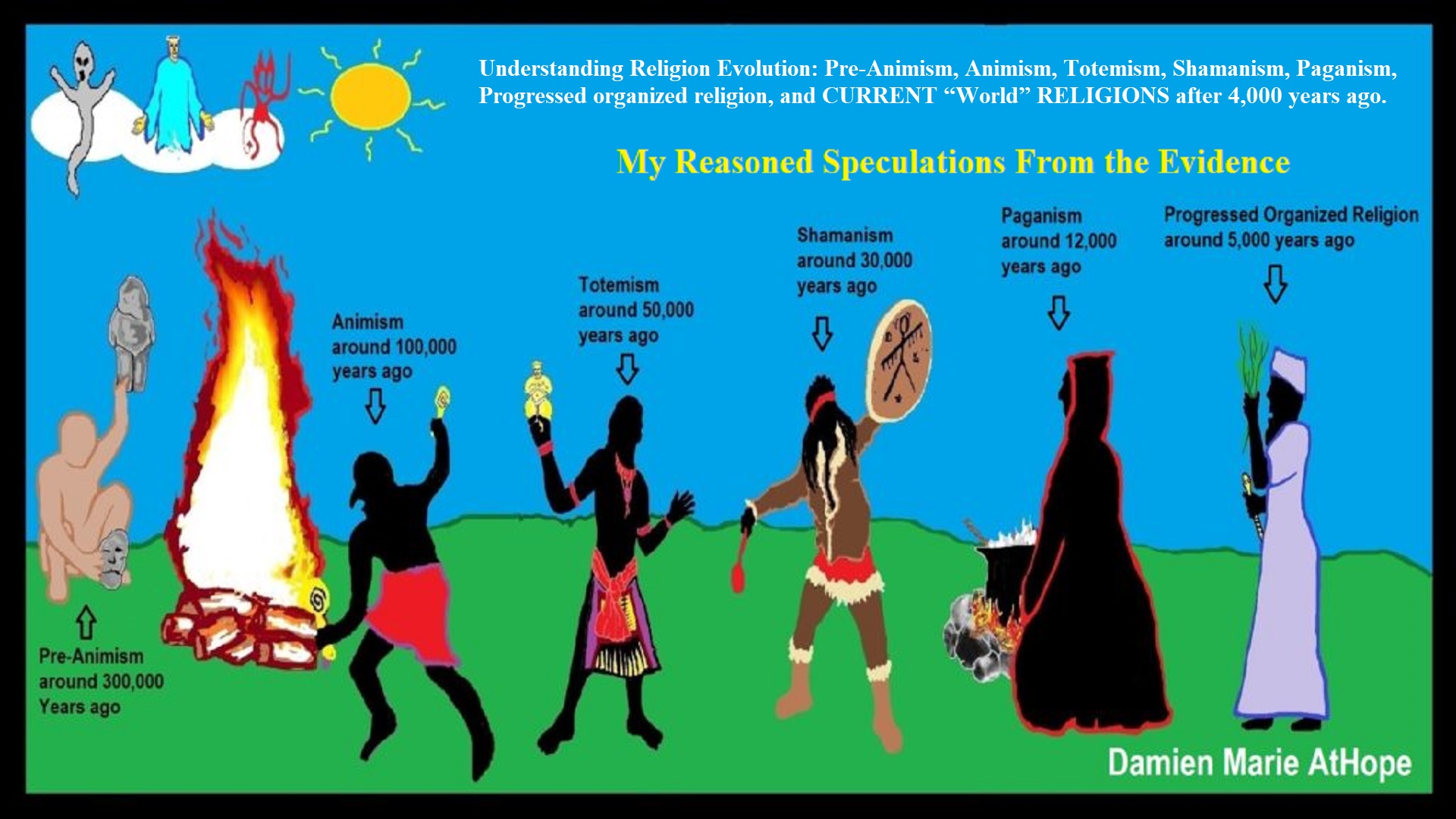
I post lots of religious info but don’t believe in any religion or spiritual beliefs?
I am an atheist, antitheist, and antireligionist. However, I am also a self-taught prehistorian, trying to explain the evolution of religion which requires me fully understand the connections of religious or spiritual beliefs to allow others to rethink the belief in them. To expose the evolution of religion and thus understand its humanness not just from reason but do to understanding all the facts of archaeology, anthropology, and religious mythology. It is to bring about awareness to inspire others to atheism or at least a new understanding of religion removing its believed special status when religion or spiritual beliefs are, to me, just “culture” or “sociocultural“ products, like language. I don’t believe in gods or ghosts, and nor souls either. I don’t believe in heavens or hells, nor any supernatural anything. I don’t believe in Aliens, Bigfoot, nor Atlantis. I strive to follow reason and be a rationalist. Reason is my only master and may we all master reason.
“Sociocultural factors characterize social and cultural forces that influence the feelings, attitudes, values, thoughts, beliefs, interactions, and behaviors of related individuals and groups.” ref
“Examples of sociocultural factors include:
- Income and wealth distribution
- Social classes
- Attitudes towards education and work,
- Language, customs, and taboos
- Business and health practices
- Housing
- Religious beliefs
- Population size and housing
- Social mobility
- Age distribution and social values” ref
We are like believing machines we vacuum up ideas, like Velcro sticks to almost everything. We accumulate beliefs that we allow to negatively influence our lives, often without realizing it. Our willingness must be to alter skewed beliefs that impend our balance or reason, which brings about a new caring awareness.
I don’t believe in the supernatural notion of a “soul,” especially with our natural only evolution. Undesigned natural processes of evolution made us “believing-machines.” I am not an animist, thus I don’t believe in souls or spirits. How can I? When in our natural only evolution was there added magical anything? I can’t buy anything but natural, thus I can be labeled a “Metaphysical naturalist (also called ontological naturalist, philosophical naturalist, and anti-supernaturalist) which is a philosophical worldview that holds that there is nothing but natural elements, principles, and relations of the kind studied by the natural sciences.” ref
I am not an academic though I work hard for accuracy and facts, I do this hard work of addressing prehistory and religion as activism (Pro-science and Atheist). I know quite a lot as I started researching the “Evolution of Religion” starting in 2006.
I am a rationalist, not a skeptic. I appeal to reason, not doubt, like most atheists. No “skepticism attack” tactics used on others atheists works on me, as I don’t even value skepticism. When the Truth is afraid, Fascism of some kind, likely Reigns. While many skeptics may tend to strive to master doubt, I as a rationalist, strive to master reason.
I am a Methodological Rationalist, I rarely am pushed to doubt as a default, instead, I see reason as my default and at times it may be responsible to doubt, but I get to that conclusion because of reasoning. Methodological: relating to the system of methods used in a particular area of study or activity: such as “a wide variety of methodological approaches to ethical problem-solving in my approach to truth or the label of knowledge.”
I fully enjoy the value (axiology) of archaeology (empirical evidence from fact or artifacts at a site) is knowledge (epistemology) of the past, adding to our anthropology (evidence from cultures both the present and past) intellectual (rational) assumptions of the likely reality of actual events from time past.
Religion is Unwarranted Faith and Belief. The problem with religion is unwarranted faith and belief. The problem of faith is as an invalid justification and the belief problem is holding unjustified false belief believing it is justified true belief. I use the Animism term as a definition of spirit-beliefs or a kind of Supernatural-Spiritism thinking, that to me, are in all spiritual or religious type beliefs, not primitive but core. I see Animism as the original religion (religious non-naturalism/supernatural persuasion or spiritual/magical thinking) of all humanity and is still in all the religions of the world.
I am mainly a prehistorian, 1 million to around 5,000/4,000 years ago. So while I may understand the past most don’t I don’t know a lot of history many seem to commonly know. I am not reading any more books, maybe ever again as I am tired from a life devoted to deep study. lol
Nothing is a justified true belief without valid or reliable reason and evidence; just as everything believed must be open to question, leaving nothing above challenge.
I don’t see religious terms Animism, Totemism, Shamanism, or Paganism as primitive but original or core elements that are different parts of world views and their supernatural/non-natural beliefs or thinking.
In the past or even lingering today, are beliefs often ripe with religious bigotry, seen in how religious/spiritual thinking not Abrahamic (Judaism, Christianity, or Islam) religious thinking are often believed to be primitive, unequal, or less than monotheism (preserved as the only real or not the correct religion beliefs if not monotheism).
I see all religions as having shared or similar features or core elements that relate to religious terms Animism, Totemism, Shamanism, or Paganism including Abrahamic (Judaism, Christianity, or Islam) religious thinking.
I don’t class any religious thinking as primitive but in error to what I see as a natural-only world, that religious thinking then makes up a myriad of non-natural/non-empirical themes/beings, stories, and myths about which group together are called religions.
I do anarchist teaching of prehistory, in that I don’t just make a blog, expecting people to come to me. No, I take all my knowledge and like a gorilla soldier, I force-feed to the world my knowledge, one piece at a time, that is just what is needed. So, I heed that call and teach in public…
Do good, make no excuses, just do good, the world desperately needs more of this, and if we all do more, we all win. We rise by helping each other. I am an autodidactic-polymath in many subjects and a genus in both IQ intelligence as well as EQ emotional intelligence, quite rare. Yet I am ignored? Most disregard my ideas, I don’t think so, or is it due to my blogs that are so long they are like small free books, scary right?
I like learning prehistory!
I also hate: “Pseudo-science, Pseudo-history, and Pseudo-morality.”
So yeah, history is fun, but one must weed through the sometimes added mythology, half-truths, or outright lies. This is even more important when reading religion-related information.
The greatest lie ever, was the fraud of democracy, from its conceptions in Greece, claiming the freedom to vote, all the while upholding the institution of slavery. We today are sold the lie of capitalism, and the elite that play in space, while children starve in the streets…
The sad history of democracy is one of continued bigotry of elites and slaves, but now with a happy face or less unhappy faces, I should say, for more accuracy, as some non-slaves were a little more equal in a limited kind of way and/or scope.
If Americanism has taught us anything, it is that this “land” (people claiming colonialism as a birthright) loves bigotry, hate, lying, violence, denial, and unscientific explanations to just about any damn thing that can’t get away fast enough.
What if truth, mattered? Would we be more open-minded, or did you think you were already good, no improvement needed as most do, or do you let “new knowledge” alluded to, get in? Do you care? If so, what have you done to help change the world? When was the last time you realized you were wrong, then changed?
I often struggle for a better world but it is hard when hate is more motivating than love… Shamefully, the world thrives on bigotry and it needs to stop, no matter what style of society it is wrong.
“Blind belief in authority is the greatest enemy of truth.” Albert Einstein
Silence is no virtue, especially against injustice, oppression, or untruths. From our natural only reality, there is no need to hide, for Atheism and a magic-free universe is the truth and theism religion and its supernatural thinking gods are just a lie. Truth deserves to be supported and has no need to remain silent and should instead, inspire its strong championing. I hear this call deep in me to bravely champion the truth of atheism and I do it with pride. To me, Animistic Somethingism: You just feel/think there has to be something supernatural/spirit-world or feel/think things are supernatural/spirit-filled. “Somethingism” is commonly an unspecified belief in an undetermined supernatural reality, stated sometimes as spiritual but not religious, but, to me, is basically unrealized animism. Vague Theism or god Somethingism: just say NO! May I remind you , vague theism, somethingism or “ietsism” is not some Philosophers Stone of Theism removed from strong critique.
So loudly, I will proclaim supernatural, and gods are willful mental illusions, confusions, and lies that are commonly inspired by a life of religious influences, religiously motivated fears, and or religious indoctrination. I laugh at questions like “what would convince you of god” as if I approach thinking differently dependent. As a rationalist I am always moved best by valid and reliable reason and evidence, you know the very stuff, all religions and any supernatural claim always lack in the end. Religion is big on claims but small of real reasoning, full of logical fallacies in thinking, and no evidence to quorate all their delusionary supernatural nonsense and superstitions.
Go religion-free and rise to your own self-mastery.
I will grant you some religious mythology is quite interesting but I never forget it is simple stories of hope, fear, and magical thinking arising from human ignorance fueled by imagination and presto people believe in things never seen. I hate religion as I hate harm, oppression, bigotry, and love equality, self-ownership, self-empowerment, self-actualization including self-mastery, as well as truth and not only does religion lie, it is a conspiracy theory of reality. I know that god-something is an unjustified and debunked claim of some “super” supernatural, when no supernatural anything has ever been found to even start such claims.
I don’t think antireligionism is really anti-friendly-atheism, as it can involve being friendly to people even if it is harsh to religion, positive antireligionism or Anti-Accommodationism is attacking bad thinking and bad behaviors, not just people who believe. Not just an atheist and antitheist, I am a proud anti-religionist. I have greater confidence in science as they often admit errors and I have greater mistrust of religion as they often refuse to accept or admit errors.
What I do not like about religion in one idea, religions as a group are “Conspiracy Theories of Reality,” usually filled with Pseudoscience, Pseudohistory, along with Pseudomorality, and other harmful aspects. An antireligionist generally means opposition to religion, this includes all, every religion or pseudo-religion, YES, I am an atheist and antitheist, who is “Anti” ALL RELIGIONS. But I am against the ideas, not people. We regrettably pay our life debt in our time lost living one moment at a time which seems to group together into what we call a life, so live as there just went another lost moment.
“But Damien, Souls are real because energy does not die!”
My response, That is a logical fallacy as it is not a reasoned jump in logic. Energy leaves all once alive bodies by dissipating heat in the environment then is gone as the once related energy in a now dead body.
Quick Evolution of Religion?
Pre-Animism (at least 300,000 years ago) pre-religion is a beginning that evolves into later Animism. So, Religion as we think of it, to me, all starts in a general way with Animism (Africa: 100,000 years ago) (theoretical belief in supernatural powers/spirits), then this is physically expressed in or with Totemism (Europe: 50,000 years ago) (theoretical belief in mythical relationship with powers/spirits through a totem item), which then enlists a full-time specific person to do this worship and believed interacting Shamanism (Siberia/Russia: 30,000 years ago) (theoretical belief in access and influence with spirits through ritual), and then there is the further employment of myths and gods added to all the above giving you Paganism (Turkey: 12,000 years ago) (often a lot more nature-based than most current top world religions, thus hinting to their close link to more ancient religious thinking it stems from). My hypothesis is expressed with an explanation of the building of a theatrical house (modern religions development). Progressed organized religion (Egypt: 5,000 years ago) with CURRENT “World” RELIGIONS (after 4,000 years ago).
Historically, in large city-state societies (such as Egypt or Iraq) starting around 5,000 years ago culminated to make religion something kind of new, a sociocultural-governmental-religious monarchy, where all or at least many of the people of such large city-state societies seem familiar with and committed to the existence of “religion” as the integrated life identity package of control dynamics with a fixed closed magical doctrine, but this juggernaut integrated religion identity package of Dogmatic-Propaganda certainly did not exist or if developed to an extent it was highly limited in most smaller prehistoric societies as they seem to lack most of the strong control dynamics with a fixed closed magical doctrine (magical beliefs could be at times be added or removed). Many people just want to see developed religious dynamics everywhere even if it is not. Instead, all that is found is largely fragments until the domestication of religion.
Religions, as we think of them today, are a new fad, even if they go back to around 6,000 years in the timeline of human existence, this amounts to almost nothing when seen in the long slow evolution of religion at least around 70,000 years ago with one of the oldest ritual worship. Stone Snake of South Africa: “first human worship” 70,000 years ago. This message of how religion and gods among them are clearly a man-made thing that was developed slowly as it was invented and then implemented peace by peace discrediting them all. Which seems to be a simple point some are just not grasping how devastating to any claims of truth when we can see the lie clearly in the archeological sites.
I classify Animism (animated ‘spirit‘ or “supernatural” perspectives).
I see all religious people as at least animists, so, all religions have at least some amount, kind, or expression of animism as well.
I want to make something clear as I can, as simple as I can, even though I classify Animism (animated and alive from Latin: anima, ‘breath, spirit, life‘ or peoples’ “spiritual” or “supernatural” perspectives. Potentially, in some animism perceives, all things may relate to some spiritual/supernatural/non-natural inclinations, even a possible belief that objects, places, and/or creatures all possess a distinct spiritual essence, and/or thinking things like all things—animals, plants, rocks, rivers, weather systems, human handiwork, and perhaps even words— could be as animated and alive ref) as the first expression of religious thinking or religion, it is not less than, nor is it not equal to any other religion, or religious thinking. I see all religious people as at least animists any way, so everyone is at least animist, how could it be less than other religions as all other religions have at least some amount, kind, or expression of animism. Animism, +? is what I think about all that say they are spiritual or religious in thinking. Regardless if they know it, understand it, or claim it, they all, to me, an animistic-thinker, plus a paganistic, totemistic, and shamanistic-monotheist, calling themselves a Christian, Jew, or Muslim, as an example of my thinking. Animism (is the other-then-reality thinking relates to, thus it is in all such non-reality thinking generally.
I use the Animism term as a definition of spirit-beliefs or a kind of Supernatural-Spiritism thinking, that to me, are in all spiritual or religious type beliefs, not primitive but core. I see Animism as the original religion (religious non-naturalism/supernatural persuasion or spiritual/magical thinking) of all humanity and is still in all the religions of the world. Furthermore, I actually am impressed by animist cultures in Africa, others have seen them as primitive or something, help with that, they are revolutionaries with women’s rights, child rights. I mean if I had to choose a religion it would be animism only like in Africa so I don’t look down on them nor any indigenous peoples, who I care about, as well as I am for “humanity for all.” I challenge religious Ideas, and this is not meant to be an attack on people, but rather a challenge to think or rethink ideas, I want what is actually true. May we all desire a truly honest search for what is true even if we have to update what we believe or know. I even have religious friends, as I am not a bigot.
I class religious thinking in “time of origin” not somehow that any are better or worse or more reasoned than others. No, I am trying to help others understand how things happened, so they understand, and for themselves can finally think does the religion they say they believe in, still seems true, as they believed before learning my information and art. I am hoping I inspire freedom of thought and development of heart as well as mind as we need such a holistic approach in our quest for a humanity free for all and supportive of all. Until then, train your brain to think ethically. We are responsible for the future, we are the future, living in the present, soon to be passed, so we must act with passion, because life is over just like that. I am just another fellow dignity being. May I be a good human.
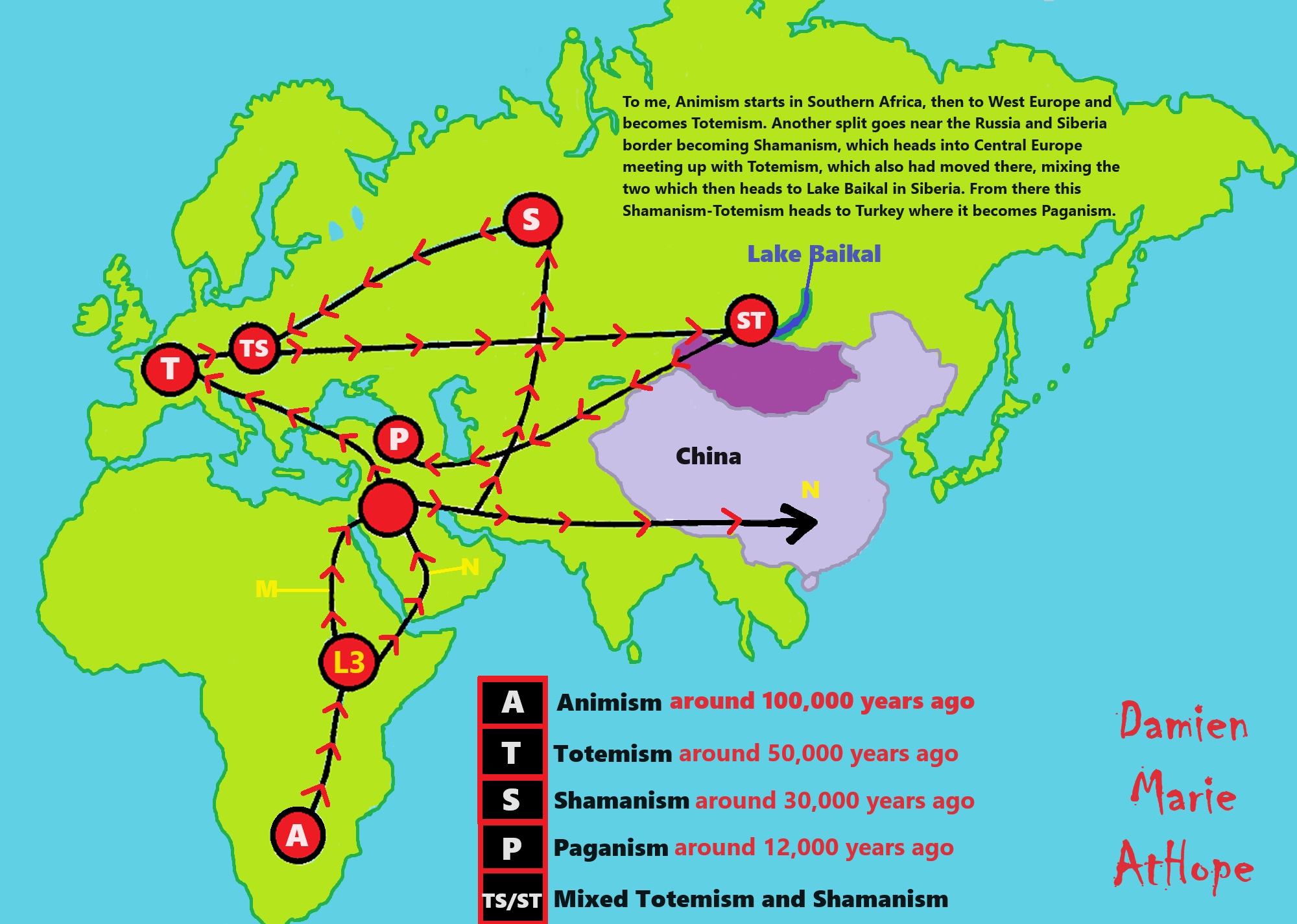
To me, Animism starts in Southern Africa, then to West Europe, and becomes Totemism. Another split goes near the Russia and Siberia border becoming Shamanism, which heads into Central Europe meeting up with Totemism, which also had moved there, mixing the two which then heads to Lake Baikal in Siberia. From there this Shamanism-Totemism heads to Turkey where it becomes Paganism.

Here are a few of what I see as “Animist only” Cultures:
“Aka people” Central African nomadic Mbenga pygmy people. PRONUNCIATION: AH-kah
“The Aka people are very warm and hospitable. Relationships between men and women are extremely egalitarian. Men and women contribute equally to a household’s diet, either a husband or wife can initiate divorce, and violence against women is very rare. No cases of rape have been reported. The Aka people are fiercely egalitarian and independent. No individual has the right to force or order another individual to perform an activity against his or her will. Aka people have a number of informal methods for maintaining their egalitarianism. First, they practice “prestige avoidance”; no one draws attention to his or her own abilities. Individuals play down their achievements.” ref
“Mbuti People”
“The Mbuti people are generally hunter-gatherers who commonly are in the Congo’s Ituri Forest have traditionally lived in stateless communities with gift economies and largely egalitarian gender relations. They were a people who had found in the forest something that made life more than just worth living, something that made it, with all its hardships and problems and tragedies, a wonderful thing full of joy and happiness and free of care. Pygmies, like the Inuit, minimize discrimination based upon sex and age differences. Adults of all genders make communal decisions at public assemblies. The Mbuti people do not have a state, or chiefs or councils.” ref
“Hadza people”
“The Hadza people of Tanzania in East Africa are egalitarian, meaning there are no real status differences between individuals. While the elderly receive slightly more respect, within groups of age and sex all individuals are equal, and compared to strictly stratified societies, women are considered fairly equal. This egalitarianism results in high levels of freedom and self-dependency. When conflict does arise, it may be resolved by one of the parties voluntarily moving to another camp. Ernst Fehr and Urs Fischbacher point out that the Hadza people “exhibit a considerable amount of altruistic punishment” to organize these tribes. The Hadza people live in a communal setting and engage in cooperative child-rearing, where many individuals (both related and unrelated) provide high-quality care for children. Having no tribal or governing hierarchy, the Hadza people trace descent bilaterally (through paternal and maternal lines), and almost all Hadza people can trace some kin tie to all other Hadza people.” ref
- First, there is the foundation: Superstitionism and Symbolism/Ritualism.
- Second, is the frame and walls: Supernaturalism and Sacralizism/Spiritualism.
- Third, is the roof and finishing elements of the structure: Dogmatism and Myths.
- Fourth, is the window dressing and stylings to the house: decorated with the webs religious Dogmatic-Propaganda.
In the stage of organized religion, one important aspect that is often overlooked because of male-only thinking or by some over-emphasized because of extreme feminism is gender. There are some obvious gender associations in artifacts and possible gender-involved religious beliefs but thoughtful feminist archaeologists do not pounce on every representation of a woman and pronounce that it is a goddess. Around 5,000 years ago there are the full elements seem to be grouping together with its connected set of Dogmatic-Propaganda-Closure belief strains of sacralized superstitionism that took different forms of behavior in different areas of the world.
Interconnectedness of religious thinking Animism, Totemism, Shamanism, and Paganism
So, it all starts in a general way with Animism (theoretical belief in supernatural powers/spirits), then this is physically expressed in or with Totemism (theoretical belief in mythical relationship with powers/spirits through a totem item), which then enlists a full-time specific person to do this worship and believed interacting Shamanism (theoretical belief in access and influence with spirits through ritual), and then there is the further employment of myths and gods added to all the above giving you Paganism (often a lot more nature-based than most current top world religions, thus hinting to their close link to more ancient religious thinking it stems from). My hypothesis is expressed with an explanation of the building of a theatrical house (modern religions development ending with Institutional religion/organized religion).
Primal early superstition starts around 1 million years ago with. Then the development of religion increased around 600,000 years ago with proto superstition and then even to a greater extent around 300,000 years ago with progressed superstition. Around 100,000 years ago, is the primal stage of early religion, the proto stage of religion is around 75,000 years ago, or less, the progressed stage of early religion is around 50,000 years ago and finally after 13,500 years ago, begins with the evolution of organized religion. The set of stages for the development of organized religion is subdivided into the following: the primal stage of early organized religion is 13,000 years ago, the proto stage of organized religion is around 10,000 years ago, and finally the progressed stage of organized religion is around 7,000 years ago with the forming of mythology and its connected set of Dogmatic-Propaganda-Closure belief strains of sacralized superstitionism. In the stage of organized religion, one important aspect that is often overlooked because of male-only thinking or by some over-emphasized because of extreme feminism is gender. There are some obvious gender associations in artifacts and possible gender-involved religious beliefs but thoughtful feminist archaeologists do not pounce on every representation of a woman and pronounce that it is a goddess. Around 5,000 years ago elements seem to be grouping together with its connected set of Dogmatic-Propaganda-Closure belief strains of sacralized superstitionism that took different forms of behavior in different areas of the world.
Promoting Religion as Real is Harmful?
Sometimes, when you look at things, things that seem hidden at first, only come clearer into view later upon reselection or additional information. So, in one’s earnest search for truth one’s support is expressed not as a one-time event and more akin to a life’s journey to know what is true. I am very anti-religious, opposing anything even like religion, including atheist church. but that’s just me. Others have the right to do atheism their way. I am Not just an Atheist, I am a proud antireligionist. I can sum up what I do not like about religion in one idea; as a group, religions are “Conspiracy Theories of Reality.” These reality conspiracies are usually filled with Pseudo-science and Pseudo-history, often along with Pseudo-morality and other harmful aspects and not just ancient mythology to be marveled or laughed at. I regard all this as ridiculous. Promoting Religion as Real is Mentally Harmful to a Flourishing Humanity To me, promoting religion as real is too often promotes a toxic mental substance that can divide a person from who they are shaming them for being human. In addition, religion is a toxic mental substance that can divide a person from real history, real science or real morality to pseudohistory, pseudoscience, and pseudomorality. Moreover, religion is a toxic mental substance that can divide a person from rational thought, critical thinking, or logic. Likewise, religion is a toxic mental substance that can divide a person from justice, universal ethics, equality, and liberty. Yes, religion is a toxic mental substance that can divide a person from loved ones, and religion is a toxic mental substance that can divide a person from humanity. Therefore, to me, promoting religion as real is too often promote a toxic mental substance that should be rejected as not only false but harmful as well even if you believe it has some redeeming quality. To me, promoting religion as real is mentally harmful to a flourishing humanity. Religion may have once seemed great when all you had or needed was to believe. Science now seems great when we have facts and need to actually know.
Homo naledi may have lit fires in underground caves at least 236,000 years ago
“Remnants of small fireplaces found in South African cave system, researchers announce. An ancient hominid dubbed Homo naledi may have lit controlled fires in the pitch-dark chambers of an underground cave system, new discoveries hint. Researchers have found remnants of small fireplaces and sooty wall and ceiling smudges in passages and chambers throughout South Africa’s Rising Star cave complex, paleoanthropologist Lee Berger announced in a December 1 lecture hosted by the Carnegie Institution of Science in Washington, D.C. “Signs of fire use are everywhere in this cave system,” said Berger, of the University of the Witwatersrand, Johannesburg.” ref
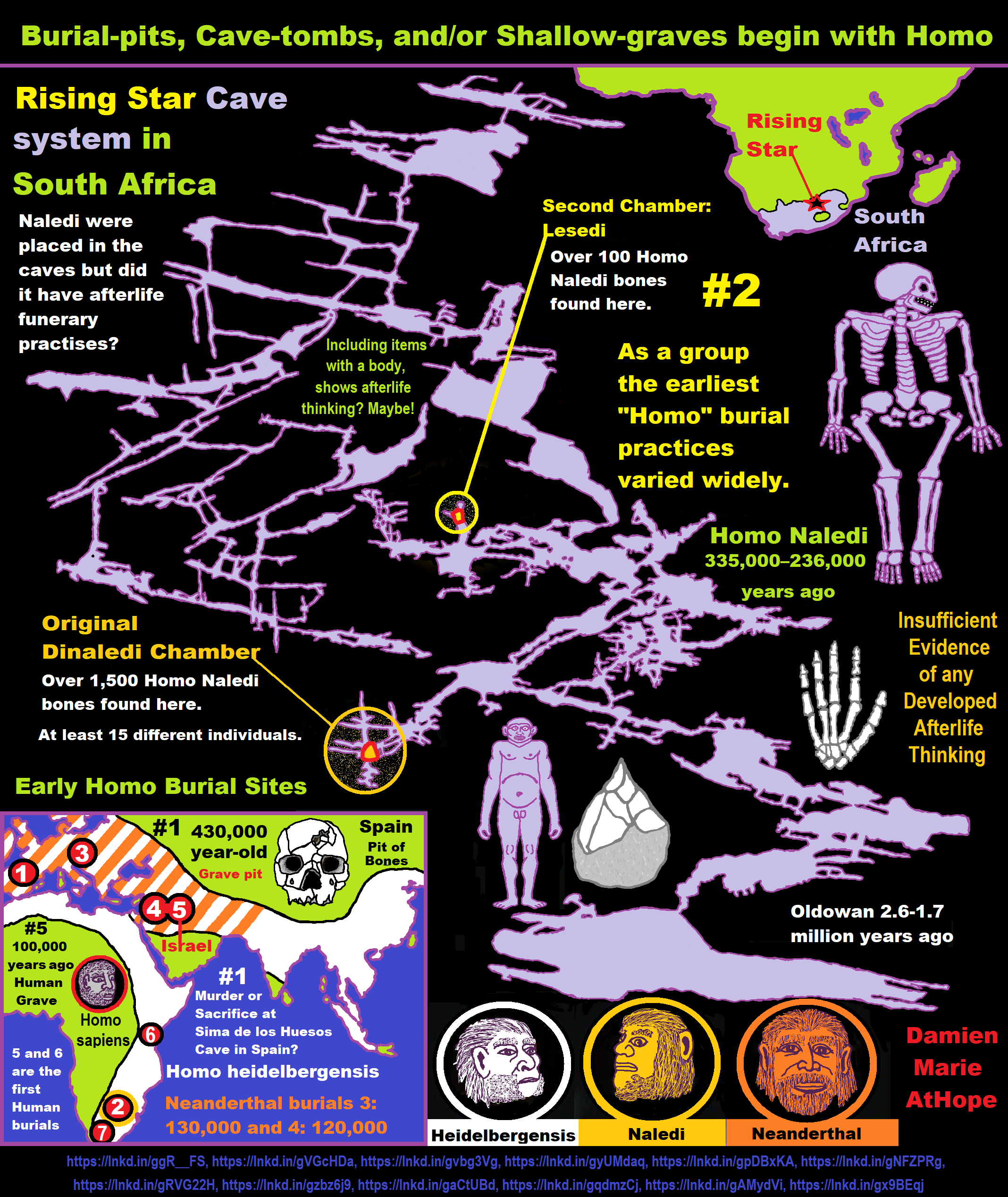
ref, ref, ref, ref, ref, ref ,ref ,ref ,ref ,ref, ref, ref
Homo Naledi
“Homo Naledi is a species of archaic human discovered in the Rising Star Cave, Cradle of Humankind, South Africa dating to the Middle Pleistocene 335,000–236,000 years ago. The initial discovery comprises 1,550 specimens, representing 737 different elements, and at least 15 different individuals. Despite this exceptionally high number of specimens, their classification with other Homo remains unclear.” ref
“Along with similarities to contemporary Homo, they share several characteristics with the ancestral Australopithecus and early Homo as well (mosaic anatomy), most notably a small cranial capacity of 465–610 cm3 (28.4–37.2 cu in), compared to 1,270–1,330 cm3 (78–81 cu in) in modern humans. They are estimated to have averaged 143.6 cm (4 ft 9 in) in height and 39.7 kg (88 lb) in weight, yielding a small encephalization quotient of 4.5. Nonetheless, Homo Naledi’s brain anatomy seems to have been similar to contemporary Homo, which could indicate equatable cognitive complexity. The persistence of small-brained humans for so long in the midst of bigger-brained contemporaries revises the previous conception that a larger brain would necessarily lead to an evolutionary advantage, and their mosaic anatomy greatly expands the known range of variation for the genus.” ref
“Homo Naledi anatomy indicates that, though they were capable of long-distance travel with a humanlike stride and gait, they were more arboreal than other Homo, better adapted to climbing and suspensory behavior in trees than endurance running. Tooth anatomy suggests consumption of gritty foods covered in particulates such as dust or dirt. Though they have not been associated with stone tools or any indication of material culture, they appear to have been dextrous enough to produce and handle tools, and likely manufactured Early or Middle Stone Age industries. It has also been controversially postulated that these individuals were given funerary rites, and were carried into and placed in the chamber.” ref
Pre-Animism (at least 300,000 years ago)
- Around 500,000 – 233,000 years ago, Oldest Anthropomorphic art (Pre-animism) is Related to Female
- 400,000 Years Old Sociocultural Evolution
- Pre-Animism: Portable Rock Art at least 300,000-year-old
- Homo Naledi and an Intentional Cemetery “Pre-Animism” dating to around 250,000 years ago?
- Oldowan stone tool Culture (2.6–1.7 Million years ago)
- Acheulean stone tool culture (1.76–0.1 Million years ago)
- Acheulo-Yabrudian stone tool culture (400-200,000 years ago)
- Mousterian stone tool culture (160,000–35-30,000 years ago)
- Aterian (145,000–c. 20,000 years ago)
First, there was Pre-Animism: Portable Rock Art
Around a million years ago, I surmise that Pre-Animism, “animistic superstitionism”, began and led to the animistic somethingism or animistic supernaturalism, which is at least 300,000 years old and about 100,00 years ago, it evolves to a representation of general Animism, which is present in today’s religions.
Anthropology states that Pre-animism is “A stage of religious development supposed to have preceded animism, in which material objects were believed to contain spiritual energy.” ref
To me, it is a kind of “Primal Pre-Religion (Pre-Animism/Proto-Animism” or at least burial and thoughts of an afterlife, may have been transferred from the Neanderthals to arcane humans when they bred with them. Neanderthals, also interbred with Homo erectus, the ‘upright walking man,’ Homo habilis, the ‘tool-using man” and possibly others, which means they could have possibly learned some pre-animism ideas from one of the other hominids thas is expressed in portable anthropomorphic art, which could have been related to some kind of ancestor veneration as well. ref
Around 500,000 to 400,000 years ago, the earliest European hominin crania associated with Acheulean handaxes are at the sites of Arago, Atapuerca Sima de los Huesos, and Swanscombe. The Atapuerca fossils and the Swanscombe cranium belong to the Neandertals whereas the Arago hominins have been attributed to Homo heidelbergensis or to a subspecies of Homo erectus, which is an incipient stage of Neandertal evolution. A cranium (Aroeira 3) from the Gruta da Aroeira (Almonda karst system, Portugal) dating to 436,000 to 390,000 years ago provides important evidence on the earliest European Acheulean-bearing hominins as well as could show a transfer of ideas. ref
Homo erectus, the “upright walking man,” lived between 1.89 million and 143,000 years ago, whereas early African Homo erectus and sometimes called Homo ergaster are the oldest known early humans to have possessed modern human-like attributes. The earliest evidence of campfires occurred during the time of Homo erectus. While there is evidence that campfires were used for cooking, and probably sharing food, they are likely to have been placed for social interaction, used for warmth, to keep away large predators, and possibly even relating to Primal Religion, “Pre-Animism,” which may have included Fire Sacralizing and/or Worship. ref
Neanderthals used fire 400,000 years ago and there is evidence of a 300,000-year-old ‘campfire’ from Israel, which is not that surprising since our human ancestors have controlled fire from 1.5 million to 300,000 years ago and beyond. The benefits of fire are not only to cook food and fend off predators, but also extended their day and added to the community by how a fire in the middle of the darkness mellows and also excite people, which possibly inspire pre-animism’s “animistic superstitionism.” ref
Forkhead box P2 (FOXP2) is implicated in human speech and language playing important roles in the plasticity of the developing brain and that of modern populations suggests that it has been the target of positive (Darwinian) selection during recent human evolution. The first mutations in exon 7 more than around 400,000 years ago, prior to the human-Neandertal split, and impacted FOXP2 function. The second event, beginning within the last 200,000 years, did not involve further FOXP2 amino acid changes (because the Neandertal and human FOXP2 are identical) but might have instead affected FOXP2. Overall, there was strong evidence of selection of FOXP2 targets in Europeans, but not in the Han Chinese, Japanese, or Yoruba populations. Analyses of ancient DNA samples have revealed that the amino acid differences were shared with Neandertals, who split from modern humans 300,000–400,000 years ago, and the haplotypes extended across the amino acid changes. And, Neanderthals and humans share two changes in FOXP2 compared with chimpanzees and the possibilities range from interaction gene flow to that of a common ancestor to both or changes and selective sweep occurred before the divergence that could mean Neanderthals had language and or other type capabilities. ref, ref
There was a primitive Homo sapiens skull found at Jebel Irhoud in Morocco dated to around 300,000 years ago. With remarkable similarities between the Moroccan skull and one found in China dated to around 260,000 years ago. ref, ref
Sun-worshipping baboons rise early to catch the African sunrise and race each other to the top for the best spots. Thus, we may rightly ponder how much did fireside tales aid to the socio-cultural-religious transformations or evolution. In the dark under flickering lights from the stars above and the fire below was the scene of wonder, fear, and mystery. Was superstition expanded and religion further imagined? It would seem that superstition was expanded and religion further imagined because both heavenly lights and flickering fire have been sacralized. This does seem to be somewhat supported by a researcher who spent 40 years studying African Bushmen who gathered evidence of the importance of gathering around a nighttime campfire as a time for bonding, social information, and shared emotions with fireside tales. This may provide a correlation that our prehistoric ancestors likely lived in a similar way to how the Bushmen currently do. Although we cannot directly peer into the past or fully know the past from the indigenous Bushmen, these people do live in a way that our ancient ancestors lived for around 99% of our evolution.
Fire, as sacred or magic, can be seen in:
- Consuming fire as volcanos/lightning as gods and gods’power/vengeance.
- Holy fire as a means of transformation or magical purification.
- A magical being as used in worshipping the sun or punishment such as hell/lake of fire, which could be seen as mixing fire and water, if only symbolically.
- Ceremonies such as bonfires, eternal flames, or sacred candles/incense/lights/lamps are in one form or another incorporated in many faiths such as judaism, christianity, islam, hinduism, buddhism, sikhism, bahaism, shintoism, taoism, etc. ref, ref, ref, ref, ref, ref, ref, ref, ref, ref, ref
All this worship of fire/sun is hardly special to humans since many other primates worship thunderstorms, others fire, or sunrises. We have forgotten how nature worship, animistic superstitionism, animistic somethingism, or animistic supernatralism is presented in today’s religion. The mega religions now think they are removed from animistic superstitionism, which they are not. Their rituals, beliefs, and prayers have a connection to animism nature worship but are more hidden or stylized such as burning candles, which is worshipping fire.
Archaeology reveals that the world’s oldest sculpture was enhanced by hominid hand. To date, the oldest known human three-dimensional representation is the Tan-Tan sculpture, which is an anthropomorific human form from Morocco was found in ancient river deposits of the Draa river. It is Acheulian and has been dated between 500,000 to 300,000 years old. 500,000 to 233,000 years ago, in Israel, another sculpture, which may be the oldest Stone Age Art was found at the Berekhat Ram site on the Golan Heights that consist of a small quartzite pebble, which resembles a human female figure with magical believed qualities or representing something that was believed to be magical. ref
Is this just art or a form of ancestor veneration?
Pre-animism ideas can be seen in rock art such as that expressed in portable anthropomorphic art, which may be related to some kind of ancestor veneration. This magical thinking may stem from a social or non-religious function of ancestor veneration, which cultivates kinship values such as filial piety, family loyalty, and continuity of the family lineage. Ancestor veneration occurs in societies with every degree of social, political, and technological complexity and it remains an important component of various religious practices in modern times.
Humans are not the only species, which bury their dead. The practice has been observed in chimpanzees, elephants, and possibly dogs. Intentional burial, particularly with grave goods, signify a “concern for the dead” and Neanderthals were the first human species to practice burial behavior and intentionally bury their dead, doing so in shallow graves along with stone tools and animal bones. Exemplary sites include Shanidar in Iraq, Kebara Cave in Israel and Krapina in Croatia. The earliest undisputed human burial dates back 100,000 years ago with remains stained with red ochre, which show ritual intentionality similar to the Neanderthals before them. ref, ref
- “300,000 years ago: the first possible appearance of Homo sapiens, in Jebel Irhoud, Morocco.
- 270,000 years ago: age of Y-DNA haplogroup A00(“Y-chromosomal Adam“).
- 250,000 years ago: the first appearance of Homo neanderthalensis (Saccopastore skulls)
- 250,000-200,000 years ago: modern human presence in West Asia (Misliya cave)
- 230,000–150,000 years ago: age of mt-DNA haplogroup L (“Mitochondrial Eve“)
- 195,000 years ago: Omo remains (Ethiopia), the emergence of anatomically modern humans.
- 160,000 years ago: Homo sapiens idaltu
- 170,000 years ago: humans are wearing clothing by this date.
- 150,000 years ago: Peopling of Africa: Khoisanid separation, an age of mtDNA haplogroup L0
- 125,000 years ago: the peak of the Eemian interglacial period.
- 120,000–90,000 years ago: Abbassia Pluvial in North Africa—the Sahara desert region is wet and fertile.” ref
130,000 years ago – Earliest undisputed evidence for intentional burial and it is Neanderthals…
Evidence suggests that the Neanderthals were the first humans to intentionally bury the dead and possibly doing cannibalism which could be evidence of a death ritual, doing so in shallow graves along with stone tools and animal bones. 130,000 years ago – Earliest undisputed evidence for intentional burial. Neanderthals bury their dead at sites such as Krapina in Croatia. There was a total of 876 single Neanderthal fossil remnants found at the Hušnjak hill. The Bones belonged to several dozen different individuals, of different sex, from 2 to 40 years of age. Over a thousand pieces of various stone tools and weapons from the Paleolithic era were found, all witnessing to the material culture of the Krapina proto-human. This rich locality is approximately 130.000 years old. Numerous fossil remnants of the cave bear, wolf, moose, large deer, warm climate rhinoceros, wild cattle and many other animals were also found. Moreover, there is bird skeletons, with some of the parts modified, are found in association with the Neanderthal bones. Here are some talons and foot bones from the white-tailed eagle. There appears to be cut marks in the talons and foot bones to which they were attached, suggesting that Neanderthals were using the talons and bones as jewelry. This is supported by recent findings of gut “fiber” tied around part of a talon. Here are a foot bone and a talon that have been modified by having grooves cut in them. Neanderthals were largely carnivores, though we know they also used medicinal plants. ref, ref, ref
Did Neanderthals teach us “Primal Religion (Pre-Animism/Animism?)” 120,000 Years Ago?
Homo sapiens – is known to have reached the Levant between 120,000 and 90,000 years ago, but that exit from Africa evidently went extinct. Homo sapiens – is known to have reached the Levant between 120,000 and 90,000 years ago, but that exit from Africa evidently went extinct. ref, ref
A population that diverged early from other modern humans in Africa contributed genetically to the ancestors of Neanderthals from the Altai Mountains roughly 100,000 years ago. By contrast, we do not detect such a genetic contribution in the Denisovan or the two European Neanderthals. In addition to later interbreeding events, the ancestors of Neanderthals from the Altai Mountains and early modern humans met and interbred, possibly in the Near East, many thousands of years earlier than previously thought. ref
In 2005, a set of 7 teeth from Tabun Cave in Israel were studied and found to most likely belong to a Neandertal that may have lived around 90,000 years ago. And another Neandertal (C1) from Tabun Cave was estimated to be in northern Israel. The limb bones are characteristic of Neanderthals, whereas the lower jaw has a combination of Neanderthal and earlier features. These fossils date from more than 150,000 years ago ref, ref
A fossilized human jawbone in a collapsed cave in Israel that they said is between 177,000 and 194,000 years old. The Tabun Cave contains a Neanderthal-type female, dated to about 120,000 years ago. It is one of the most ancient human skeletal remains found in Israel. Objects at Tabun suggests that ancestral humans used fire at the site on a regular basis since about 350,000 years ago. ref, ref, ref
The absolute chronology of the Levantine (Israel and local surrounding areas) Middle Paleolithic (300–45 ka) fossils indicates that Humans existed there between 120,000 to 90,000 years ago (possibly leaving the area due to climate change), making things colder and again migrating and staying from 55,000 years ago until the present. The genomic evidence suggests gene flow from early Humans to the eastern Altai Neandertals around 100,000 years ago and flow from Neandertals to Humans between around 60,000 and 50,000 years ago. In the Levant, the archaeological record cannot distinguish between these two Middle Paleolithic populations. The broad array of stone tool techniques and styles variability observed in the Levantine Middle Paleolithic is not clearly taxonomy related. The two populations left similar material culture remains—in particular, lithic industries that include the Levallois technology. In addition, the populations seem to have had similar, settlement and mobility patterns with respect to the use of caves for habitation and burials; at Tabun, these populations used the same cave diachronically. Therefore, it was also difficult to determine these species’ settlement patterns and territorial behavior within the Levant. ref
The remains of seven adults and three children were found, some of which (Skhul;1,4, and 5) are claimed to have been burials. Assemblages of perforated Nassarius shells (a marine genus) significantly different from local fauna have also been recovered from the area, suggesting that these people may have collected and employed the shells as bead as they are unlikely to have been used as food. Skhul Layer B has been dated to an average of 81,000-101,000 years ago with the electron spin resonance method, and to an average of 119,000 years ago with the thermoluminescence method. ref, ref, ref
Skhul 5 had the mandible of a wild boar on its chest. The skull displays prominent supraorbital ridges and jutting jaw, but the rounded braincase of modern humans. When found, it was assumed to be an advanced Neanderthal, but is today generally assumed to be a modern human, if a very robust one. ref, ref
It is possible that Neandertals and early moderns did make contact in the region and it may be possible that the Skhul and Qafzeh hominids are partially of Neandertal descent. Non-African modern humans contain 1-4% Neandertal genetic material, with hybridization possibly having taken place in the Middle East. ref
It has been suggested, however, that the Skhul/Qafzeh hominids represent an extinct lineage. If this is the case, modern humans would have re-exited Africa around 70,000 years ago, crossing the narrow Bab-el-Mandeb strait between Eritrea and the Arabian Peninsula. ref
Modern humans were present in Arabia and South Asia earlier than currently believed, and probably coincident with the presence of Homo sapiens in the Levant between ca 130 and 70,000 years ago. This is the same route proposed to have been taken by the people who made the modern tools at Jebel Faya. This Neandertal girl’s toe bone had ancient DNA her ancestors picked up by mating with modern humans more than 100,000 years ago. ref, ref, ref
If the Skhul burials took place within a relatively short time span, then the best age estimate lies between 100 and 135 ka. However, we cannot exclude the possibility that the material associated with the Skhul IX burial is older than those of Skhul II and Skhul V. These and other recent age estimates suggest that the three burial sites, Skhul, Qafzeh and Tabun are broadly contemporaneous, falling within the time range of 100 to 130 ka. The presence of early representatives of both early modern humans and Neanderthals in the Levant during Marine Isotope Stage 5 inevitably complicates attempts at segregating these populations by date or archaeological association. Nevertheless, it does appear that the oldest known symbolic burials are those of early modern humans at Skhul and Qafzeh. This supports the view that, despite the associated Middle Palaeolithic technology, elements of modern human behavior were represented at Skhul and Qafzeh prior to 100 ka. ref
As some of the first bands of modern humans moved out of Africa, they met and mated with Neandertals about 100,000 years ago—perhaps in the fertile Nile Valley, along with the coastal hills of the Middle East, or in the once-verdant Arabian Peninsula. These early modern humans’ own lineages died out, and they are not among the ancestors of living people. But a small bit of their DNA survived in the toe bone of a Neandertal woman who lived more than 50,000 years ago in Denisova Cave in the Altai Mountains of Siberia, Russia. ref
100,000 years ago – The oldest known ritual burial of modern humans at Qafzeh in Israel: a double burial of what is thought to be a mother and child. The bones have been stained with red ochre. By 100,000 years ago anatomically modern humans migrated to the middle east from Africa. However, the fossil record of these humans ends after 100kya, leading scholars to believe that population either died out or returned to Africa. 100,000 to 50,000 years ago – Increased use of red ochre at several Middle Stone Age sites in Africa. Red Ochre is thought to have played an important role in ritual. The human skeletons were associated with red ochre which was found only alongside the bones, suggesting that the burials were symbolic in nature. ref
Within Israel’s Qafzeh Cave, researchers found evidence of a sophisticated culture and remains of modern humans that are up to 100,000 years old. About 100,000 years ago, tall, long-limbed humans lived in the caves of Qafzeh, east of Nazareth, and Skhul, on Israel’s Mount Carmel. The Skhul-Qafzeh people gathered shells from a shoreline more than 20 miles away, decorated them and strung them as jewelry. They buried their dead, most likely with grave goods, and cared for their living: A child born with hydrocephalus, sometimes called water on the brain, lived with a profound disability until the age of 3 or so, a feat only possible with a patient, loving care. The Qafzeh humans were around 92,000 years old, and the Skhul people were even older, averaging about 115,000 years. Around 75,000 years ago, close to the time, the Homo sapiens of Skhul and Qafzeh disappear from the fossil record, the climate in the Levant shifted in Neanderthals’ favor. Rapid glaciation left the region both cooler and drier. Steppe-deserts advanced, and forests retreated. Neanderthal bodies were adapted for colder conditions. Their stocky, barrel-chested build lost less heat and offered plenty of insulating muscle, and their systems were streamlined to extract calories from food and turn them into body heat. The Skhul-Qafzeh people’s slender physiques were better at getting rid of heat than making it. Or, as Shea says, “Neanderthals liked cold and dry. Our ancestors liked warm and wet. It got cold, and humans retreated.” ref, ref
At some point between 195,000 and 123,000 years ago, the population size of Homo sapiens plummeted, thanks to cold, dry. A late human population bottleneck is postulated by some scholars at approximately 70,000 years ago, during the Toba catastrophe, when Homo sapiens population may have dropped to as low as between 1,000 and 10,000 individuals. Everyone alive today is descended from a group of people from a single region who survived this catastrophe. The southern coast of Africa would have been one of the few spots where humans could survive during this climate crisis. Estimates all indicate that everyone alive today is descended from a small population that lived in one region of Africa sometime during this global cooling phase. ref, ref
At Blombos Cave, South Africa, revealed a processing workshop where a liquefied ochre-rich mixture was produced and stored in two Haliotis midae (abalone) shells 100,000 years ago. Ochre, bone, charcoal, grindstones, and hammerstones form a composite part of this production toolkit. The application of the mixture is unknown, but possibilities include decoration and skin protection. At Pinnacle Point on the southern coast of South Africa at cave Cave PP13B held the earliest evidence for human consumption of shellfish – dated to around 164,000 years ago. Cave shelter PP5-6, containing possibly the earliest evidence for projectile points around 71,000 years ago, and to make those microliths they focused on heat treatment to improve the stone. The types of innovations that have been revealed by the excavations in the Pinnacle Point complex share some major traits: cooperation, organization, and planning,” says Leonard. And these were critical to the later development of agriculture and urbanization, basic elements of civilization. 75,000-year-old pieces of ochre engraved with abstract designs, 75,000-year-old beads made from Nassarius (sea tick) shells, and 80,000-year-old bone tools, as well as human teeth with crown diameters that suggested that the people in the cave were likely anatomically modern. Moreover, at the Pinnacle Point complex, there were deposits dating to around 110,000 years ago include both red ochre and seashells that were clearly collected for their aesthetic appeal seeming to show that humans had begun to embed in their worldview and rituals. ref, ref, ref
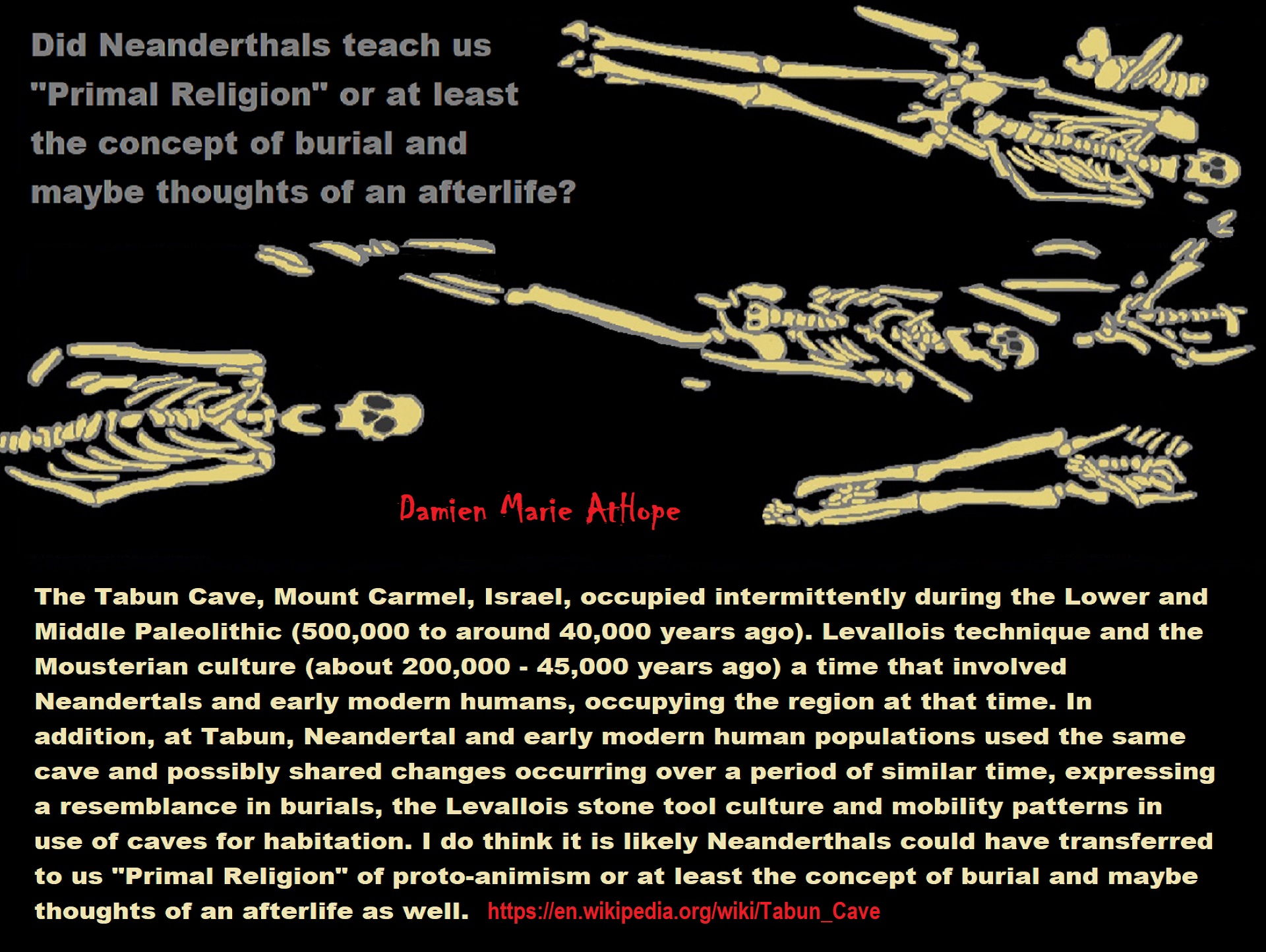
The Tabun Cave, Mount Carmel, Israel, occupied intermittently during the Lower and Middle Paleolithic (500,000 to around 40,000 years ago). Tabun suggests that ancestral humans used fire at the site on a regular basis since about 350,000 years ago and this likely would have shaped our culture and behavior. The material remains from the upper strata of the cave are of Levallois technique and the Mousterian culture (about 200,000 – 45,000 years ago). The Middle Palaeolithic of the southern Levant involved Neandertals and early modern humans, occupying the region at that time. Tabun Cave held fossil remains involved Neandertals and early modern humans but not an absolute chronology of the Levantine MP fossils though could indicates that an enamel fragment from the Tabun C1 could be as old as 143,000 years ago nearly double Tabun BC7. Moreover, a Neanderthal-type female, dated to about 120,000 years ago around the time early modern humans existed there which was between 120,000 – 90,000 years ago and again from 55,000 years ago on. ref, ref, ref, ref
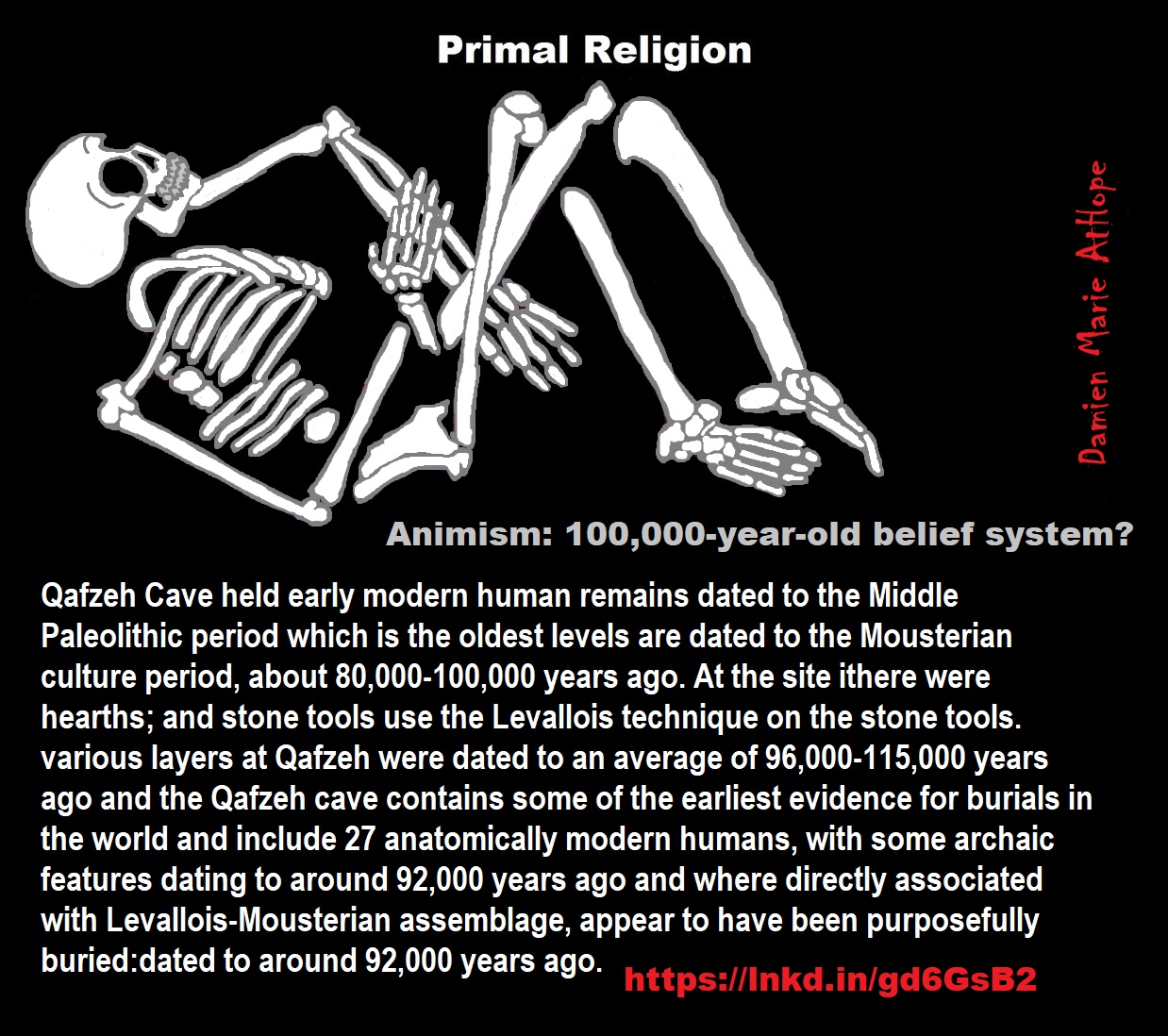
Animism: an approximately 100,000-year-old belief system?
Qafzeh Cave held early modern human remains dating to the Middle Paleolithic period which is the oldest levels are dated to the Mousterian culture period, about 80,000-100,000 years ago. At the site there were hearths; and stone tools use the Levallois technique on the stone tools. various layers at Qafzeh were dated to an average of 96,000-115,000 years ago and the Qafzeh cave contains some of the earliest evidence for burials in the world and included 27 anatomically modern humans, with some archaic features dating to around 92,000 years ago and were directly associated with Levallois-Mousterian assemblage, appear to have been purposefully buried: dated to around 92,000 years ago. The remains are from anatomically modern humans, with some archaic features; they are directly associated with Levallois-Mousterian assemblage. Modern behaviors indicated at the cave include the purposeful burials; the use of ochre for body painting; the presence of marine shells, used as ornamentation, and most interestingly, the survival and eventual ritual interment of a severely brain-damaged child. Moreover, deer antlers at Qafzeh 11 seem to be associated with burials unlike the marine shells which do not seem to be associated with burials, but rather are scattered more or less randomly throughout the site, possibly as a sacred offering, one that sanctifies an area? Or kind of blessing the aria? ref
Animism (such as that seen in Africa: 100,000 years ago)
- Animism: an approximately 100,000-year-old belief system?
- Rock crystal stone tools 75,000 Years Ago – (Spain) made by Neanderthals
- Stone Snake of South Africa: “first human worship” 70,000 years ago
- Similarities and differences in Animism and Totemism
- Did Neanderthals Help Inspire Totemism? Because there is Art Dating to Around 65,000 Years Ago in Spain?
- History of Drug Use with Religion or Sacred Rituals possibly 58,000 years ago?
Animism is approximately a 100,000-year-old belief system and believe in spirit-filled life and/or afterlife. If you believe like this, regardless of your faith, you are a hidden animist.
The following is evidence of Animism: 100,000 years ago, in Qafzeh, Israel, the oldest intentional burial had 15 African individuals covered in red ocher was from a group who visited and returned back to Africa. 100,000 to 74,000 years ago, at Border Cave in Africa, an intentional burial of an infant with red ochre and a shell ornament, which may have possible connections to the Africans buried in Qafzeh, Israel. 120,000 years ago, did Neanderthals teach us Primal Religion (Pre-Animism/Animism) as they too used red ocher and burials? ref, ref
It seems to me, it may be the Neanderthals who may have transmitted a “Primal Religion (Animism)” or at least burial and thoughts of an afterlife. The Neanderthals seem to express what could be perceived as a Primal “type of” Religion, which could have come first and is supported in how 250,000 years ago, the Neanderthals used red ochre and 230,000 years ago shows evidence of Neanderthal burial with grave goods and possibly a belief in the afterlife. ref
Do you think it is crazy that the Neanderthals may have transmitted a “Primal Religion”? Consider this, it appears that 175,000 years ago, the Neanderthals built mysterious underground circles with broken off stalactites. This evidence suggests that the Neanderthals were the first humans to intentionally bury the dead, doing so in shallow graves along with stone tools and animal bones. Exemplary sites include Shanidar in Iraq, Kebara Cave in Israel and Krapina in Croatia. Other evidence may suggest the Neanderthals had it transmitted to them by Homo heidelbergensis, 350,000 years ago, by their earliest burial in a shaft pit grave in a cave that had a pink stone axe on the top of 27 Homo heidelbergensis individuals and 250,000 years ago, Homo naledi had an intentional cemetery in South Africa cave. ref, ref, ref, ref, ref
- “120,000–90,000 years ago: Abbassia Pluvial in North Africa—the Sahara desert region is wet and fertile.
- 120,000 to 75,000 years ago: Khoisanid back-migration from Southern Africa to East Africa.
- 82,000 years ago: small perforated seashell beads from Taforalt in Morocco are the earliest evidence of personal adornment found anywhere in the world.
- 75,000 years ago: Toba Volcano supereruption that almost made humanity extinct. Populations could have been lowered to about 3000-1000 people on the Earth.
- 70,000 years ago: earliest example of abstract art or symbolic art from Blombos Cave, South Africa—stones engraved with grid or cross-hatch patterns.
- 70,000 years ago: Recent African origin: separation of sub-Saharan Africans and non-Africans.” ref
Did Neanderthals Help Inspire Totemism?
Because there is Art Dating to Around 65,000 Years Ago in Spain?
“What About Neanderthals and Religion”
Scientists have found the first major evidence that Neanderthals made cave paintings, indicating they may have had an artistic sense similar to our own. A new study led by the University of Southampton and the Max Planck Institute for Evolutionary Anthropology shows that paintings in three caves in Spain were created more than 64,000 years ago – 20,000 years before modern humans arrived in Europe. This means that the Palaeolithic (Ice Age) cave art – including pictures of animals, dots, and geometric signs – must have been made by Neanderthals, a ‘sister’ species to Homo sapiens, and Europe’s sole human inhabitants at the time. It also indicates that they may have had a similar artistic sense, in terms of thinking symbolically, to modern humans. Published today in the journal Science, the study reveals how an international team of scientists used a state-of-the-art technique called uranium-thorium dating to fix the age of the paintings as more than 64,000 years. Until now, cave art has been attributed entirely to modern humans, as claims to a possible Neanderthal origin have been hampered by imprecise dating techniques. However, uranium-thorium dating provides much more reliable results than methods such as radiocarbon dating, which can give false age estimates. Results show that the paintings we dated are, by far, the oldest known cave art in the world, and were created at least 20,000 years before modern humans arrived in Europe from Africa so it is assumed – therefore they may have been painted by Neanderthals. All three caves contain red (ochre) or black paintings of groups of animals, dots, and geometric signs, as well as hand stencils, handprints, and engravings. According to the researchers, creating the art must have involved such sophisticated behavior as the choice of a location, planning of light source and mixing of pigments. There is evidence that Neanderthals in Europe used body ornamentation around 40,000 to 45,000 years ago, but many researchers have suggested this was inspired by modern humans who at the time had just arrived in Europe. Study co-author Paul Pettitt, of Durham University, commented: “Neanderthals created meaningful symbols in meaningful places. The art is not a one-off accident. ref
Neanderthals are our closest extinct relative, but for a long time, they had a reputation for being pretty backward. Early modern humans, for example, made cave paintings. But even though Neanderthals used pigments and decorated themselves with eagle claws and shells, there was no clear proof that they painted caves. One theory goes that Neanderthals developed their rudimentary culture only after early modern humans arrived in Europe some 40,000 to 50,000 years ago. The most recent painting is at least 64,800 years old, according to this technique, and the oldest is more than 66,000 years old. ref
The Neanderthal was the only proven Human of Europe at the time, but was his or her brain up to the job? Or did modern humans reach Europe tens of thousands of years earlier than thought? The ancient art forms are symbolic but not figurative, explain their finders. In Spain, a cave in Maltravieso features hand stencils more than 66,000 years old, Prof. Dirk Hoffmann of the Max Planck Institute for Evolutionary Anthropology and others report in their paper, published Thursday in Science. The La Pasiega Cave in Cantabria features a ladder form composed of red horizontal and vertical lines that were created more than 64,000 years ago, they say. Further supporting the Neanderthal-as-artist theory, a related paper published Thursday in Science Advances reports that dyed and decorated seashells found in a Spanish cave dated to more than 115,000 years ago. Perforated shells found in sediments in Cueva de los Aviones that date to between 115,000 and 120,000 years. There’s no argument that there were Neanderthals in Europe 64,000 years ago. Homo sapiens, on the other hand, was thought to have reached Europe only 45,000 to 40,000 years ago. There is no evidence for modern humans in Iberia before 41,000 years ago, and there is evidence for Neanderthal presence until about 36,000 years ago in southern Spain and Portugal. Neanderthals existed for twice the time modern people have, if not more, and were once the dominant hominin in Europe. While Neanderthals may have etched a crisscross and perhaps carved a flute, look what Homo sapiens achieved, Coolidge says. The Paleolithic record is replete with exquisite works, from cave paintings to carvings done tens of thousands of years ago – such as the Lion Man sculpture found in a German cave and made of mammoth ivory some 38,000 years ago. ref
Neanderthal ritual or religious practice at around 50,000 years old burial in Sima de las Palomas in Murcia, Southeast Spain of a female covered with rocks inturned with a cut off panther paw, suggesting that Neanderthals—much like today’s bear hunters—ceremoniously cut off panther paws and kept them as totemistic trophies. This 50,000-year-old Neanderthal burial ground actually includes the remains of at least three individuals intentionally buried, with each Neanderthal’s arms folded such that the hands were close to the head. Remains of other Neanderthals have been found in this position, suggesting that it held meaning. The remains of six to seven other Neanderthals, including one baby and two juveniles, have also been excavated at the site. The tallest individual appears to have been an adult who stood around 5 feet 1 inch tall. ref, ref
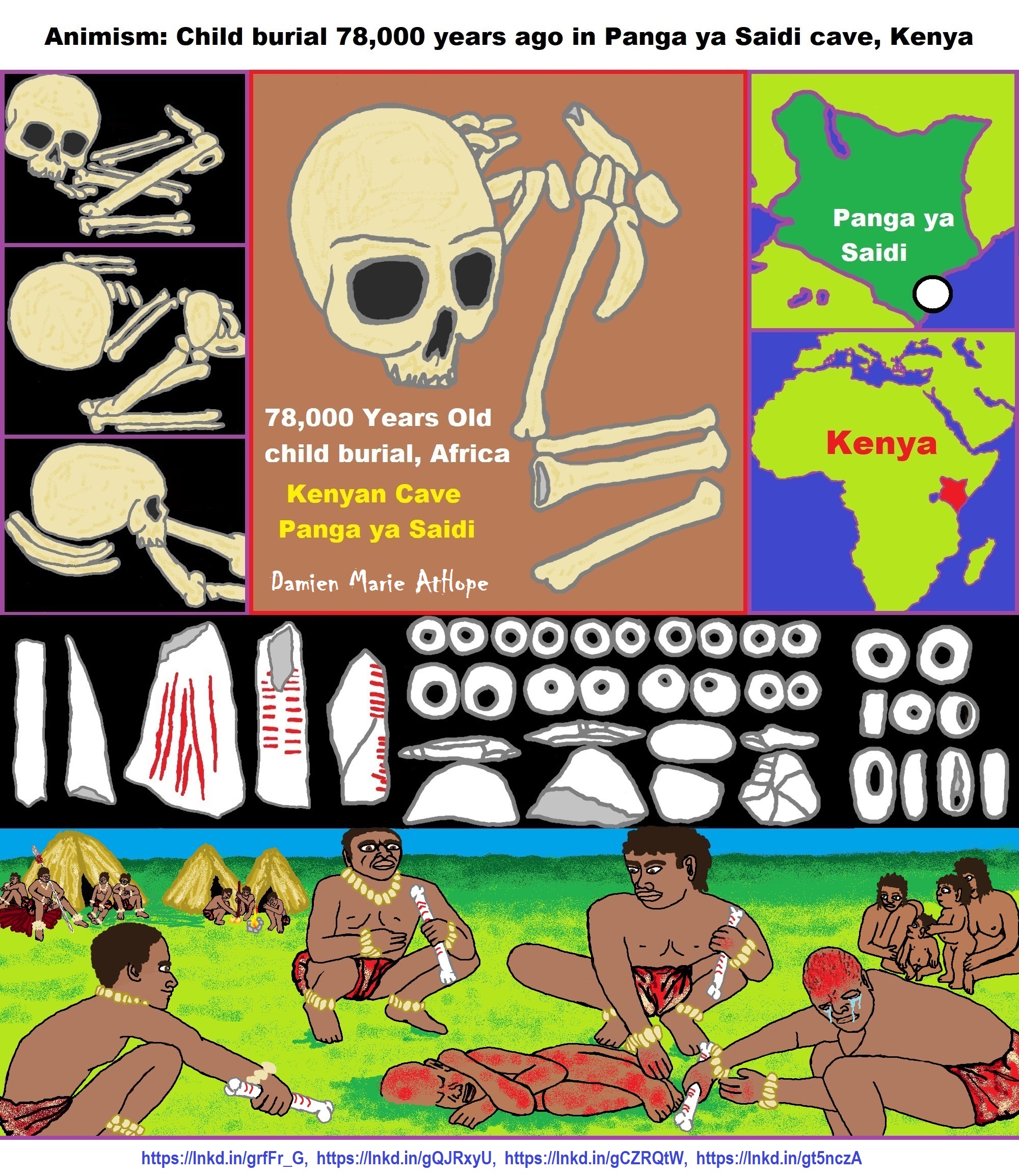
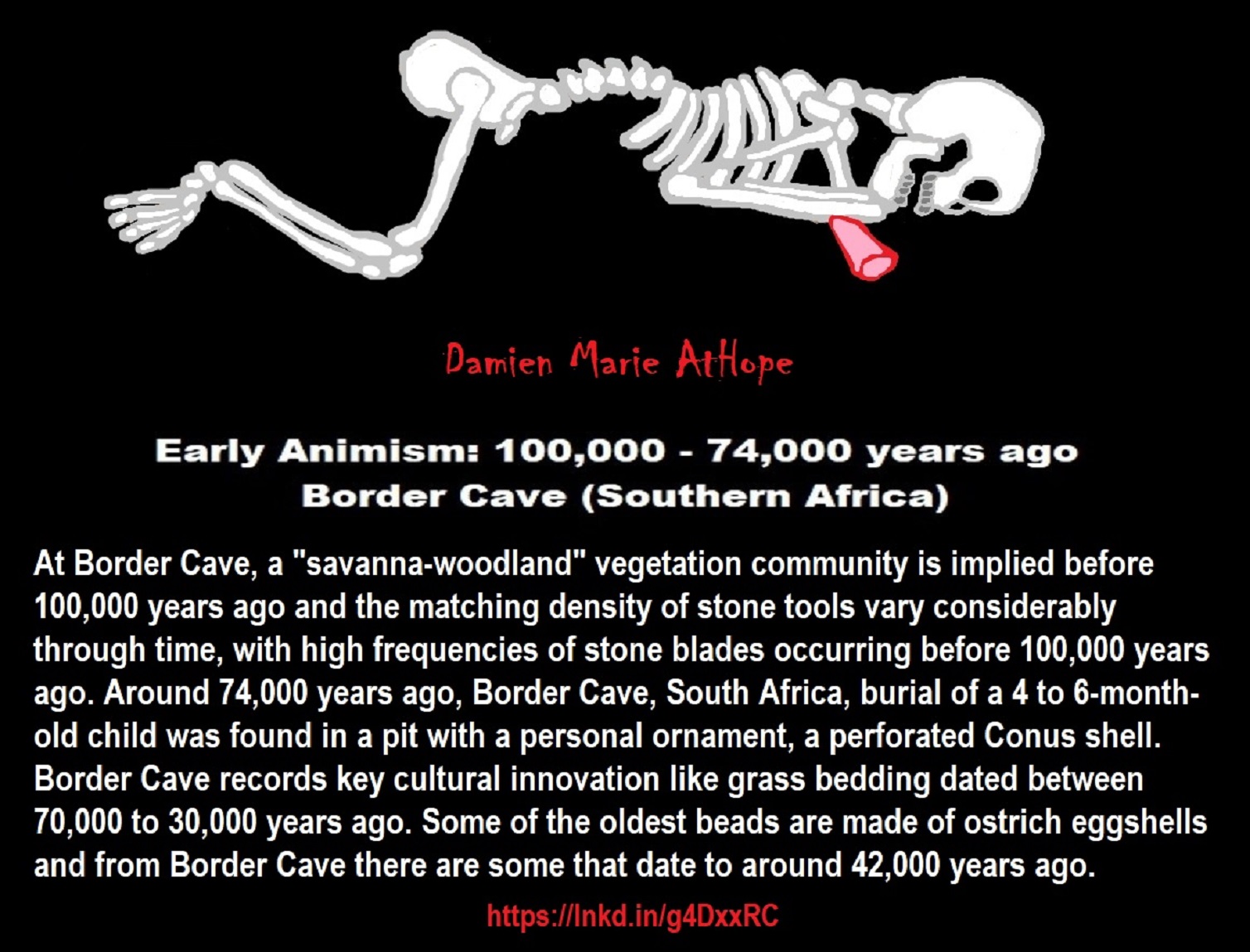
At Border Cave, a “savanna-woodland” vegetation community is implied before 100,000 years ago and the matching density of stone tools vary considerably through time, with high frequencies of stone blades occurring before 100,000 years ago. ref
Around 74,000 years ago, in Border Cave, South Africa, the burial of a 4 to 6-month-old child was found in a pit with a personal ornament, a perforated Conus shell. ref
Border Cave is the only African site covering a time span of 250,000 years, with Middle Stone Age human remains, and also records the first emergence of key cultural innovations such as things like grass bedding dated between 70,000 to 30,000 years ago. ref
In South Africa, some of the oldest beads are made of marine shells that come from the Still Bay layers of Blombos Cave dating back to around 72,000 years ago, and engraved ostrich eggshells dated to around 60,000 years ago from Diepkloof in South Africa. Some of the oldest beads made of non-marine shells involve ostrich eggshells and from Border Cave, there are some that date to around 42,000 years ago. Beads were also collected from the late MSA/early LSA context of similar age at Apollo 11 and from layers associated with MSA at Boomplaas Cave. Furthermore, beads were also reported from the MSA at Cave of Hearths. Other sub-contemporaneous beads have been recovered north of South Africa. ref
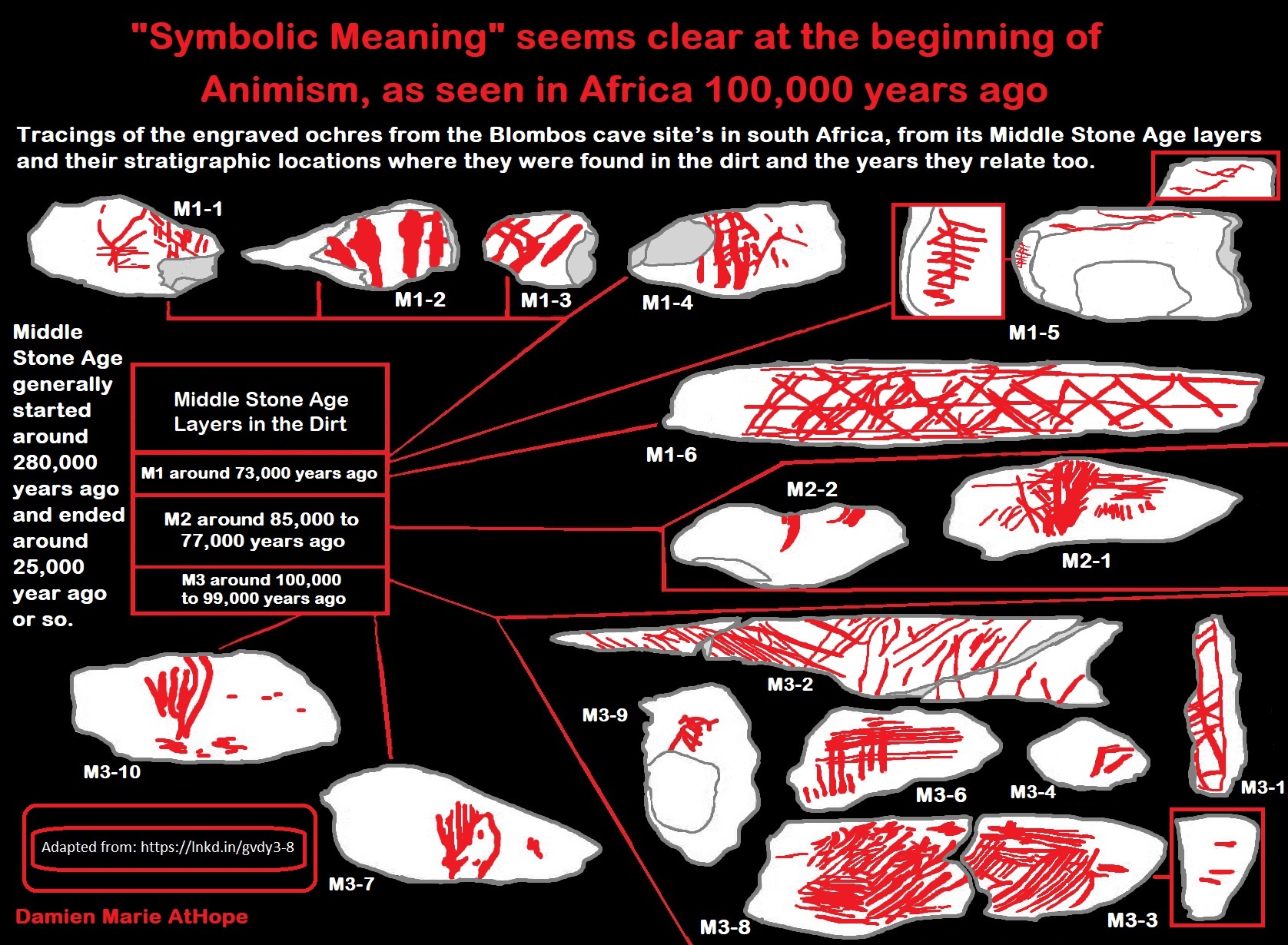
Adapted from: ref
Here we see the tracings of the engraved ochres from the Blombos cave site’s in South Africa, from its Middle Stone Age layers and their stratigraphic locations where they were found in the dirt and the years they relate to. M1 dates to around 73,000 years ago, M2 around 85,000 to 77,000 years ago, and M3 dates to around 100,000 to 99,000 years ago. Middle Stone Age generally started around 280,000 years ago and ended around 25,000 years ago or so. Therefore, amazing as it is, here we have proof that “Symbolic Meaning,” seems to be clear at the beginning of Animism, as seen in Africa 100,000 years ago. In a landmark study, it was demonstrated, for the first time, that there are seeming tradition in the production of geometric engraved representations, includes the production of a number of different patterns and this set of evolving traditions have roots that go back in time to at least 100,000 years ago (around a time I say Animism begins in Africa). The fact that they were created, that most of them are deliberate and were made with representational intent, strongly suggests they functioned as artifacts within a society by symbols with meaning. ref
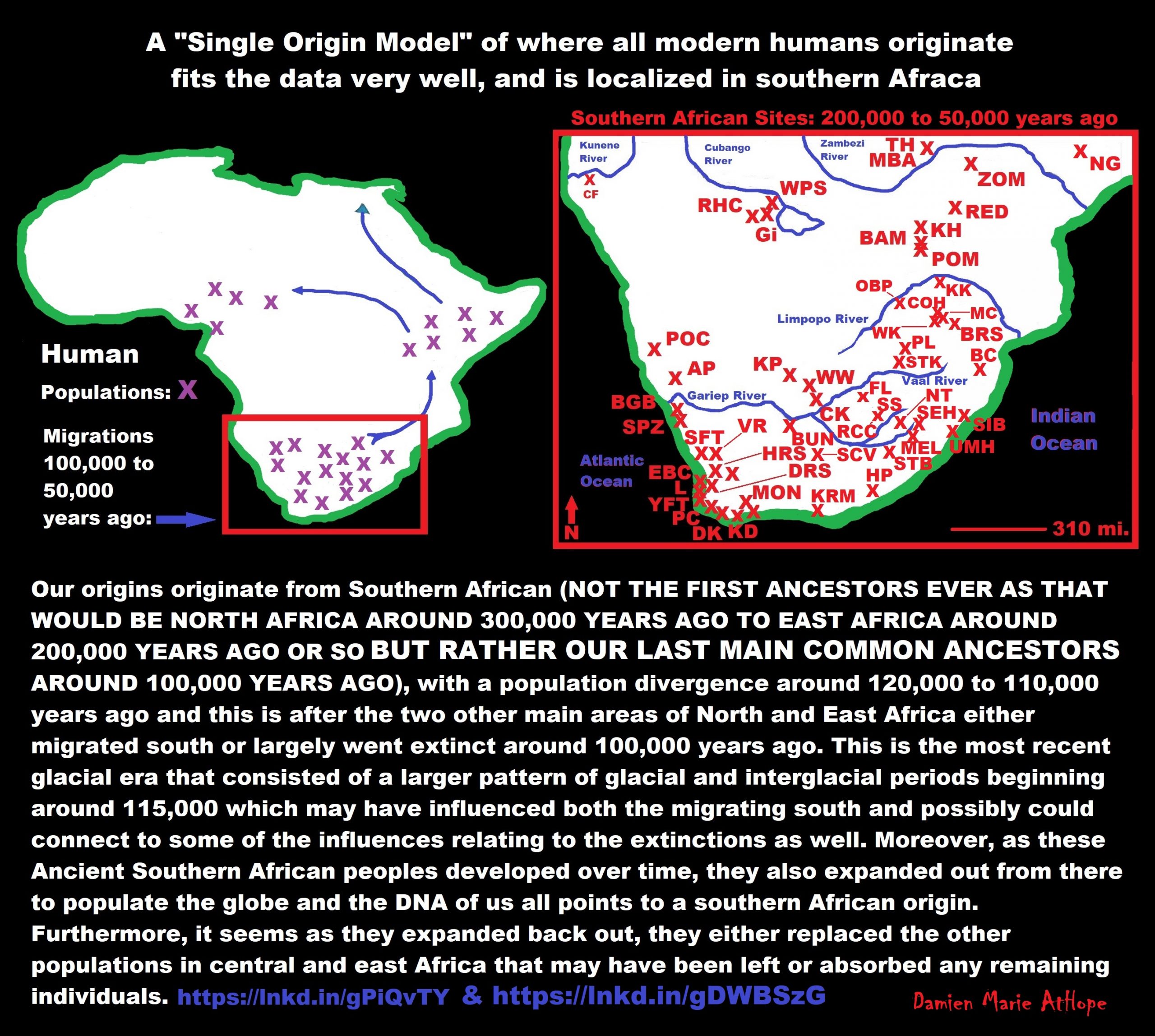
Our origins originate from Southern African (NOT THE FIRST ANCESTORS EVER AS THAT WOULD BE NORTH AFRICA AROUND 300,000 YEARS AGO TO EAST AFRICA AROUND 200,000 YEARS AGO OR SO BUT RATHER OUR LAST MAIN COMMON ANCESTORS AROUND 100,000 YEARS AGO), with a population divergence around 120,000 to 110,000 years ago and this is after the two other main areas of North and East Africa either migrated south or largely went extinct around 100,000 years ago. This is the most recent glacial era that consisted of a larger pattern of glacial and interglacial periods beginning around 115,000 which may have influenced both the migrating south and possibly could connect to some of the influences relating to the extinctions as well. Moreover, as these Ancient Southern African peoples developed over time, they also expanded out from there to populate the globe and the DNA of us all points to a southern African origin. Furthermore, it seems as they expanded back out, they either replaced the other populations in central and east Africa that may have been left or absorbed any remaining individuals. ref
Southern African Middle Stone Age sites:
(Ap) Apollo 11; (BAM) Bambata; (BBC) Blombos Cave; (BC) Border Cave; (BGB)Boegoeberg; (BPA) Boomplaas; (BRS) Bushman Rock Shelter; (BUN) Bundu Farm; (CF)Cufema Reach; (CK) Canteen Kopje; (COH) Cave of Hearths; (CSB) Cape St Blaize; (DK)Die Kelders Cave 1; (DRS) Diepkloof Rock Shelter; (EBC) Elands Bay Cave; (FL) Florisbad; (≠GI) ≠Gi; (HP) Howiesons Poort; (HRS) Hollow Rock Shelter; (KD) Klipdrift; (KKH) Klein Kliphuis; (KH) Khami; (KK) Kudu Koppie; (KP) Kathu Pan; (KRM) Klasies River Main Site; (L) Langebaan; (MBA) Mumbwa Caves; (MC) Mwulu’s Cave; (MEL)Melikane; (MON) Montagu Cave; (NBC) Nelson Bay Cave; (NG) Ngalue; (NT) Ntloana Tšoana; (OBP) Olieboomspoort; (PC) Peers Cave; (POC) Pockenbank; (PL) Plover’s Lake; (POM) Pomongwe; (PP) Pinnacle Point; (RCC) Rose Cottage Cave; (RED) Redcliff; (RHC) Rhino Cave; (SCV) Seacow Valley; (SFT) Soutfontein; (SEH) Sehonghong; (SIB)Sibudu Cave; (SPZ) Spitzkloof Rock Shelter; (SS) Sunnyside 1; (STB) Strathalan Cave B; (STK) Sterkfontein; (TR) Twin Rivers; (UMH) Umhlatuzana; (VR) Varsche Rivier 003; (WPS) White Paintings Shelter; (WK) Wonderkrater; (WW) Wonderwerk; (YFT)Ysterfontein 1; (ZOM) Zombepata Cave. ref

ref, ref, ref, ref, ref, ref, ref, ref, ref, ref, ref, ref, ref, ref, ref, ref, ref, ref, ref, ref, ref, ref, ref, ref, ref, ref, ref, ref, ref, ref, ref, ref, ref, ref, ref, ref, ref, ref, ref, ref, ref, ref, ref, ref, ref, ref, ref, ref, ref, ref, ref, ref
Animism: a belief among some indigenous people, young children, or all religious people!
Over 100,000 years ago or so, Southern Africa, in the Land before and the beginning Time of Animism: LINK
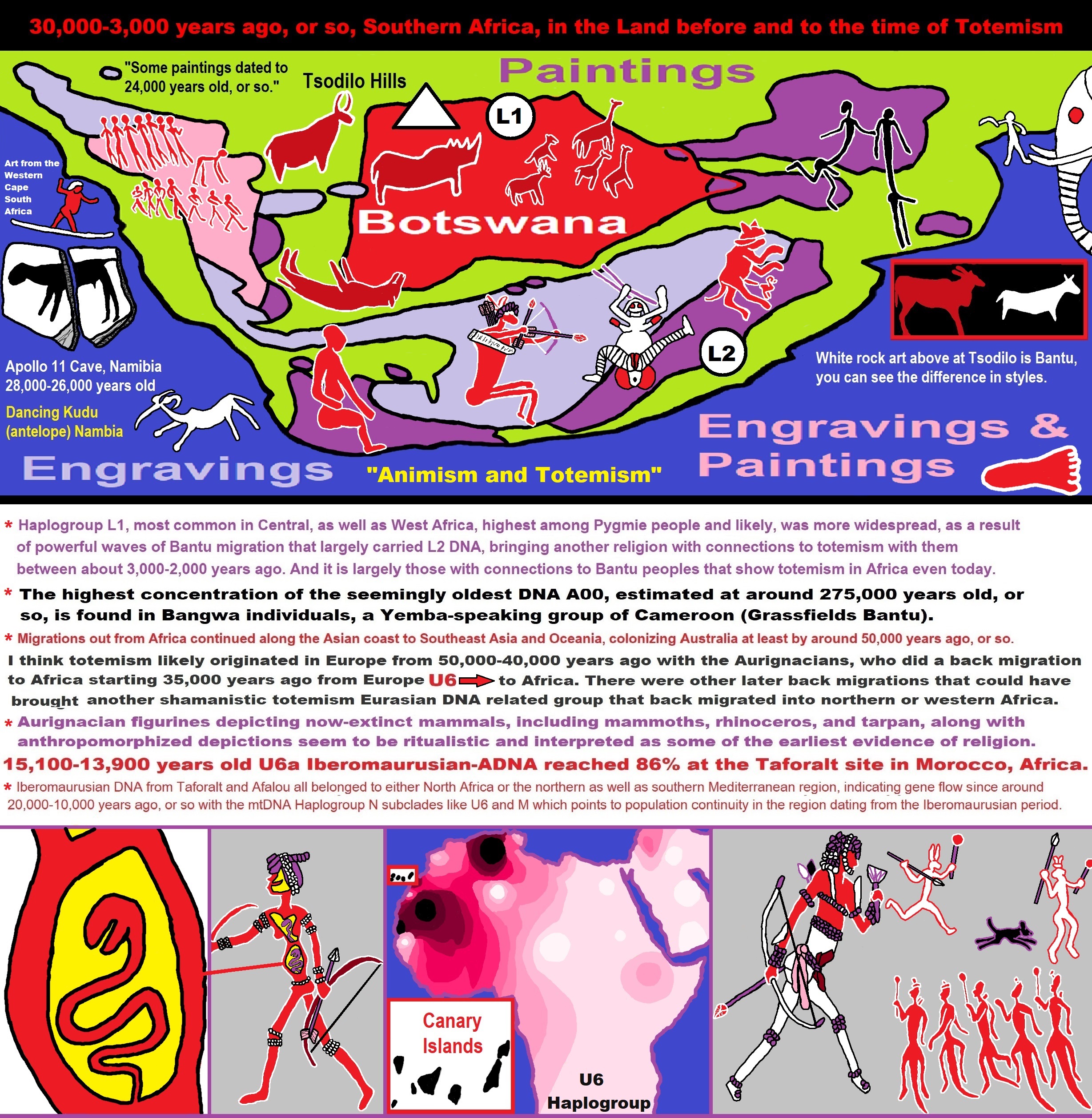
ref, ref, ref, ref, ref, ref, ref, ref, ref, ref, ref, ref, ref, ref, ref, ref, ref, ref, ref, ref, ref, ref, ref, ref, ref, ref, ref, ref, ref, ref, ref, ref, ref, ref, ref, ref, ref, ref, ref, ref, ref, ref, ref, ref, ref, ref, ref, ref, ref, ref, ref, ref, ref, ref, ref, ref, ref, ref, ref, ref,
Explaining the Earliest Religious Expression, that of Animism (beginning 100,000 to 70,000 years ago?) to Totemism (beginning 30,000 to 3,000 years ago?) in Southern Africa: LINK
Animism: an approximately 100,000-year-old belief system?
Animism (from Latin anima, “breath, spirit, life”) is the religious belief that objects, places, and creatures all possess a distinct spiritual essence. Potentially, animism perceives all things—animals, plants, rocks, rivers, weather systems, human handiwork and perhaps even words—as animated and alive. Animism is the oldest known type of belief system in the world that even predates paganism. It is still practiced in a variety of forms in many traditional societies. Animism is used in the anthropology of religion as a term for the belief system of many indigenous tribal peoples, especially in contrast to the relatively more recent development of organized religions. Although each culture has its own different mythologies and rituals, “animism” is said to describe the most common, foundational thread of indigenous peoples’ “spiritual” or “supernatural” perspectives. The animistic perspective is so widely held and inherent to most animistic indigenous peoples that they often do not even have a word in their languages that corresponds to “animism” (or even “religion”); the term is an anthropological construct. ref
* “animist” Believe in spirit-filled life and/or afterlife (you are a hidden animist/Animism : an approximately 100,000-year-old belief system Qafzeh: Oldest Intentional Burial of 15 individuals with red ocher and Border Cave: intentional burial of an infant with red ochre and a shell ornament (possibly extending to or from Did Neanderthals teach us “Primal Religion (Animism?)” 120,000 Years Ago, as they too used red ocher? well it seems to me it may be Neanderthals who may have transmitted a “Primal Religion (Animism?)” or at least burial and thoughts of an afterlife they seem to express what could be perceived as a Primal “type of” Religion, which could have come first is supported in how 250,000 years ago Neanderthals used red ochre and 230,000 years ago shows evidence of Neanderthal burial with grave goods and possibly a belief in the afterlife. Think the idea that Neanderthals who may have transmitted a “Primal Religion” as crazy then consider this, it appears that Neanderthals built mystery underground circles 175,000 years ago. Evidence suggests that the Neanderthals were the first humans to intentionally bury the dead, doing so in shallow graves along with stone tools and animal bones. Exemplary sites include Shanidar in Iraq, Kebara Cave in Israel and Krapina in Croatia. Or maybe Neanderthals had it transmitted to them Evidence of earliest burial: a 350,000-year-old pink stone axe with 27 Homo heidelbergensis. As well as the fact that the oldest Stone Age Art dates to around 500,000 to 233,000 Years Old and it could be of a female possibly with magical believed qualities or representing something that was believed to)
Understanding Religion Evolution
My thoughts on Religion Progression
- Animism (a belief in a perceived spirit world) passably by at least 100,000 years ago “the primal stage of early religion”
- Totemism (a belief that these perceived spirits could be managed with created physical expressions) passably by at least 50,000 years ago “progressed stage of early religion”
- Shamanism (a belief that some special person can commune with these perceived spirits on the behalf of others by way rituals) passably by at least 30,000 years ago
- Paganism “Early organized nature-based religion” mainly like an evolved shamanism with gods (passably by at least 12,000 years ago).
- Institutional religion “organized religion” as a social institution with official dogma usually set in a hierarchical/bureaucratic structure that contains strict rules and practices dominating the believer’s life.
Pre-Animism: Portable Rock Art
Did Neanderthals teach us “Primal Religion (Pre-Animism/Animism?)” 120,000 Years Ago?
Yes, you need to know about Animism to understand Religion
“Religion is an Evolved Product”
If you are a religious believer, may I remind you that faith in the acquisition of knowledge is not a valid method worth believing in. Because, what proof is “faith”, of anything religion claims by faith, as many people have different faith even in the same religion?
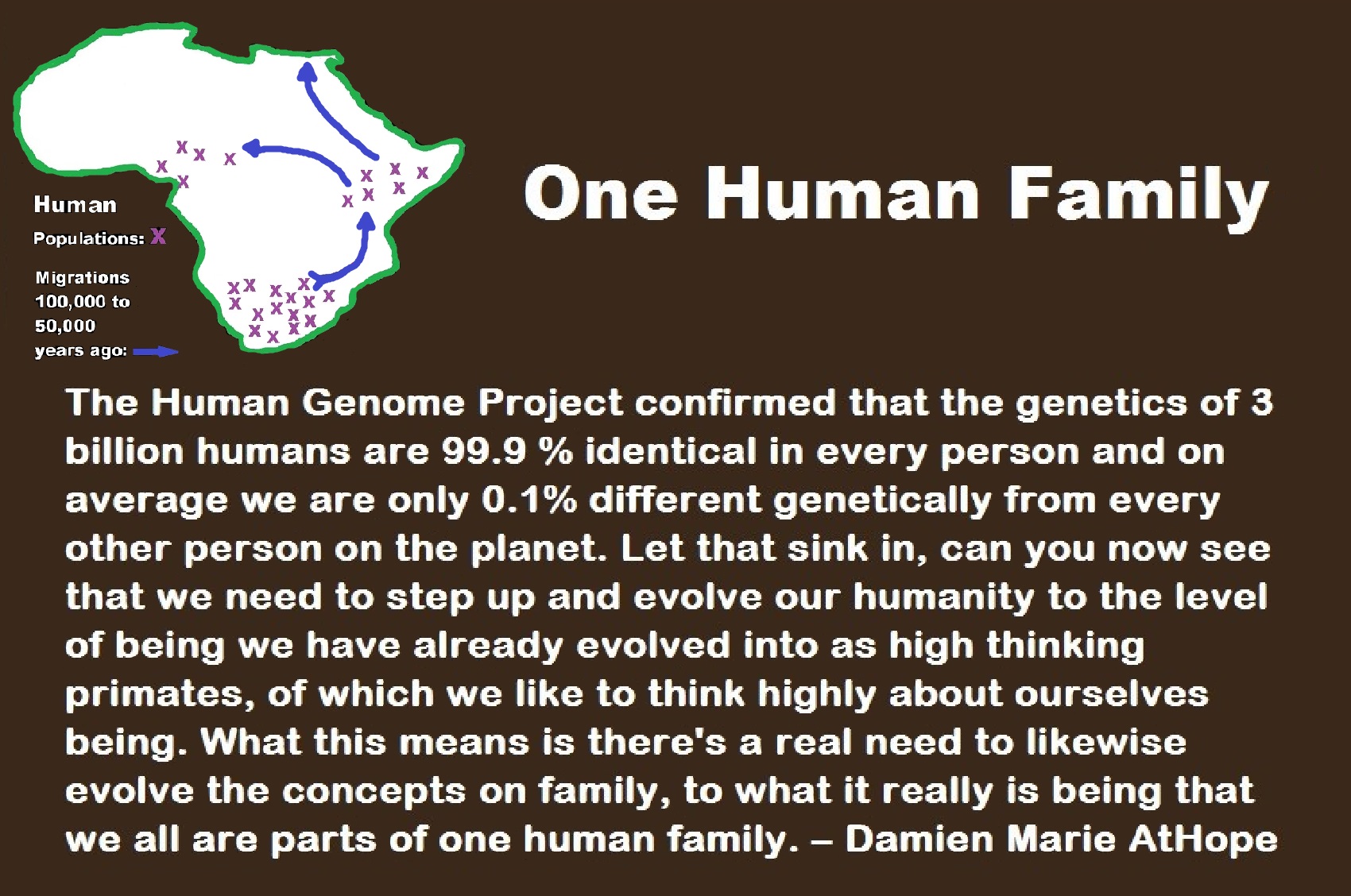
“When researchers completed the final analysis of the Human Genome Project in April 2003, they confirmed that the 3 billion base pairs of genetic letters in humans were 99.9 percent identical in every person. It also meant that individuals are, on average, 0.1 percent different genetically from every other person on the planet. And in that 0.1 percent lies the mystery of why some people are more susceptible to a particular illness or more likely to be healthy than their neighbor – or even another family member.” ref
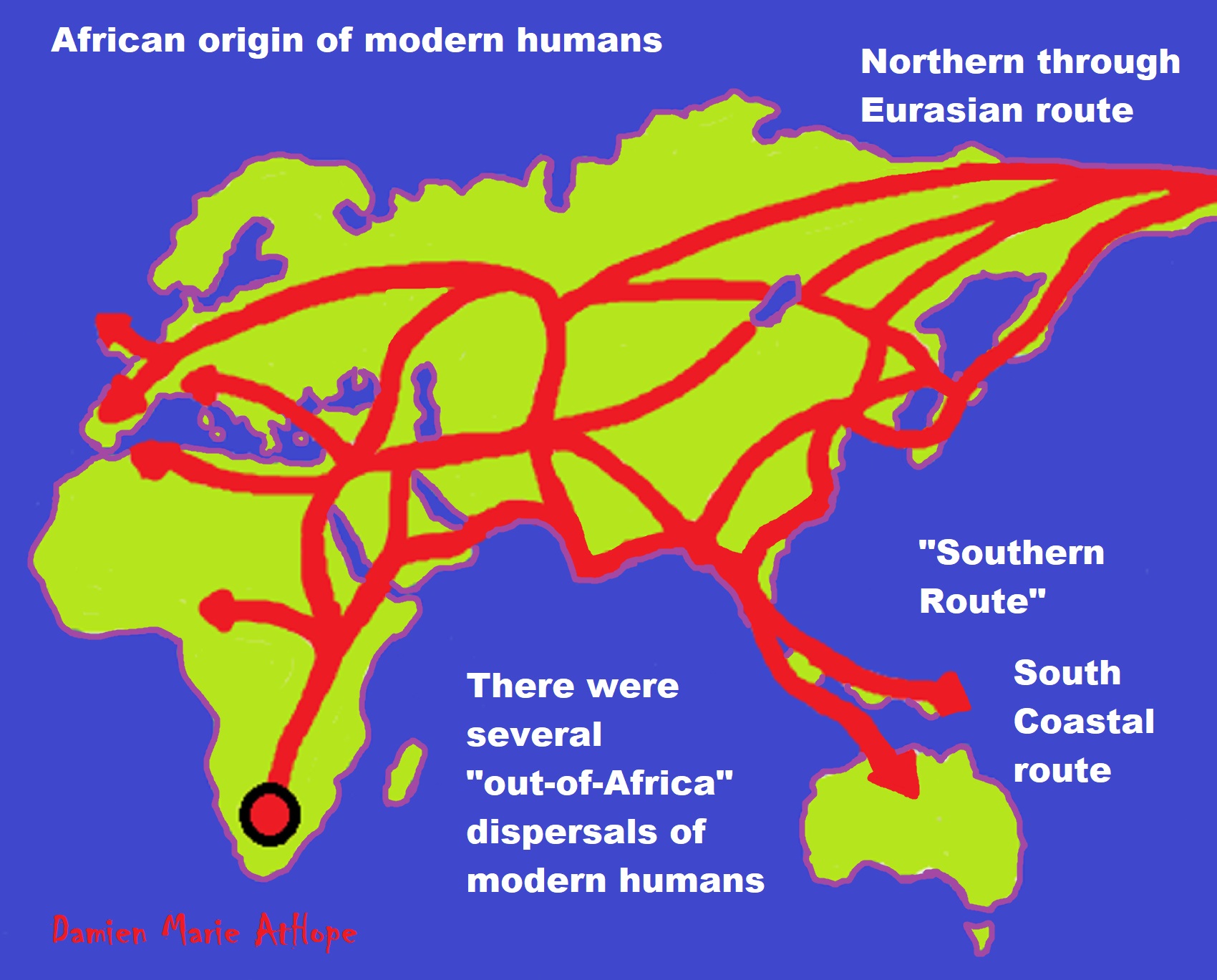
ref, ref, ref, ref, ref, ref, ref, ref
“There are two geographically plausible routes that have been proposed for humans to emerge from Africa: through the current Egypt and Sinai (Northern Route), or through Ethiopia, the Bab el Mandeb strait, and the Arabian Peninsula (Southern Route).” ref
“Although there is a general consensus on the African origin of early modern humans, there is disagreement about how and when they dispersed to Eurasia. This paper reviews genetic and Middle Stone Age/Middle Paleolithic archaeological literature from northeast Africa, Arabia, and the Levant to assess the timing and geographic backgrounds of Upper Pleistocene human colonization of Eurasia. At the center of the discussion lies the question of whether eastern Africa alone was the source of Upper Pleistocene human dispersals into Eurasia or were there other loci of human expansions outside of Africa? The reviewed literature hints at two modes of early modern human colonization of Eurasia in the Upper Pleistocene: (i) from multiple Homo sapiens source populations that had entered Arabia, South Asia, and the Levant prior to and soon after the onset of the Last Interglacial (MIS-5), (ii) from a rapid dispersal out of East Africa via the Southern Route (across the Red Sea basin), dating to ~74,000-60,000 years ago.” ref
“Within Africa, Homo sapiens dispersed around the time of its speciation, roughly 300,000 years ago. The so-called “recent dispersal” of modern humans took place about 70–50,000 years ago. It is this migration wave that led to the lasting spread of modern humans throughout the world. The coastal migration between roughly 70,000 and 50,000 years ago is associated with mitochondrial haplogroups M and N, both derivative of L3. Europe was populated by an early offshoot that settled the Near East and Europe less than 55,000 years ago. Modern humans spread across Europe about 40,000 years ago, possibly as early as 43,000 years ago, rapidly replacing the Neanderthal population.” ref, ref
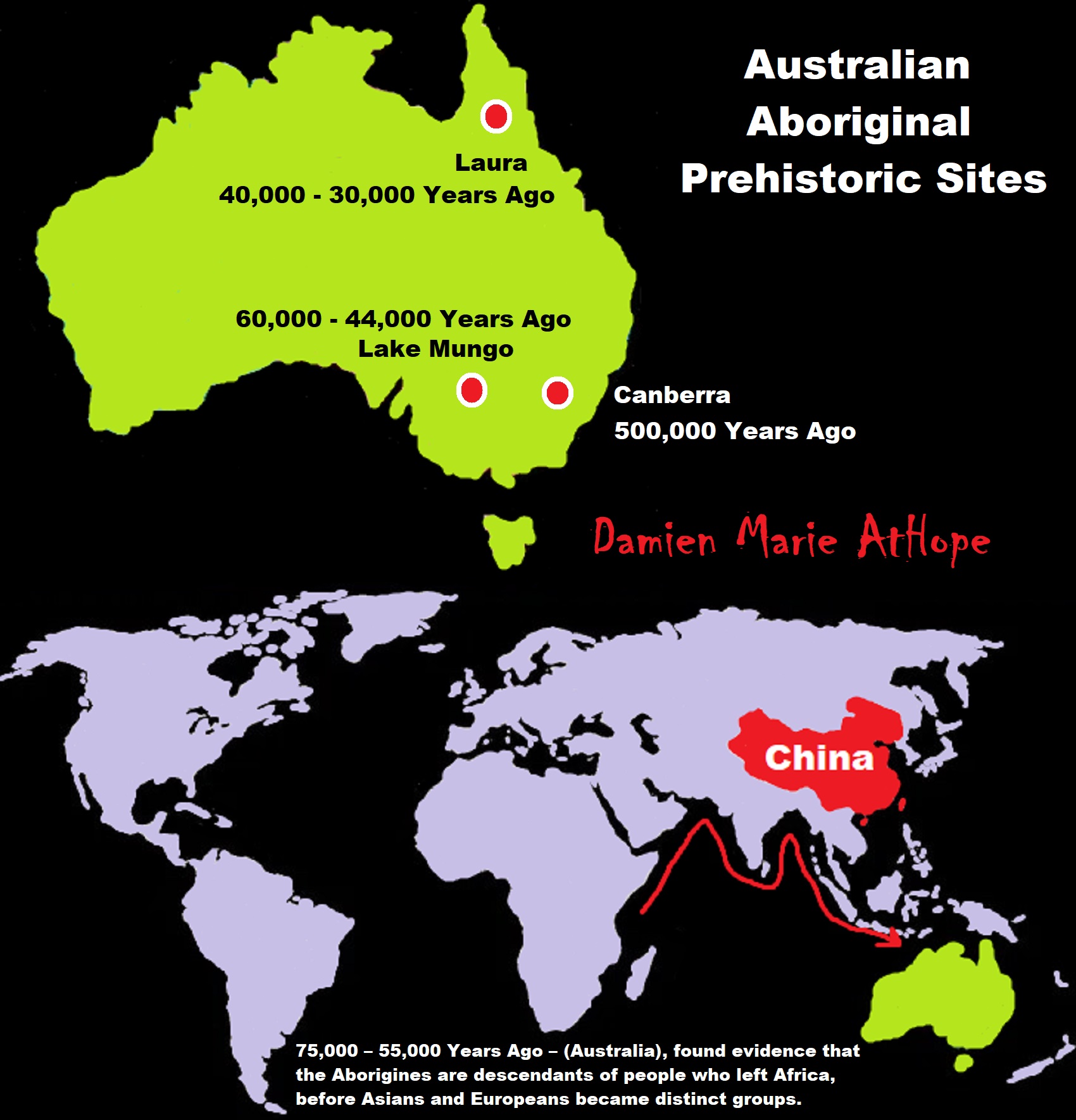
ref, ref, ref, ref, ref, ref, ref, ref, ref, ref, ref, ref
“There were at least several “out-of-Africa” dispersals of modern humans, possibly beginning as early as 270,000 years ago, including 215,000 years ago to at least Greece, and certainly via northern Africa and the Arabian Peninsula about 130,000 to 115,000 years ago. These early waves appear to have mostly died out or retreated by 80,000 years ago.” ref
“The most significant “recent” wave out of Africa took place about 70,000–50,000 years ago, via the so-called “Southern Route“, spreading rapidly along the coast of Asia and reaching Australia by around 65,000–50,000 years ago, (though some researchers question the earlier Australian dates and place the arrival of humans there at 50,000 years ago at earliest, while others have suggested that these first settlers of Australia may represent an older wave before the more significant out of Africa migration and thus not necessarily be ancestral to the region’s later inhabitants) while Europe was populated by an early offshoot which settled the Near East and Europe less than 55,000 years ago.” ref
- “An Eastward Dispersal from Northeast Africa to Arabia 150,000–130,000 years ago based on the finds at Jebel Faya dated to 127,000 years ago (discovered in 2011). Possibly related to this wave are the finds from Zhirendong cave, Southern China, dated to more than 100,000 years ago. Other evidence of modern human presence in China has been dated to 80,000 years ago.” ref
- “The most significant out of Africa dispersal took place around 50–70,000 years ago via the so-called Southern Route, either before or after the Toba event, which happened between 69,000 and 77,000 years ago. This dispersal followed the southern coastline of Asia, and reached Australia around 65,000-50,000 years ago, or according to some research, by 50,000 years ago at earliest. Western Asia was “re-occupied” by a different derivation from this wave around 50,000 years ago, and Europe was populated from Western Asia beginning around 43,000 years ago.” ref
- “Wells (2003) describes an additional wave of migration after the southern coastal route, namely a northern migration into Europe at circa 45,000 years ago. However, this possibility is ruled out by Macaulay et al. (2005) and Posth et al. (2016), who argue for a single coastal dispersal, with an early offshoot into Europe.” ref
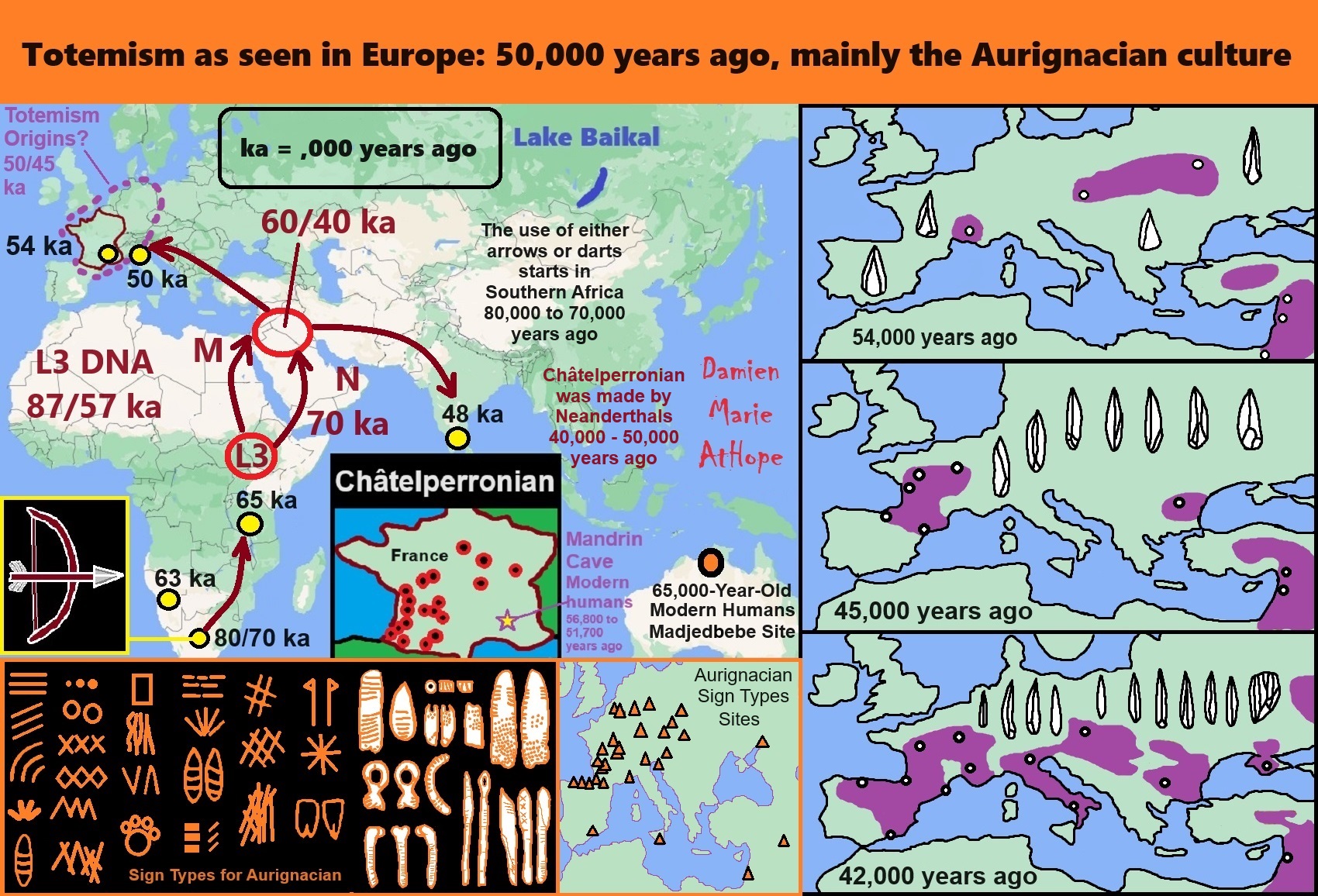
ref, ref, ref, ref, ref, ref, ref, ref, ref, ref, ref, ref, ref, ref, ref, ref, ref, ref, ref, ref, ref, ref, ref
This is my thoughts/speculations on the origins of Totemism
Totemism as seen in Europe: 50,000 years ago, mainly the Aurignacian culture
- Pre-Aurignacian “Châtelperronian” (Western Europe, mainly Spain and France, possible transitional/cultural diffusion between Neanderthals and humans around 50,000-40,000 years ago)
- Archaic–Aurignacian/Proto-Aurignacian (Europe around 46,000-35,000)
- Aurignacian “classical/early to late” (Europe and other areas around 38,000 – 26,000 years ago)
“In the realm of culture, the archeological evidence also supports a Neandertal contribution to Europe’s earliest modern human societies, which feature personal ornaments completely unknown before immigration and are characteristic of such Neandertal-associated archeological entities as the Chatelperronian and the Uluzzian.” – (PDF) Neandertals and Moderns Mixed, and It Matters: Link
Totemism as seen in Europe: 50,000 years ago, mainly the Aurignacian culture
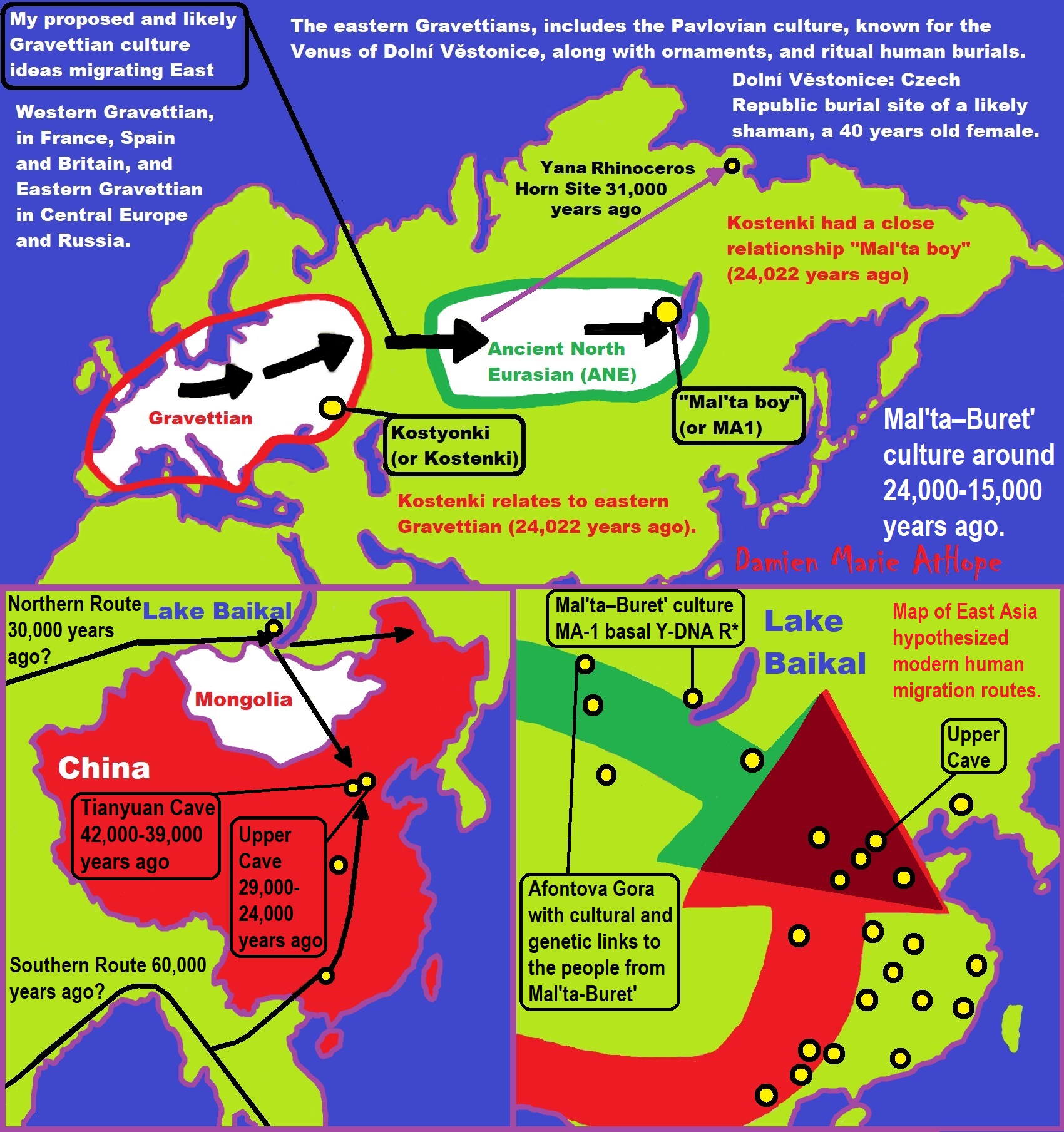
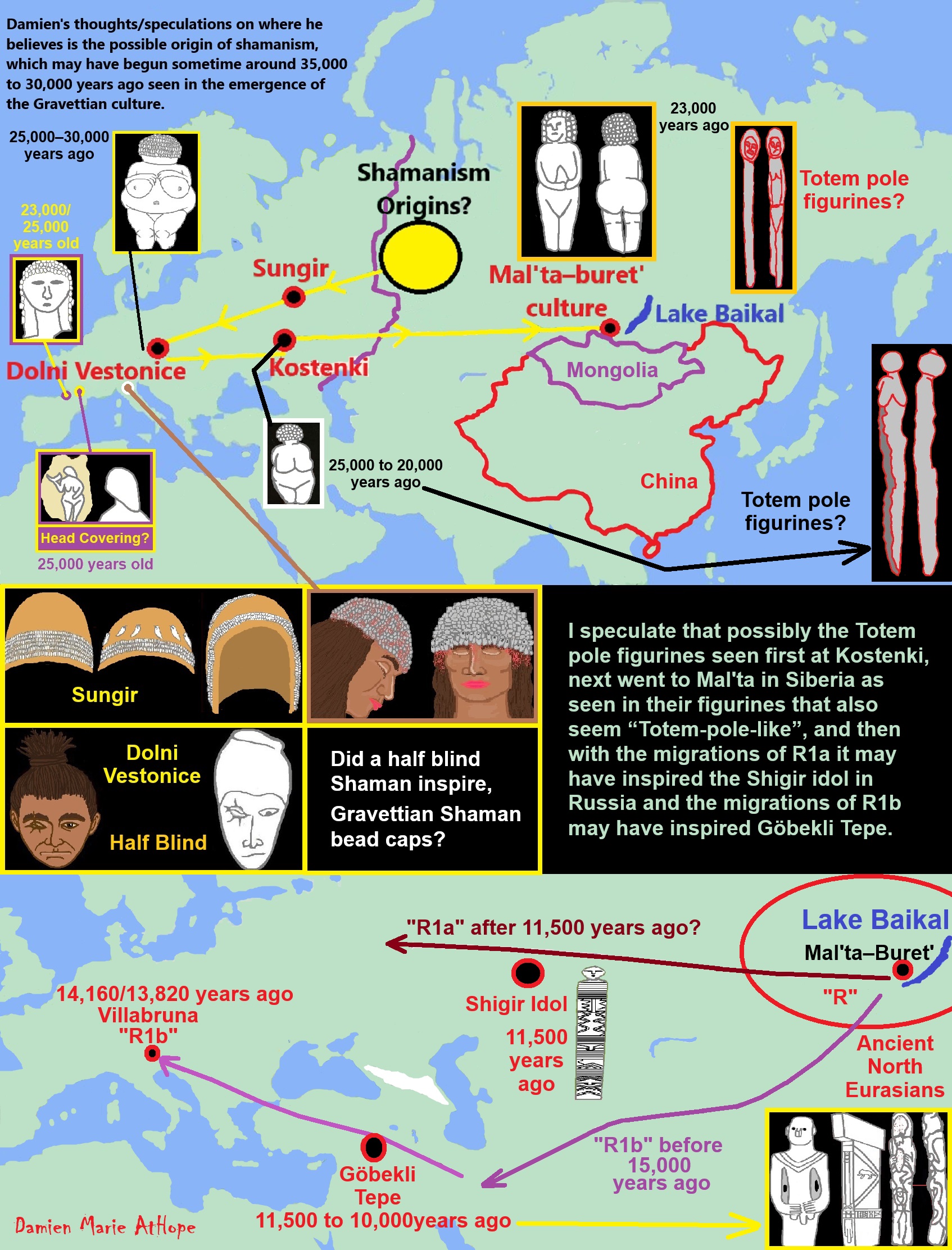
ref, ref, ref, ref, ref, ref, ref, ref, ref, ref, ref, ref, ref, ref, ref, ref, ref, ref, ref
Here are my thoughts/speculations on where I believe is the possible origin of shamanism, which may have begun sometime around 35,000 to 30,000 years ago seen in the emergence of the Gravettian culture, just to outline his thinking, on what thousands of years later led to evolved Asian shamanism, in general, and thus WU shamanism as well. In both Europe-related “shamanism-possible burials” and in Gravettian mitochondrial DNA is a seeming connection to Haplogroup U. And the first believed Shaman proposed burial belonged to Eastern Gravettians/Pavlovian culture at Dolní Věstonice in southern Moravia in the Czech Republic, which is the oldest permanent human settlement that has ever been found. It is at Dolní Věstonice where approximately 27,000-25,000 years ago a seeming female shaman was buried and also there was an ivory totem portrait figure, seemingly of her.
And my thoughts on how cultural/ritual aspects were influenced in the area of Göbekli Tepe. I think it relates to a few different cultures starting in the area before the Neolithic. Two different groups of Siberians first from northwest Siberia with U6 haplogroup 40,000 to 30,000 or so. Then R Haplogroup (mainly haplogroup R1b but also some possible R1a both related to the Ancient North Eurasians). This second group added its “R1b” DNA of around 50% to the two cultures Natufian and Trialetian. To me, it is likely both of these cultures helped create Göbekli Tepe. Then I think the female art or graffiti seen at Göbekli Tepe to me possibly relates to the Epigravettians that made it into Turkey and have similar art in North Italy. I speculate that possibly the Totem pole figurines seen first at Kostenki, next went to Mal’ta in Siberia as seen in their figurines that also seem “Totem-pole-like”, and then with the migrations of R1a it may have inspired the Shigir idol in Russia and the migrations of R1b may have inspired Göbekli Tepe.
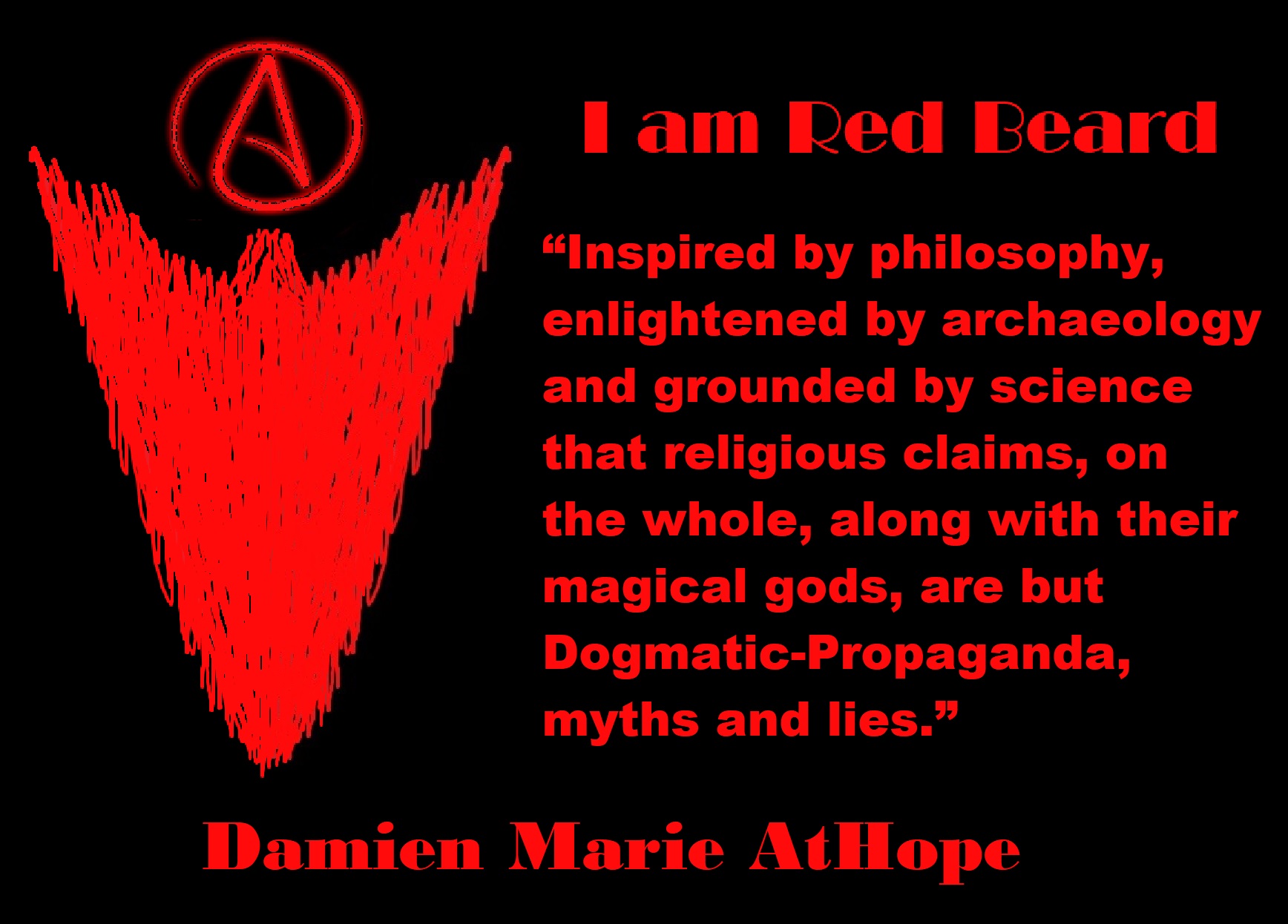
People don’t commonly teach religious history, even that of their own claimed religion. No, rather they teach a limited “pro their religion” history of their religion from a religious perspective favorable to the religion of choice.
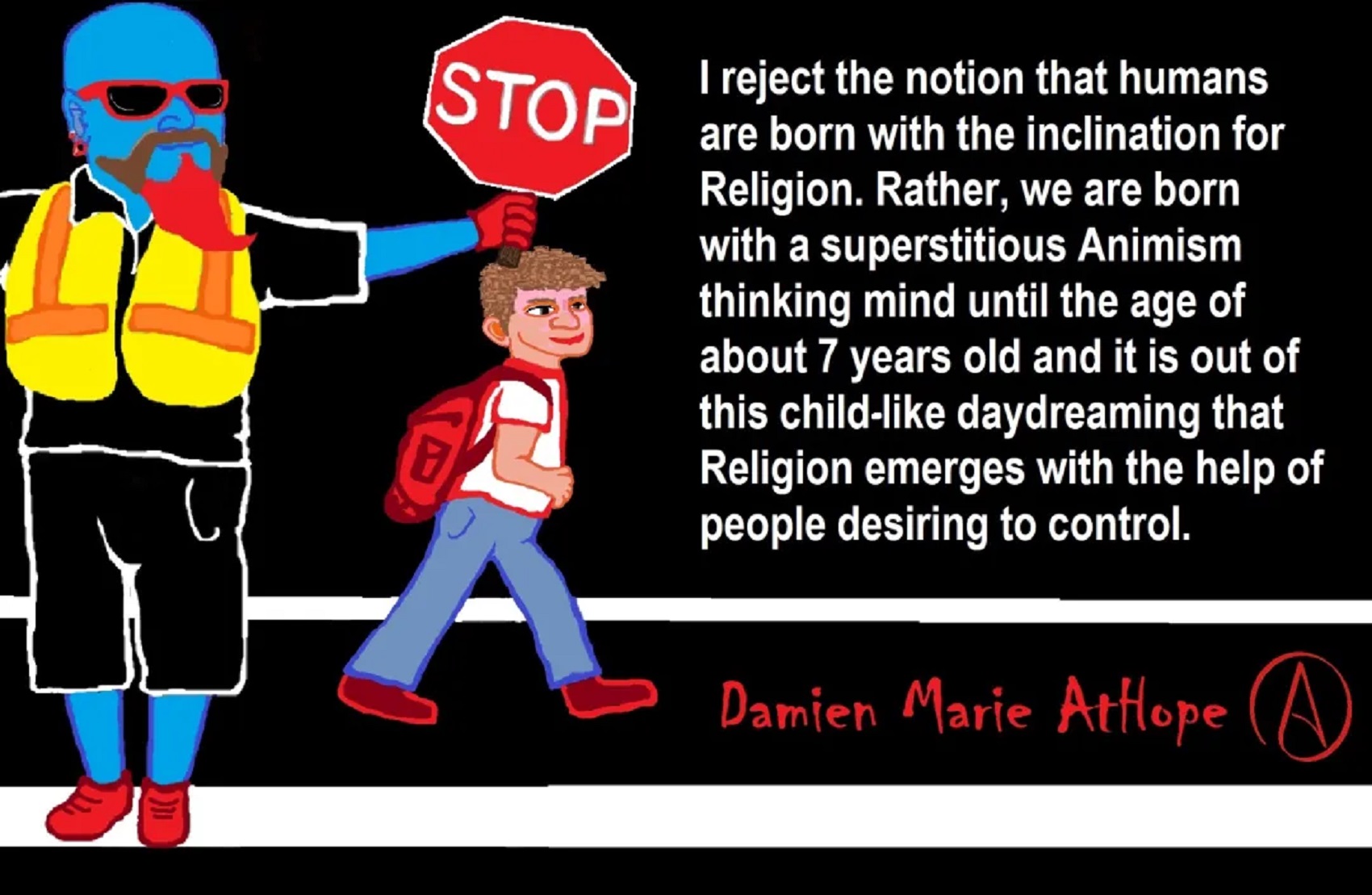
Do you truly think “Religious Belief” is only a matter of some personal choice?
Do you not see how coercive one’s world of choice is limited to the obvious hereditary belief, in most religious choices available to the child of religious parents or caregivers? Religion is more commonly like a family, culture, society, etc. available belief that limits the belief choices of the child and that is when “Religious Belief” is not only a matter of some personal choice and when it becomes hereditary faith, not because of the quality of its alleged facts or proposed truths but because everyone else important to the child believes similarly so they do as well simply mimicking authority beliefs handed to them. Because children are raised in religion rather than being presented all possible choices but rather one limited dogmatic brand of “Religious Belief” where children only have a choice of following the belief as instructed, and then personally claim the faith hereditary belief seen in the confirming to the belief they have held themselves all their lives. This is obvious in statements asked and answered by children claiming a faith they barely understand but they do understand that their family believes “this or that” faith, so they feel obligated to believe it too. While I do agree that “Religious Belief” should only be a matter of some personal choice, it rarely is… End Hereditary Religion!
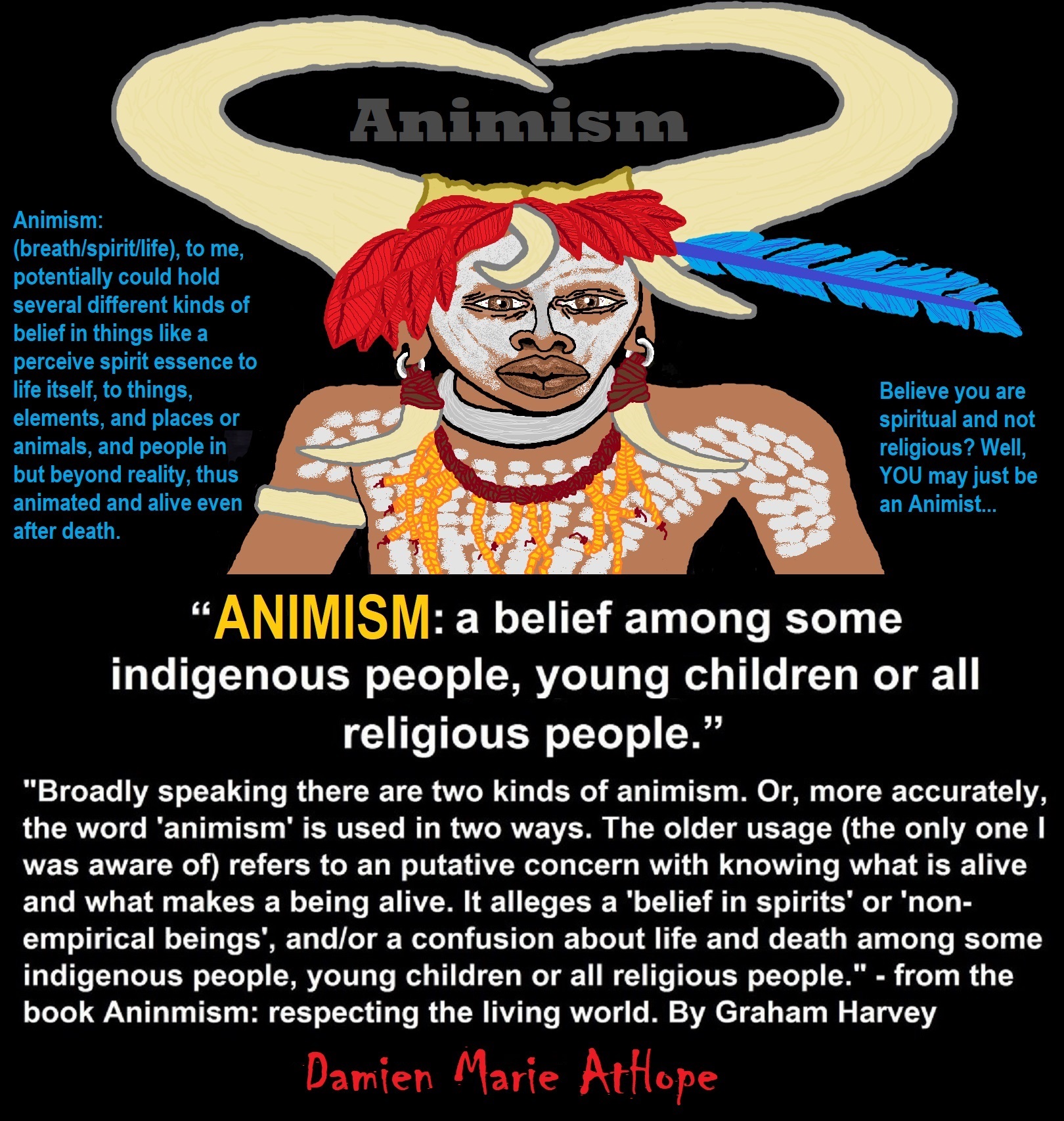
Animism: Respecting the Living World by Graham Harvey
“How have human cultures engaged with and thought about animals, plants, rocks, clouds, and other elements in their natural surroundings? Do animals and other natural objects have a spirit or soul? What is their relationship to humans? In this new study, Graham Harvey explores current and past animistic beliefs and practices of Native Americans, Maori, Aboriginal Australians, and eco-pagans. He considers the varieties of animism found in these cultures as well as their shared desire to live respectfully within larger natural communities. Drawing on his extensive casework, Harvey also considers the linguistic, performative, ecological, and activist implications of these different animisms.” ref
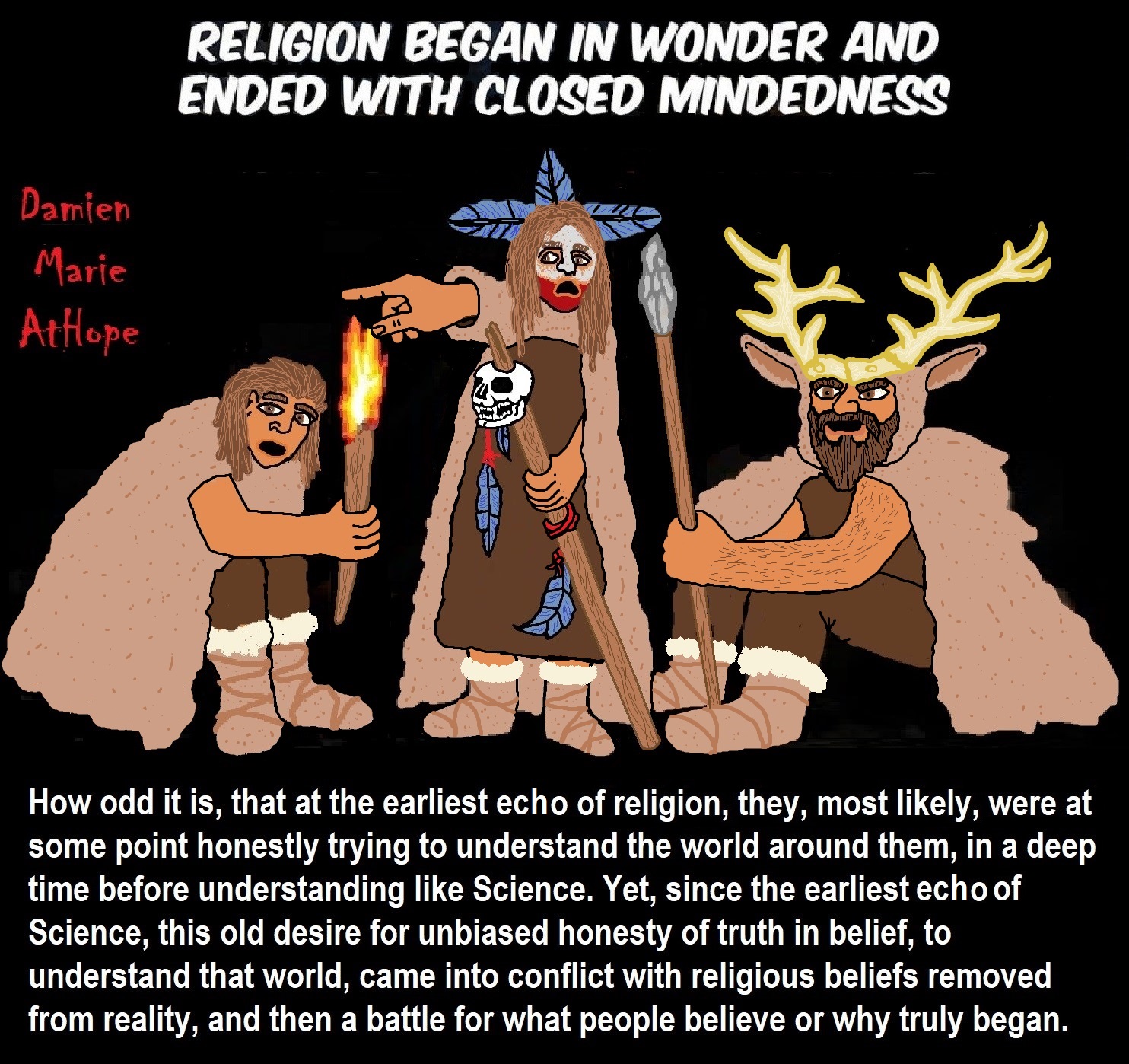
We are like believing machines we vacuum up ideas, like Velcro sticks to almost everything. We accumulate beliefs that we allow to negatively influence our lives, often without realizing it. Our willingness must be to alter skewed beliefs that impend our balance or reason, which allows us to achieve new positive thinking and accurate outcomes.

My thoughts on Religion Evolution with external links for more info:
- (Pre-Animism Africa mainly, but also Europe, and Asia at least 300,000 years ago), (Pre-Animism – Oxford Dictionaries)
- (Animism Africa around 100,000 years ago), (Animism – Britannica.com)
- (Totemism Europe around 50,000 years ago), (Totemism – Anthropology)
- (Shamanism Siberia around 30,000 years ago), (Shamanism – Britannica.com)
- (Paganism Turkey around 12,000 years ago), (Paganism – BBC Religion)
- (Progressed Organized Religion “Institutional Religion” Egypt around 5,000 years ago), (Ancient Egyptian Religion – Britannica.com)
- (CURRENT “World” RELIGIONS after 4,000 years ago) (Origin of Major Religions – Sacred Texts)
- (Early Atheistic Doubting at least by 2,600 years ago) (History of Atheism – Wikipedia)
“Religion is an Evolved Product” and Yes, Religion is Like Fear Given Wings…
Atheists talk about gods and religions for the same reason doctors talk about cancer, they are looking for a cure, or a firefighter talks about fires because they burn people and they care to stop them. We atheists too often feel a need to help the victims of mental slavery, held in the bondage that is the false beliefs of gods and the conspiracy theories of reality found in religions.
Understanding Religion Evolution:
- Pre-Animism (at least 300,000 years ago)
- Animism (Africa: 100,000 years ago)
- Totemism (Europe: 50,000 years ago)
- Shamanism (Siberia: 30,000 years ago)
- Paganism (Turkey: 12,000 years ago)
- Progressed organized religion (Egypt: 5,000 years ago), (Egypt, the First Dynasty 5,150 years ago)
- CURRENT “World” RELIGIONS (after 4,000 years ago)
- Early Atheistic Doubting (at least by 2,600 years ago)
“An Archaeological/Anthropological Understanding of Religion Evolution”
It seems ancient peoples had to survived amazing threats in a “dangerous universe (by superstition perceived as good and evil),” and human “immorality or imperfection of the soul” which was thought to affect the still living, leading to ancestor worship. This ancestor worship presumably led to the belief in supernatural beings, and then some of these were turned into the belief in gods. This feeble myth called gods were just a human conceived “made from nothing into something over and over, changing, again and again, taking on more as they evolve, all the while they are thought to be special,” but it is just supernatural animistic spirit-belief perceived as sacred.
Quick Evolution of Religion?
Pre-Animism (at least 300,000 years ago) pre-religion is a beginning that evolves into later Animism. So, Religion as we think of it, to me, all starts in a general way with Animism (Africa: 100,000 years ago) (theoretical belief in supernatural powers/spirits), then this is physically expressed in or with Totemism (Europe: 50,000 years ago) (theoretical belief in mythical relationship with powers/spirits through a totem item), which then enlists a full-time specific person to do this worship and believed interacting Shamanism (Siberia/Russia: 30,000 years ago) (theoretical belief in access and influence with spirits through ritual), and then there is the further employment of myths and gods added to all the above giving you Paganism (Turkey: 12,000 years ago) (often a lot more nature-based than most current top world religions, thus hinting to their close link to more ancient religious thinking it stems from). My hypothesis is expressed with an explanation of the building of a theatrical house (modern religions development). Progressed organized religion (Egypt: 5,000 years ago) with CURRENT “World” RELIGIONS (after 4,000 years ago).
Historically, in large city-state societies (such as Egypt or Iraq) starting around 5,000 years ago culminated to make religion something kind of new, a sociocultural-governmental-religious monarchy, where all or at least many of the people of such large city-state societies seem familiar with and committed to the existence of “religion” as the integrated life identity package of control dynamics with a fixed closed magical doctrine, but this juggernaut integrated religion identity package of Dogmatic-Propaganda certainly did not exist or if developed to an extent it was highly limited in most smaller prehistoric societies as they seem to lack most of the strong control dynamics with a fixed closed magical doctrine (magical beliefs could be at times be added or removed). Many people just want to see developed religious dynamics everywhere even if it is not. Instead, all that is found is largely fragments until the domestication of religion.
Religions, as we think of them today, are a new fad, even if they go back to around 6,000 years in the timeline of human existence, this amounts to almost nothing when seen in the long slow evolution of religion at least around 70,000 years ago with one of the oldest ritual worship. Stone Snake of South Africa: “first human worship” 70,000 years ago. This message of how religion and gods among them are clearly a man-made thing that was developed slowly as it was invented and then implemented peace by peace discrediting them all. Which seems to be a simple point some are just not grasping how devastating to any claims of truth when we can see the lie clearly in the archeological sites.
I wish people fought as hard for the actual values as they fight for the group/clan names political or otherwise they think support values. Every amount spent on war is theft to children in need of food or the homeless kept from shelter.
Here are several of my blog posts on history:
- To Find Truth You Must First Look
- (Magdalenian/Iberomaurusian) Connections to the First Paganists of the early Neolithic Near East Dating from around 17,000 to 12,000 Years Ago
- Natufians: an Ancient People at the Origins of Agriculture and Sedentary Life
- Possible Clan Leader/Special “MALE” Ancestor Totem Poles At Least 13,500 years ago?
- Jewish People with DNA at least 13,200 years old, Judaism, and the Origins of Some of its Ideas
- Baltic Reindeer Hunters: Swiderian, Lyngby, Ahrensburgian, and Krasnosillya cultures 12,020 to 11,020 years ago are evidence of powerful migratory waves during the last 13,000 years and a genetic link to Saami and the Finno-Ugric peoples.
- The Rise of Inequality: patriarchy and state hierarchy inequality
- Fertile Crescent 12,500 – 9,500 Years Ago: fertility and death cult belief system?
- 12,400 – 11,700 Years Ago – Kortik Tepe (Turkey) Pre/early-Agriculture Cultic Ritualism
- Ritualistic Bird Symbolism at Gobekli Tepe and its “Ancestor Cult”
- Male-Homosexual (female-like) / Trans-woman (female) Seated Figurine from Gobekli Tepe
- Could a 12,000-year-old Bull Geoglyph at Göbekli Tepe relate to older Bull and Female Art 25,000 years ago and Later Goddess and the Bull cults like Catal Huyuk?
- Sedentism and the Creation of goddesses around 12,000 years ago as well as male gods after 7,000 years ago.
- Alcohol, where Agriculture and Religion Become one? Such as Gobekli Tepe’s Ritualistic use of Grain as Food and Ritual Drink
- Neolithic Ritual Sites with T-Pillars and other Cultic Pillars
- Paganism: Goddesses around 12,000 years ago then Male Gods after 7,000 years ago
- First Patriarchy: Split of Women’s Status around 12,000 years ago & First Hierarchy: fall of Women’s Status around 5,000 years ago.
- Natufians: an Ancient People at the Origins of Agriculture and Sedentary Life
- J DNA and the Spread of Agricultural Religion (paganism)
- Paganism: an approximately 12,000-year-old belief system
- Paganism 12,000 years old: related to “Anarchism and Socialism” (Pre-Capitalism)
- Shaman burial in Israel 12,000 years ago and the Shamanism Phenomena
- Need to Mythicized: gods and goddesses
- 12,000 – 7,000 Years Ago – Paleo-Indian Culture (The Americas)
- 12,000 – 2,000 Years Ago – Indigenous-Scandinavians (Nordic)
- Norse did not wear helmets with horns?
- Pre-Pottery Neolithic Skull Cult around 11,500 to 8,400 Years Ago?
- 10,400 – 10,100 Years Ago, in Turkey the Nevail Cori Religious Settlement
- 9,000-6,500 Years Old Submerged Pre-Pottery/Pottery Neolithic Ritual Settlements off Israel’s Coast
- Catal Huyuk “first religious designed city” around 9,500 to 7,700 years ago (Turkey)
- Cultic Hunting at Catal Huyuk “first religious designed city”
- Special Items and Art as well as Special Elite Burials at Catal Huyuk
- New Rituals and Violence with the appearance of Pottery and People?
- Haplogroup N and its related Uralic Languages and Cultures
- Ainu people, Sámi people, Native Americans, the Ancient North Eurasians, and Paganistic-Shamanism with Totemism
- Ideas, Technology and People from Turkey, Europe, to China and Back again 9,000 to 5,000 years ago?
- First Pottery of Europe and the Related Cultures
- 9,000 years old Neolithic Artifacts Judean Desert and Hills Israel
- 9,000-7,000 years-old Sex and Death Rituals: Cult Sites in Israel, Jordan, and the Sinai
- 9,000-8500 year old Horned Female shaman Bad Dürrenberg Germany
- Neolithic Jewelry and the Spread of Farming in Europe Emerging out of West Turkey
- 8,600-year-old Tortoise Shells in Neolithic graves in central China have Early Writing and Shamanism
- Swing of the Mace: the rise of Elite, Forced Authority, and Inequality begin to Emerge 8,500 years ago?
- Migrations and Changing Europeans Beginning around 8,000 Years Ago
- My “Steppe-Anatolian-Kurgan hypothesis” 8,000/7,000 years ago
- Around 8,000-year-old Shared Idea of the Mistress of Animals, “Ritual” Motif
- Pre-Columbian Red-Paint (red ochre) Maritime Archaic Culture 8,000-3,000 years ago
- 7,522-6,522 years ago Linear Pottery culture which I think relates to Arcane Capitalism’s origins
- Arcane Capitalism: Primitive socialism, Primitive capital, Private ownership, Means of production, Market capitalism, Class discrimination, and Petite bourgeoisie (smaller capitalists)
- 7,500-4,750 years old Ritualistic Cucuteni-Trypillian culture of Moldova, Romania, and Ukraine
- Roots of a changing early society 7,200-6,700 years ago Jordan and Israel
- Agriculture religion (Paganism) with farming reached Britain between about 7,000 to 6,500 or so years ago and seemingly expressed in things like Western Europe’s Long Barrows
- My Thoughts on Possible Migrations of “R” DNA and Proto-Indo-European?
- “Millet” Spreading from China 7,022 years ago to Europe and related Language may have Spread with it leading to Proto-Indo-European
- Proto-Indo-European (PIE), ancestor of Indo-European languages: DNA, Society, Language, and Mythology
- The Dnieper–Donets culture and Asian varieties of Millet from China to the Black Sea region of Europe by 7,022 years ago
- Kurgan 6,000 years ago/dolmens 7,000 years ago: funeral, ritual, and other?
- 7,020 to 6,020-year-old Proto-Indo-European Homeland of Urheimat or proposed home of their Language and Religion
- Ancient Megaliths: Kurgan, Ziggurat, Pyramid, Menhir, Trilithon, Dolman, Kromlech, and Kromlech of Trilithons
- The Mytheme of Ancient North Eurasian Sacred-Dog belief and similar motifs are found in Indo-European, Native American, and Siberian comparative mythology
- Elite Power Accumulation: Ancient Trade, Tokens, Writing, Wealth, Merchants, and Priest-Kings
- Sacred Mounds, Mountains, Kurgans, and Pyramids may hold deep connections?
- Between 7,000-5,000 Years ago, rise of unequal hierarchy elite, leading to a “birth of the State” or worship of power, strong new sexism, oppression of non-elites, and the fall of Women’s equal status
- Paganism 7,000-5,000 years old: related to “Anarchism and Socialism” (Capitalism) (World War 0) Elite & their slaves
- Hell and Underworld mythologies starting maybe as far back as 7,000 to 5,000 years ago with the Proto-Indo-Europeans?
- The First Expression of the Male God around 7,000 years ago?
- White (light complexion skin) Bigotry and Sexism started 7,000 years ago?
- Around 7,000-year-old Shared Idea of the Divine Bird (Tutelary and/or Trickster spirit/deity), “Ritual” Motif
- Nekhbet an Ancient Egyptian Vulture Goddess and Tutelary Deity
- 6,720 to 4,920 years old Ritualistic Hongshan Culture of Inner Mongolia with 5,000-year-old Pyramid Mounds and Temples
- First proto-king in the Balkans, Varna culture around 6,500 years ago?
- 6,500–5,800 years ago in Israel Late Chalcolithic (Copper Age) Period in the Southern Levant Seems to Express Northern Levant Migrations, Cultural and Religious Transfer
- KING OF BEASTS: Master of Animals “Ritual” Motif, around 6,000 years old or older…
- Around 6000-year-old Shared Idea of the Solid Wheel & the Spoked Wheel-Shaped Ritual Motif
- “The Ghassulian Star,” a mysterious 6,000-year-old mural from Jordan; a Proto-Star of Ishtar, Star of Inanna or Star of Venus?
- Religious/Ritual Ideas, including goddesses and gods as well as ritual mounds or pyramids from Northeastern Asia at least 6,000 years old, seemingly filtering to Iran, Iraq, the Mediterranean, Europe, Egypt, and the Americas?
- Maykop (5,720–5,020 years ago) Caucasus region Bronze Age culture-related to Copper Age farmers from the south, influenced by the Ubaid period and Leyla-Tepe culture, as well as influencing the Kura-Araxes culture
- 5-600-year-old Tomb, Mummy, and First Bearded Male Figurine in a Grave
- Kura-Araxes Cultural 5,520 to 4,470 years old DNA traces to the Canaanites, Arabs, and Jews
- Minoan/Cretan (Keftiu) Civilization and Religion around 5,520 to 3,120 years ago
- Evolution Of Science at least by 5,500 years ago
- 5,500 Years old birth of the State, the rise of Hierarchy, and the fall of Women’s status
- “Jiroft culture” 5,100 – 4,200 years ago and the History of Iran
- Stonehenge: Paganistic Burial and Astrological Ritual Complex, England (5,100-3,600 years ago)
- Around 5,000-year-old Shared Idea of the “Tree of Life” Ritual Motif
- Complex rituals for elite, seen from China to Egypt, at least by 5,000 years ago
- Around 5,000 years ago: “Birth of the State” where Religion gets Military Power and Influence
- The Center of the World “Axis Mundi” and/or “Sacred Mountains” Mythology Could Relate to the Altai Mountains, Heart of the Steppe
- Progressed organized religion starts, an approximately 5,000-year-old belief system
- China’s Civilization between 5,000-3,000 years ago, was a time of war and class struggle, violent transition from free clans to a Slave or Elite society
- Origin of Logics is Naturalistic Observation at least by around 5,000 years ago.
- Paganism 5,000 years old: progressed organized religion and the state: related to “Anarchism and Socialism” (Kings and the Rise of the State)
- Ziggurats (multi-platform temples: 4,900 years old) to Pyramids (multi-platform tombs: 4,700 years old)
- Did a 4,520–4,420-year-old Volcano In Turkey Inspire the Bible God?
- Finland’s Horned Shaman and Pre-Horned-God at least 4,500 years ago?
- 4,000-year-Old Dolmens in Israel: A Connected Dolmen Religious Phenomenon?
- Creation myths: From chaos, Ex nihilo, Earth-diver, Emergence, World egg, and World parent
- Bronze Age “Ritual” connections of the Bell Beaker culture with the Corded Ware/Single Grave culture, which were related to the Yamnaya culture and Proto-Indo-European Languages/Religions
- Low Gods (Earth/ Tutelary deity), High Gods (Sky/Supreme deity), and Moralistic Gods (Deity enforcement/divine order)
- The exchange of people, ideas, and material-culture including, to me, the new god (Sky Father) and goddess (Earth Mother) religion between the Cucuteni-Trypillians and others which is then spread far and wide
- Koryaks: Indigenous People of the Russian Far East and Big Raven myths also found in Tlingit, Haida, Tsimshian, and other Indigenous People of North America
- 42 Principles Of Maat (Egyptian Goddess of the justice) around 4,400 years ago, 2000 Years Before Ten Commandments
- “Happy Easter” Well Happy Eostre/Ishter
- 4,320-3,820 years old “Shimao” (North China) site with Totemistic-Shamanistic Paganism and a Stepped Pyramid
- 4,250 to 3,400 Year old Stonehenge from Russia: Arkaim?
- 4,100-year-old beaker with medicinal & flowering plants in a grave of a woman in Scotland
- Early European Farmer ancestry, Kelif el Boroud people with the Cardial Ware culture, and the Bell Beaker culture Paganists too, spread into North Africa, then to the Canary Islands off West Africa
- Flood Accounts: Gilgamesh epic (4,100 years ago) Noah in Genesis (2,600 years ago)
- Paganism 4,000 years old: related to “Anarchism and Socialism” (First Moralistic gods, then the Origin time of Monotheism)
- When was the beginning: TIMELINE OF CURRENT RELIGIONS, which start around 4,000 years ago.
- Early Religions Thought to Express Proto-Monotheistic Systems around 4,000 years ago
- Kultepe? An archaeological site with a 4,000 years old women’s rights document.
- Single God Religions (Monotheism) = “Man-o-theism” started around 4,000 years ago with the Great Sky Spirit/God Tiān (天)?
- Confucianism’s Tiān (Shangdi god 4,000 years old): Supernaturalism, Pantheism or Theism?
- Yes, Your Male God is Ridiculous
- Mythology, a Lunar Deity is a Goddess or God of the Moon
- Sacred Land, Hills, and Mountains: Sami Mythology (Paganistic Shamanism)
- Horse Worship/Sacrifice: mythical union of Ruling Elite/Kingship and the Horse
- The Amorite/Amurru people’s God Amurru “Lord of the Steppe”, relates to the Origins of the Bible God?
- Bronze Age Exotic Trade Routes Spread Quite Far as well as Spread Religious Ideas with Them
- Sami and the Northern Indigenous Peoples Landscape, Language, and its Connection to Religion
- Prototype of Ancient Analemmatic Sundials around 3,900-3,150 years ago and a Possible Solar Connection to gods?
- Judaism is around 3,450 or 3,250 years old. (“Paleo-Hebrew” 3,000 years ago and Torah 2,500 years ago)
- The Weakening of Ancient Trade and the Strengthening of Religions around 3000 years ago?
- Are you aware that there are religions that worship women gods, explain now religion tears women down?
- Animistic, Totemistic, and Paganistic Superstition Origins of bible god and the bible’s Religion.
- Myths and Folklore: “Trickster gods and goddesses”
- Jews, Judaism, and the Origins of Some of its Ideas
- An Old Branch of Religion Still Giving Fruit: Sacred Trees
- Dating the BIBLE: naming names and telling times (written less than 3,000 years ago, provable to 2,200 years ago)
- Did a Volcano Inspire the bible god?
- Dené–Yeniseian language, Old Copper Complex, and Pre-Columbian Mound Builders?
- No “dinosaurs and humans didn’t exist together just because some think they are in the bible itself”
- Sacred Shit and Sacred Animals?
- Everyone Killed in the Bible Flood? “Nephilim” (giants)?
- Hey, Damien dude, I have a question for you regarding “the bible” Exodus.
- Archaeology Disproves the Bible
- Bible Battle, Just More, Bible Babble
- The Jericho Conquest lie?
- Canaanites and Israelites?
- Accurate Account on how did Christianity Began?
- Let’s talk about Christianity.
- So the 10 commandments isn’t anything to go by either right?
- Misinformed christian
- Debunking Jesus?
- Paulism vs Jesus
- Ok, you seem confused so let’s talk about Buddhism.
- Unacknowledged Buddhism: Gods, Savior, Demons, Rebirth, Heavens, Hells, and Terrorism
- His Foolishness The Dalai Lama
- Yin and Yang is sexist with an ORIGIN around 2,300 years ago?
- I Believe Archaeology, not Myths & Why Not, as the Religious Myths Already Violate Reason!
- Archaeological, Scientific, & Philosophic evidence shows the god myth is man-made nonsense.
- Aquatic Ape Theory/Hypothesis? As Always, Just Pseudoscience.
- Ancient Aliens Conspiracy Theorists are Pseudohistorians
- The Pseudohistoric and Pseudoscientific claims about “Bakoni Ruins” of South Africa
- Why do people think Religion is much more than supernaturalism and superstitionism?
- Religion is an Evolved Product
- Was the Value of Ancient Women Different?
- 1000 to 1100 CE, human sacrifice Cahokia Mounds a pre-Columbian Native American site
- Feminist atheists as far back as the 1800s?
- Promoting Religion as Real is Mentally Harmful to a Flourishing Humanity
- Screw All Religions and Their Toxic lies, they are all fraud
- Forget Religions’ Unfounded Myths, I Have Substantiated “Archaeology Facts.”
- Religion Dispersal throughout the World
- I Hate Religion Just as I Hate all Pseudoscience
- Exposing Scientology, Eckankar, Wicca and Other Nonsense?
- Main deity or religious belief systems
- Quit Trying to Invent Your God From the Scraps of Science.
- Archaeological, Scientific, & Philosophic evidence shows the god myth is man-made nonsense.
- Ancient Alien Conspiracy Theorists: Misunderstanding, Rhetoric, Misinformation, Fabrications, and Lies
- Misinformation, Distortion, and Pseudoscience in Talking with a Christian Creationist
- Judging the Lack of Goodness in Gods, Even the Norse God Odin
- Challenging the Belief in God-like Aliens and Gods in General
- A Challenge to Christian use of Torture Devices?
- Yes, Hinduism is a Religion
- Trump is One of the Most Reactionary Forces of Far-right Christian Extremism
- Was the Bull Head a Symbol of God? Yes!
- Primate Death Rituals
- Christian – “God and Christianity are objectively true”
- Australopithecus afarensis Death Ritual?
- You Claim Global Warming is a Hoax?
- Doubter of Science and Defamer of Atheists?
- I think that sounds like the Bible?
- History of the Antifa (“anti-fascist”) Movements
- Indianapolis Anti-Blasphemy Laws #Free Soheil Rally
- Damien, you repeat the golden rule in so many forms then you say religion is dogmatic?
- Science is a Trustable Methodology whereas Faith is not Trustable at all!
- Was I ever a believer, before I was an atheist?
- Atheists rise in reason
- Mistrust of science?
- Open to Talking About the Definition of ‘God’? But first, we address Faith.
- ‘United Monarchy’ full of splendor and power – Saul, David, and Solomon? Most likely not.
- Is there EXODUS ARCHAEOLOGY? The short answer is “no.”
- Lacking Proof of Bigfoots, Unicorns, and Gods is Just a Lack of Research?
- Religion and Politics: Faith Beliefs vs. Rational Thinking
- Hammer of Truth that lying pig RELIGION: challenged by an archaeologist
- “The Hammer of Truth” -ontology question- What do You Mean by That?
- Navigation of a bad argument: Ad Hominem vs. Attack
- Why is it Often Claimed that Gods have a Gender?
- Why are basically all monotheistic religions ones that have a male god?
- Shifting through the Claims in support of Faith
- Dear Mr. AtHope, The 20th Century is an Indictment of Secularism and a Failed Atheist Century
- An Understanding of the Worldwide Statistics and Dynamics of Terrorist Incidents and Suicide Attacks
- Intoxication and Evolution? Addressing and Assessing the “Stoned Ape” or “Drunken Monkey” Theories as Catalysts in Human Evolution
- Sacred Menstrual cloth? Inanna’s knot, Isis knot, and maybe Ma’at’s feather?
- Damien, why don’t the Hebrews accept the bible stories?
- Dealing with a Troll and Arguing Over Word Meaning
- Knowledge without Belief? Justified beliefs or disbeliefs worthy of Knowledge?
- Afrocentrism and African Religions
- Crecganford @crecganford offers history & stories of the people, places, gods, & culture
- Empiricism-Denier?
I am not an academic. I am a revolutionary that teaches in public, in places like social media, and in the streets. I am not a leader by some title given but from my commanding leadership style of simply to start teaching everywhere to everyone, all manner of positive education.
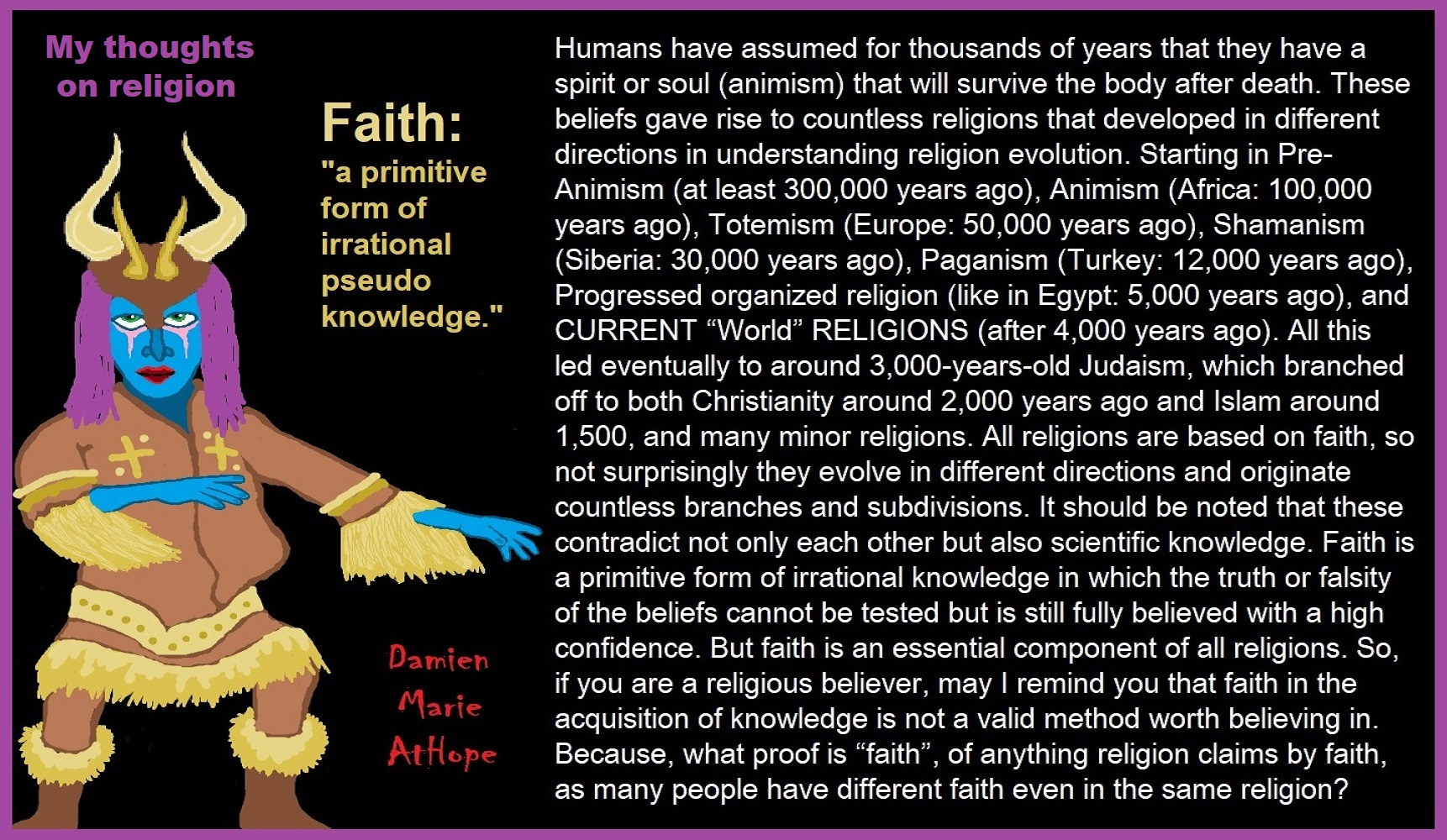


To me, Animism starts in Southern Africa, then to West Europe, and becomes Totemism. Another split goes near the Russia and Siberia border becoming Shamanism, which heads into Central Europe meeting up with Totemism, which also had moved there, mixing the two which then heads to Lake Baikal in Siberia. From there this Shamanism-Totemism heads to Turkey where it becomes Paganism.
Religions continuing in our modern world, full of science and facts, should be seen as little more than a set of irrational conspiracy theories of reality. Nothing more than a confused reality made up of unscientific echoes from man’s ancient past. Rational thinkers must ask themselves why continue to believe in religions’ stories. Religion myths which are nothing more than childlike stories and obsolete tales once used to explain how the world works, acting like magic was needed when it was always only nature. These childlike religious stories should not even be taken seriously, but sadly too often they are.
Often without realizing it, we accumulate beliefs that we allow to negatively influence our lives. In order to bring about awareness, we need to be willing to alter skewed beliefs. Rational thinkers must examine the facts instead of blindly following beliefs or faith. Below is a collection of researched information such as archaeology, history, linguistics, genetics, art, science, sociology, geography, psychology, philosophy, theology, biology, and zoology. It will make you question your beliefs with information, inquiries, and ideas to ponder and expand on. The two main goals are to expose the evolution of religion starting by around 100,000 years ago and to offer challenges to remove the rationale of faith. It is like an intervention for belief in myths that have plagued humankind for way too long. We often think we know what truth is nevertheless this can be but a vantage point away from losing credibility if we are not willing to follow valid and reliable reason and evidence.
The door of reason opens not once but many times. Come on a journey to free thought where the war is against ignorance and the victor is a rational mind. Understanding Religion Evolution: Pre-Animism (at least 300,000 years ago), * Animism (such as that seen in Africa: 100,000 years ago), *Totemism (Europe: 50,000 years ago), * Shamanism (beginning around 30,000 years ago), *Paganism (beginning around 12,000 years ago), * Progressed organized religion (around 5,000 years ago), * CURRENT “World” RELIGIONS (after 4,000 years ago), and * Early Atheistic Doubting (at least by around 2,600 Years Ago)
In a general way, it all starts with Animism (a theoretical belief in supernatural powers/spirits) and this is physically expressed in or with Totemism (a theoretical belief in a mythical relationship with powers/spirits through a totem item), which then enlists a full-time specific person to perform this worship and believed interaction as Shamanism (a theoretical belief in access and influence with spirits through rituals). In addition, there is the further employment of myths and gods added to all the above, which is Paganism and is often a lot more nature-based than most current top world religions, thus hinting to their close link to more ancient religious thinking from which it stems.
My hypothesis is expressed with an explanation of the building of a theoretical house (modern religions development). It seems ancient peoples had to survived amazing threats in a “dangerous universe by superstition perceived as good and evil”, and human “immorality or imperfection of the soul”, which was thought to affect the still living and led to ancestor worship. Presumably, this ancestor worship led to the belief in supernatural beings, which some of these were turned into the belief in gods. This feeble myth called gods were just a human conceived idea that was “made from nothing into something over and over, changing again and again, taking on more as they evolve, and all the while, they are thought to be special.” However, it is just supernatural animistic spirit-belief perceived as sacred.
Historically, around 5,000 years ago, in large city-state societies such as Egypt or Iraq culminated to make religion into something kind of new, a sociocultural-governmental-religious monarchy, where all or at least many of the people of such large city-state societies seem familiar with and committed to the existence of “religion” as the integrated life identity package of control dynamics with a fixed closed magical doctrine. However, this juggernaut integrated religion identity package of Dogmatic-Propaganda certainly did not exist or if developed to an extent, it was highly limited in most smaller prehistoric societies as they seem to lack most of the strong control dynamics with a fixed closed magical doctrine. These magical beliefs could be at times be added or removed and many people just want to see developed religious dynamics everywhere, even if it is not. Instead, all that is found is largely fragments until the domestication of religion.
Religions, as we think of them today, are a new fad, even if they go back to around 6,000 years in the timeline of human existence. This amounts to almost nothing when seen in the long slow evolution of religion that started at least around 70,000 years ago with one of the oldest ritual worship. This message of how religion and gods are intertwined with humans is clearly a man-made idea that was developed slowly as it was invented, reinvented, and implemented piece by piece, which discredits them all. This seems to be a simple point, which some are just not grasping how devastating this is to any claims of truth when we can see the lie clearly in the archeological sites.
“Religion is an Evolved Product”
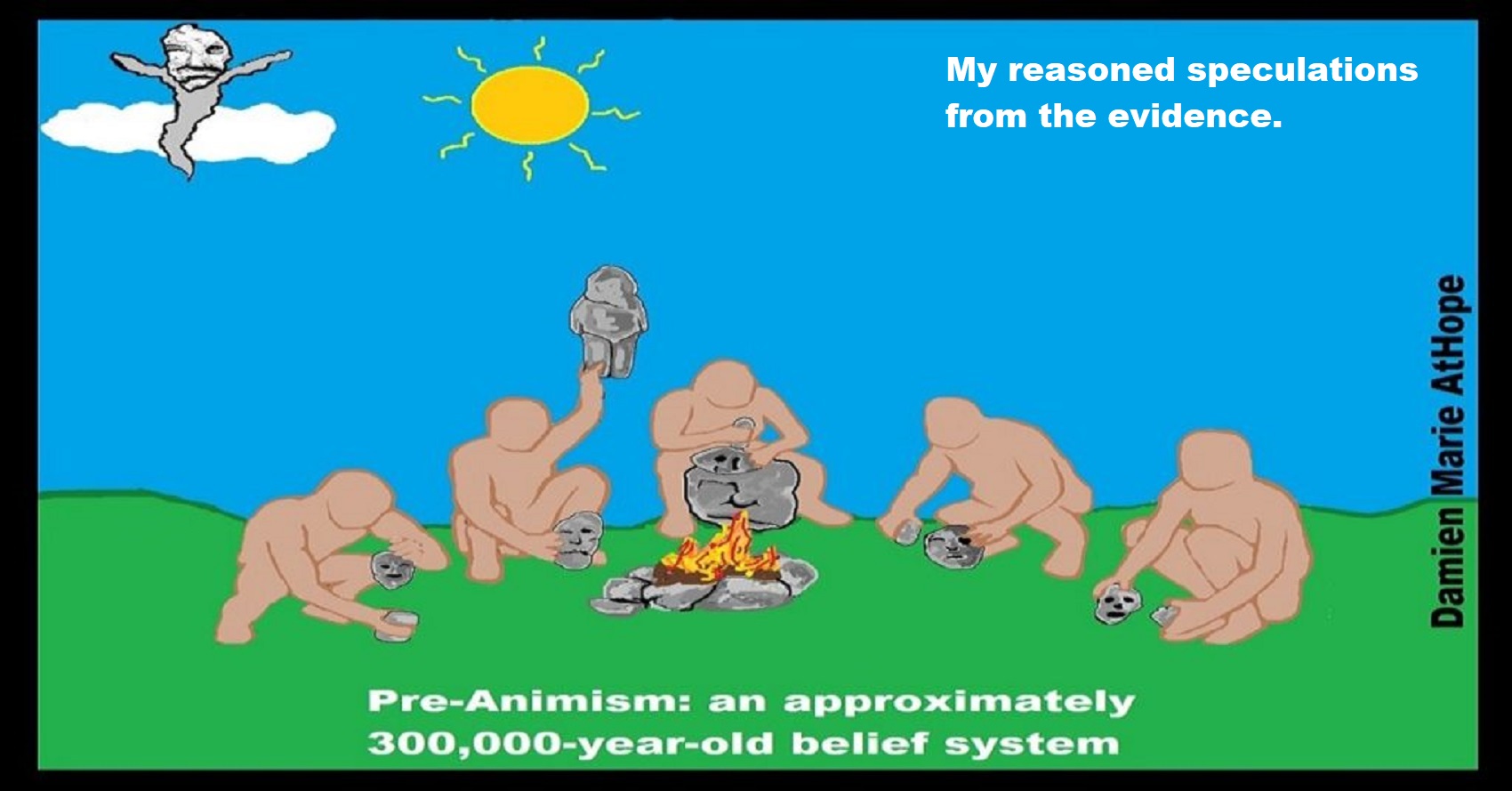
Pre-Animism (at least 300,000 years ago)
Around a million years ago, I surmise that Pre-Animism, “animistic superstitionism”, began, Around 400,000 Years ago shows Sociocultural Evolution, and then led to the animistic somethingism or animistic supernaturalism, which is at least 300,000 years old and about 100,00 years ago, it evolves to a representation of general Animism, which is present in today’s religions. There is also Homo Naledi and an Intentional Cemetery “Pre-Animism” dating to around 250,000 years ago. And, Neanderthals “Primal Religion (Pre-Animism/Animism?)” Mystery Cave Rings 175,000 Years Ago. Neanderthals were the first humans to intentionally bury the dead, around 130,000 years ago at sites such as Krapina in Croatia.
Pre-animism ideas can be seen in rock art such as that expressed in portable anthropomorphic art, which may be related to some kind of ancestor veneration. This magical thinking may stem from a social or non-religious function of ancestor veneration, which cultivates kinship values such as filial piety, family loyalty, and continuity of the family lineage. Ancestor veneration occurs in societies with every degree of social, political, and technological complexity and it remains an important component of various religious practices in modern times.
Humans are not the only species, which bury their dead. The practice has been observed in chimpanzees, elephants, and possibly dogs. Intentional burial, particularly with grave goods, signify a “concern for the dead” and Neanderthals were the first human species to practice burial behavior and intentionally bury their dead, doing so in shallow graves along with stone tools and animal bones. Exemplary sites include Shanidar in Iraq, Kebara Cave in Israel and Krapina in Croatia. The earliest undisputed human burial dates back 100,000 years ago with remains stained with red ochre, which show ritual intentionality similar to the Neanderthals before them. ref, ref
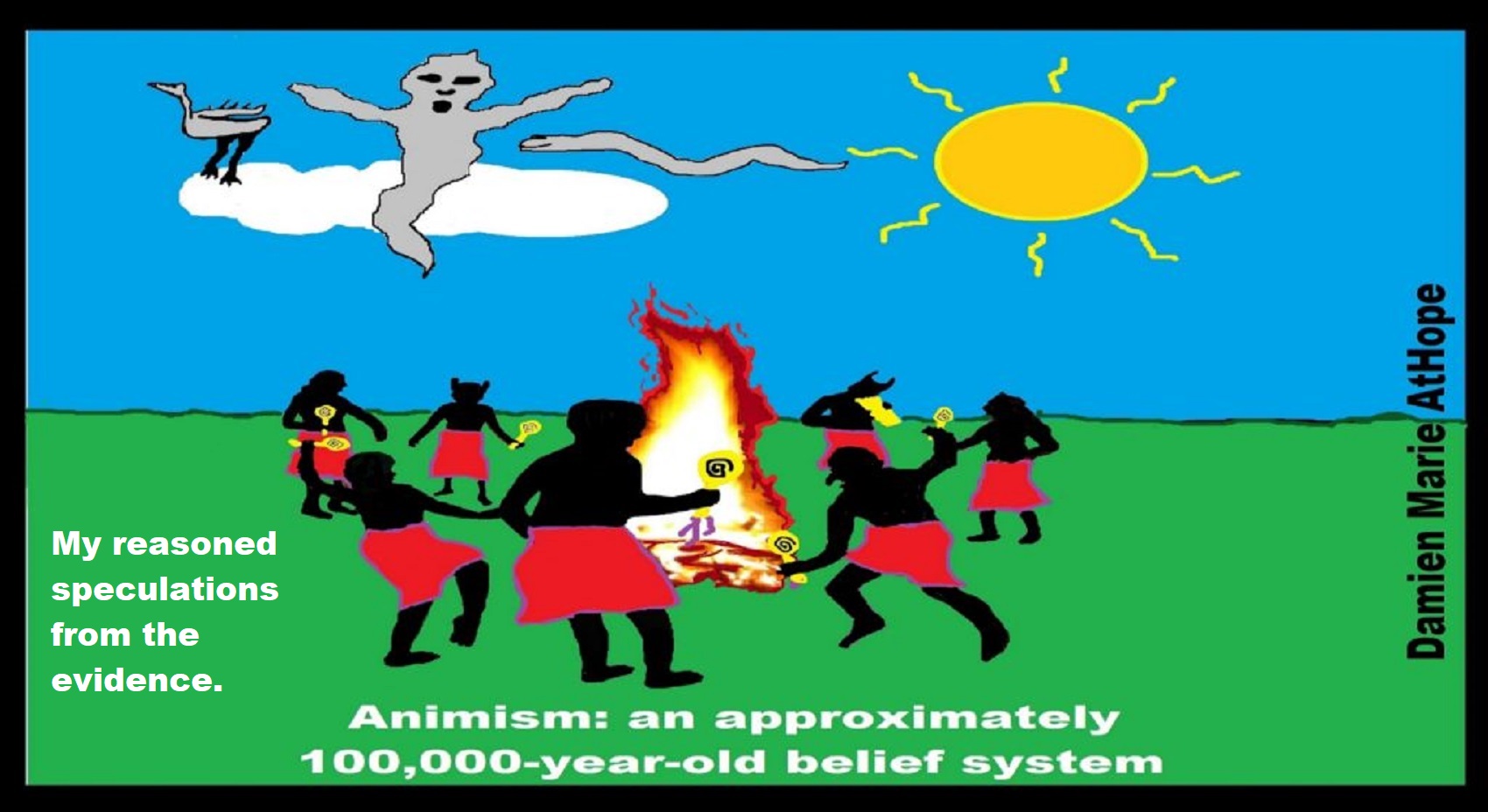
Animism (such as that seen in Africa: 100,000 years ago)
Did Neanderthals teach us “Primal Religion (Pre-Animism/Animism?)” 120,000 Years Ago? Homo sapiens – is known to have reached the Levant between 120,000 and 90,000 years ago, but that exit from Africa evidently went extinct. 100,000 years ago, in Qafzeh, Israel, the oldest intentional burial had 15 African individuals covered in red ocher was from a group who visited and returned back to Africa. 100,000 to 74,000 years ago, at Border Cave in Africa, an intentional burial of an infant with red ochre and a shell ornament, which may have possible connections to the Africans buried in Qafzeh.
Animism is approximately a 100,000-year-old belief system and believe in spirit-filled life and/or afterlife. If you believe like this, regardless of your faith, you are a hidden animist.
The following is evidence of Animism: 100,000 years ago, in Qafzeh, Israel, the oldest intentional burial had 15 African individuals covered in red ocher was from a group who visited and returned back to Africa. 100,000 to 74,000 years ago, at Border Cave in Africa, an intentional burial of an infant with red ochre and a shell ornament, which may have possible connections to the Africans buried in Qafzeh, Israel. 120,000 years ago, did Neanderthals teach us Primal Religion (Pre-Animism/Animism) as they too used red ocher and burials? ref, ref
It seems to me, it may be the Neanderthals who may have transmitted a “Primal Religion (Animism)” or at least burial and thoughts of an afterlife. The Neanderthals seem to express what could be perceived as a Primal “type of” Religion, which could have come first and is supported in how 250,000 years ago, the Neanderthals used red ochre and 230,000 years ago shows evidence of Neanderthal burial with grave goods and possibly a belief in the afterlife. ref
Do you think it is crazy that the Neanderthals may have transmitted a “Primal Religion”? Consider this, it appears that 175,000 years ago, the Neanderthals built mysterious underground circles with broken off stalactites. This evidence suggests that the Neanderthals were the first humans to intentionally bury the dead, doing so in shallow graves along with stone tools and animal bones. Exemplary sites include Shanidar in Iraq, Kebara Cave in Israel and Krapina in Croatia. Other evidence may suggest the Neanderthals had it transmitted to them by Homo heidelbergensis, 350,000 years ago, by their earliest burial in a shaft pit grave in a cave that had a pink stone axe on the top of 27 Homo heidelbergensis individuals and 250,000 years ago, Homo naledi had an intentional cemetery in South Africa cave. ref, ref, ref, ref, ref
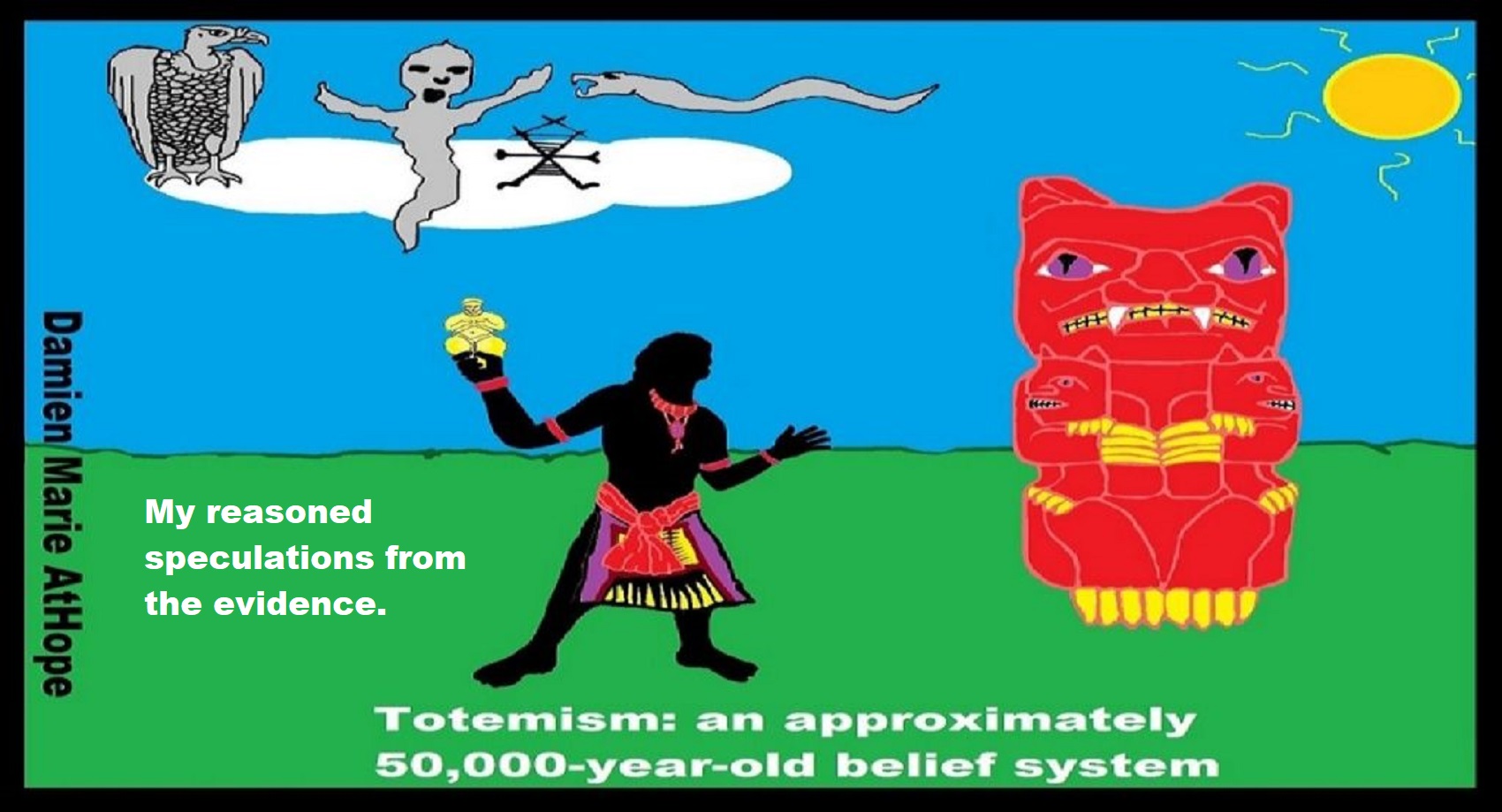
Totemism (Europe: 50,000 years ago)
Did Neanderthals Help Inspire Totemism? Because there is Art Dating to Around 65,000 Years Ago in Spain? Totemism as seen in Europe: 50,000 years ago, mainly the Aurignacian culture. Pre-Aurignacian “Châtelperronian” (Western Europe, mainly Spain and France, possible transitional/cultural diffusion between Neanderthals and Humans around 50,000-40,000 years ago). Archaic–Aurignacian/Proto-Aurignacian Humans (Europe around 46,000-35,000). And Aurignacian “classical/early to late” Humans (Europe and other areas around 38,000 – 26,000 years ago).
Totemism is approximately a 50,000-year-old belief system and believe in spirit-filled life and/or afterlife that can be attached to or be expressed in things or objects. If you believe like this, regardless of your faith, you are a hidden totemist.
Toetmism may be older as there is evidence of what looks like a Stone Snake in South Africa, which may be the “first human worship” dating to around 70,000 years ago. Many archaeologists propose that societies from 70,000 to 50,000 years ago such as that of the Neanderthals may also have practiced the earliest form of totemism or animal worship in addition to their presumably religious burial of the dead. Did Neanderthals help inspire Totemism? There is Neanderthals art dating to around 65,000 years ago in Spain. ref, ref
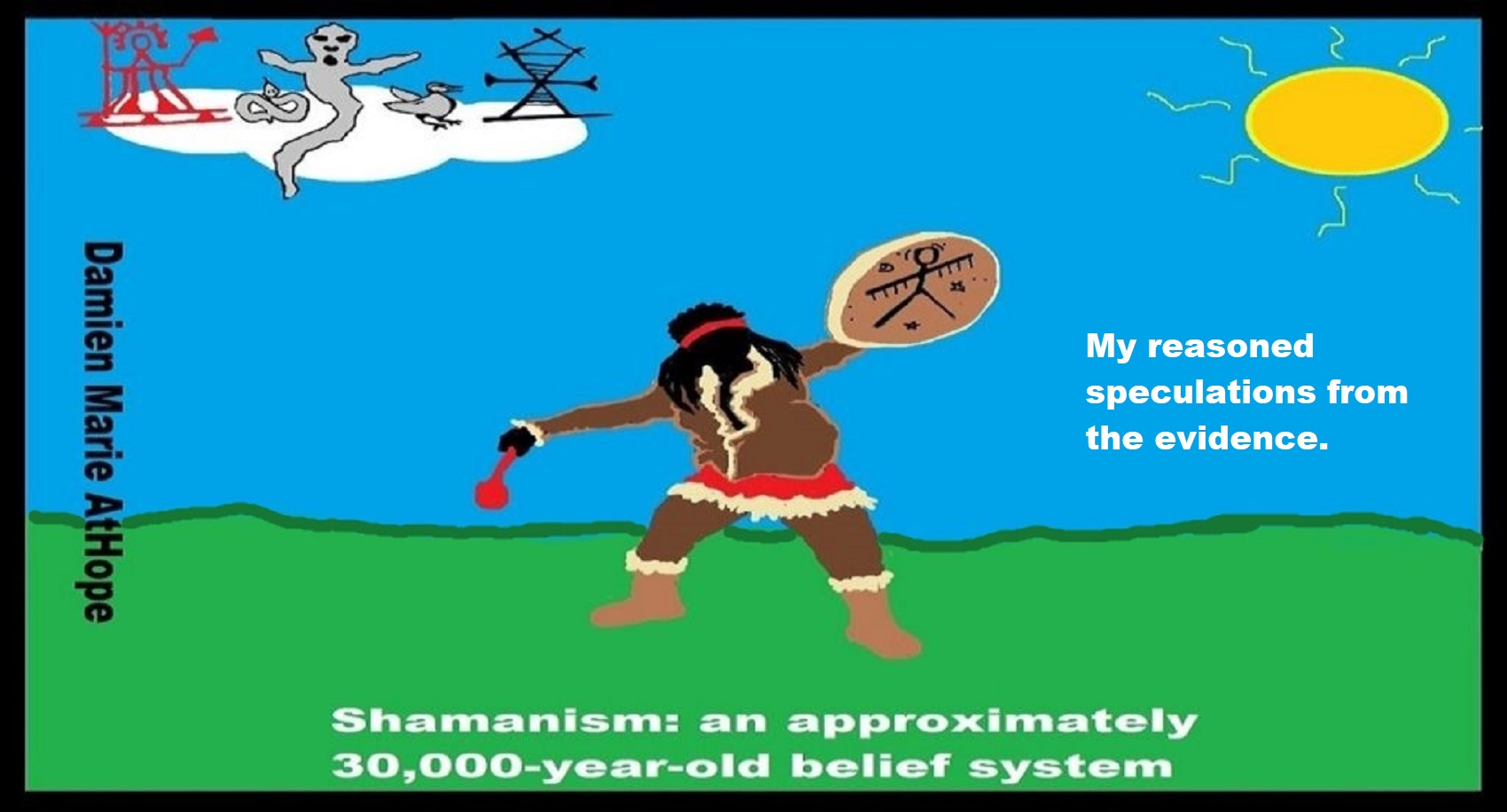
Shamanism (beginning around 30,000 years ago)
Shamanism (such as that seen in Siberia Gravettian culture: 30,000 years ago). Gravettian culture (34,000–24,000 years ago; Western Gravettian, mainly France, Spain, and Britain, as well as Eastern Gravettian in Central Europe and Russia. The eastern Gravettians, which include the Pavlovian culture). And, the Pavlovian culture (31,000 – 25,000 years ago such as in Austria and Poland). 31,000 – 20,000 years ago Oldest Shaman was Female, Buried with the Oldest Portrait Carving.
Shamanism is approximately a 30,000-year-old belief system and believe in spirit-filled life and/or afterlife that can be attached to or be expressed in things or objects and these objects can be used by special persons or in special rituals that can connect to spirit-filled life and/or afterlife. If you believe like this, regardless of your faith, you are a hidden shamanist.
Around 29,000 to 25,000 years ago in Dolní Vestonice, Czech Republic, the oldest human face representation is a carved ivory female head that was found nearby a female burial and belong to the Pavlovian culture, a variant of the Gravettian culture. The left side of the figure’s face was a distorted image and is believed to be a portrait of an elder female, who was around 40 years old. She was ritualistically placed beneath a pair of mammoth scapulae, one leaning against the other. Surprisingly, the left side of the skull was disfigured in the same manner as the aforementioned carved ivory figure, indicating that the figure was an intentional depiction of this specific individual. The bones and the earth surrounding the body contained traces of red ocher, a flint spearhead had been placed near the skull, and one hand held the body of a fox. This evidence suggests that this was the burial site of a shaman. This is the oldest site not only of ceramic figurines and artistic portraiture but also of evidence of early female shamans. Before 5,500 years ago, women were much more prominent in religion.
Archaeologists usually describe two regional variants: the western Gravettian, known namely from cave sites in France, Spain, and Britain, and the eastern Gravettian in Central Europe and Russia. The eastern Gravettians include the Pavlovian culture, which were specialized mammoth hunters and whose remains are usually found not in caves but in open air sites. The origins of the Gravettian people are not clear, they seem to appear simultaneously all over Europe. Though they carried distinct genetic signatures, the Gravettians and Aurignacians before them were descended from the same ancient founder population. According to genetic data, 37,000 years ago, all Europeans can be traced back to a single ‘founding population’ that made it through the last ice age. Furthermore, the so-called founding fathers were part of the Aurignacian culture, which was displaced by another group of early humans members of the Gravettian culture. Between 37,000 years ago and 14,000 years ago, different groups of Europeans were descended from a single founder population. To a greater extent than their Aurignacian predecessors, they are known for their Venus figurines. ref, ref, ref, ref, ref, ref, ref, ref, ref, ref, & ref

Paganism (beginning around 12,000 years ago)
Paganism (such as that seen in Turkey: 12,000 years ago). Gobekli Tepe: “first human-made temple” around 12,000 years ago. Sedentism and the Creation of goddesses around 12,000 years ago as well as male gods after 7,000 years ago. Pagan-Shaman burial in Israel 12,000 years ago and 12,000 – 10,000 years old Paganistic-Shamanistic Art in a Remote Cave in Egypt. Skull Cult around 11,500 to 8,400 Years Ago and Catal Huyuk “first religious designed city” around 10,000 years ago.
Paganism is approximately a 12,000-year-old belief system and believe in spirit-filled life and/or afterlife that can be attached to or be expressed in things or objects and these objects can be used by special persons or in special rituals that can connect to spirit-filled life and/or afterlife and who are guided/supported by a goddess/god, goddesses/gods, magical beings, or supreme spirits. If you believe like this, regardless of your faith, you are a hidden paganist.
Around 12,000 years ago, in Turkey, the first evidence of paganism is Gobekli Tepe: “first human-made temple” and around 9,500 years ago, in Turkey, the second evidence of paganism is Catal Huyuk “first religious designed city”. In addition, early paganism is connected to Proto-Indo-European language and religion. Proto-Indo-European religion can be reconstructed with confidence that the gods and goddesses, myths, festivals, and form of rituals with invocations, prayers, and songs of praise make up the spoken element of religion. Much of this activity is connected to the natural and agricultural year or at least those are the easiest elements to reconstruct because nature does not change and because farmers are the most conservative members of society and are best able to keep the old ways.
The reconstruction of goddesses/gods characteristics may be different than what we think of and only evolved later to the characteristics we know of today. One such characteristic is how a deity’s gender may not be fixed, since they are often deified forces of nature, which tend to not have genders. There are at least 40 deities and the Goddesses that have been reconstructed are: *Pria, *Pleto, *Devi, *Perkunos, *Aeusos, and *Yama.
The reconstruction of myths can be connected to Proto-Indo-European culture/language and by additional research, many of these myths have since been confirmed including some areas that were not accessible to the early writers such as Latvian folk songs and Hittite hieroglyphic tablets. There are at least 28 myths and one of the most widely recognized myths of the Indo-Europeans is the myth, “Yama is killed by his brother Manu” and “the world is made from his body”. Some of the forms of this myth in various Indo-European languages are about the Creation Myth of the Indo-Europeans.
The reconstruction of rituals can be connected to Proto-Indo-European culture/language and is estimated to have been spoken as a single language from around 6,500 years ago. One of the earliest ritual is the construction of kurgans or mound graves as a part of a death ritual. kurgans were inspired by common ritual-mythological ideas. Kurgans are complex structures with internal chambers. Within the burial chamber at the heart of the kurgan, elite individuals were buried with grave goods and sacrificial offerings, sometimes including horses and chariots.
The speakers of Pre-Proto-Indo-European lived in Turkey and it associates the distribution of historical Indo-European languages with the expansion around 9,000 years ago, with a proposed homeland of Proto-Indo-European proper in the Balkans around 7,000 years ago. The Proto-Indo-European Religion seemingly stretches at least back around 6,000 years ago or likely much further back and I believe Paganism is possibly an approximately 12,000-year-old belief system.
The earliest kurgans date to 6,000 years ago and are connected to the Proto-Indo-European in the Caucasus. In fact, around 7,000 years ago, there appears to be pre-kurgan in Siberia. Around 7,000 to 2,500 years ago and beyond, kurgans were built with ancient traditions still active in Southern Siberia and Central Asia, which display the continuity of the archaic forming methods. Kurgan cultures are divided archaeologically into different sub-cultures such as Timber Grave, Pit Grave, Scythian, Sarmatian, Hunnish, and Kuman–Kipchak. Kurgans have been found from the Altay Mountains to the Caucasus, Ukraine, Romania, and Bulgaria. Around 5,000 years ago, kurgans were used in the Ukrainian and Russian flat unforested grasslands and their use spread with migration into eastern, central, northern Europe, Turkey, and beyond. ref, ref, ref, ref, ref, ref, ref, ref, ref, ref, ref, ref, & ref

Progressed organized religion (around 5,000 years ago)
Progressed organized religion (such as that seen in Egypt: 5,000 years ago “The First Dynasty dates to 5,150 years ago”). This was a time of astonishing religion development and organization with a new state power to control. Around the time of 5,000 to 4,000 years ago, saw the growth of these riches, both intellectually and physically, became a source of contention on a political stage, and rulers sought the accumulation of more wealth and more power.
*The First Dynasty*
Date: 3,150 B.C.E. (5,150 years ago)
The Beginning Rise of the Unequal State Government Hierarchies, Religions and Cultures Merger
The Pharaoh in ancient Egypt was the political and religious leader holding the titles ‘Lord of the Two Lands’ Upper and Lower Egypt and ‘High Priest of Every Temple’. In 5,150 years ago the First Dynasty appeared in Egypt and this reign was thought to be in accordance with the will of the gods; but the office of the king itself was not associated with the divine until later.
Around 4,890 years ago during the Second Dynasty, the King was linked with the divine and reign with the will of the gods. Following this, rulers of the later dynasties were equated with the gods and with the duties and obligations due to those gods. As supreme ruler of the people, the pharaoh was considered a god on earth, the intermediary between the gods and the people, and when he died, he was thought to become Osiris, the god of the dead. As such, in his role of ‘High Priest of Every Temple’, it was the pharaoh’s duty to build great temples and monuments celebrating his own achievements and paying homage to the gods of the land. Among the earliest civilizations that exhibit the phenomenon of divinized kings are early Mesopotamia and ancient Egypt.
In 5,150 years ago the First Dynasty appeared in Egypt with the unification of Upper and Lower Egypt by the king Menes (now believed to be Narmer). Menes/Narmer is depicted on inscriptions wearing the two crowns of Egypt, signifying unification, and his reign was thought to be in accordance with the will of the gods; but the office of the king itself was not associated with the divine until later. During the Second Dynasty of Egypt 4,890-4,670 years ago King Raneb (also known as Nebra) linked his name with the divine and his reign with the will of the gods. Following Raneb, the rulers of the later dynasties were equated with the gods and with the duties and obligations due to those gods. As supreme ruler of the people, the pharaoh was considered a god on earth.
The honorific title of `pharaoh’ for a ruler did not appear until the period known as the New Kingdom 3,570-3,069 years ago. Monarchs of the dynasties before the title of `pharaoh’ from the New Kingdom were addressed as `your majesty’ by foreign dignitaries and members of the court and as `brother’ by foreign rulers; both practices would continue after the king of Egypt came to be known as a pharaoh. Ref Ref
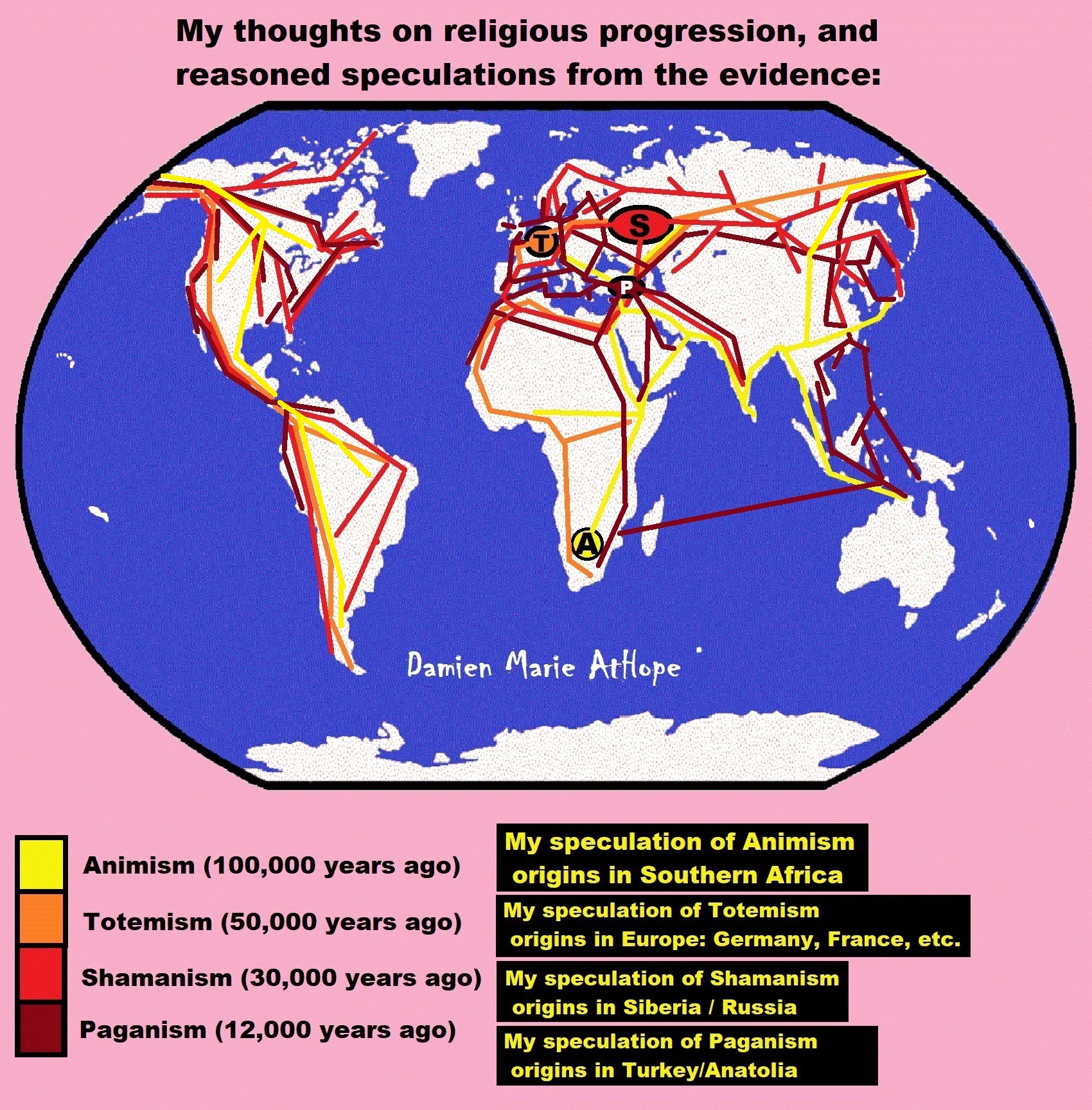
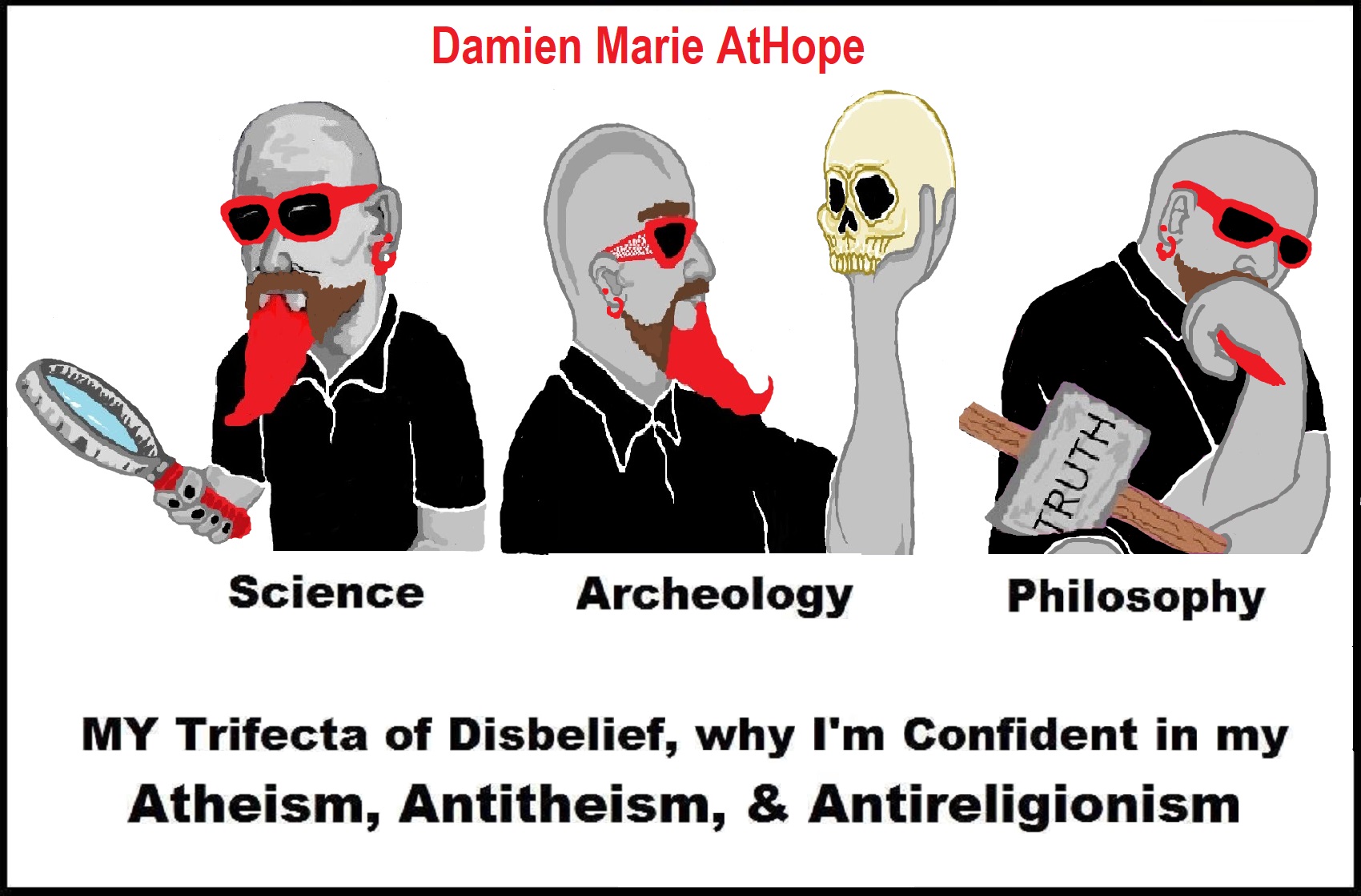
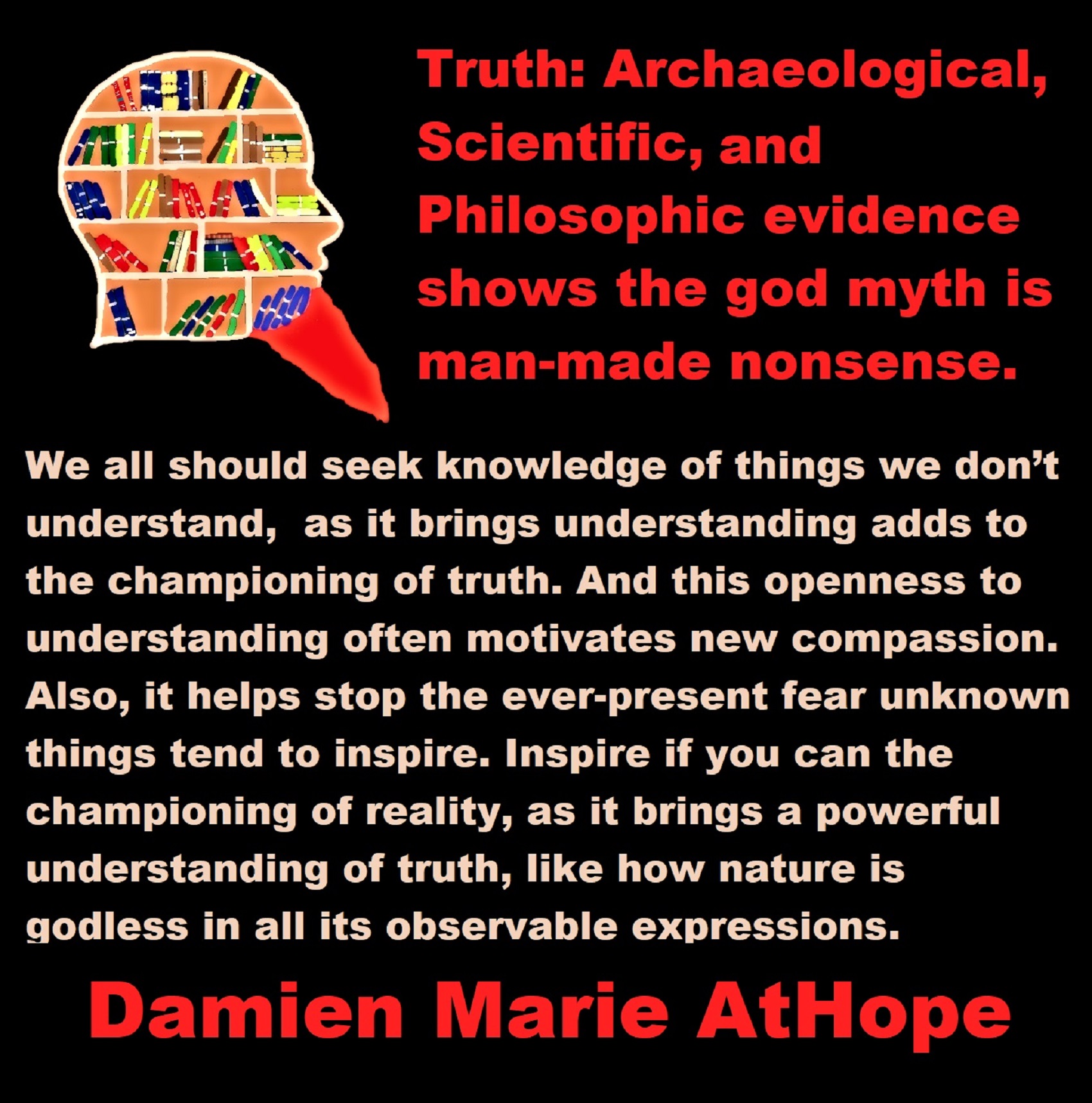
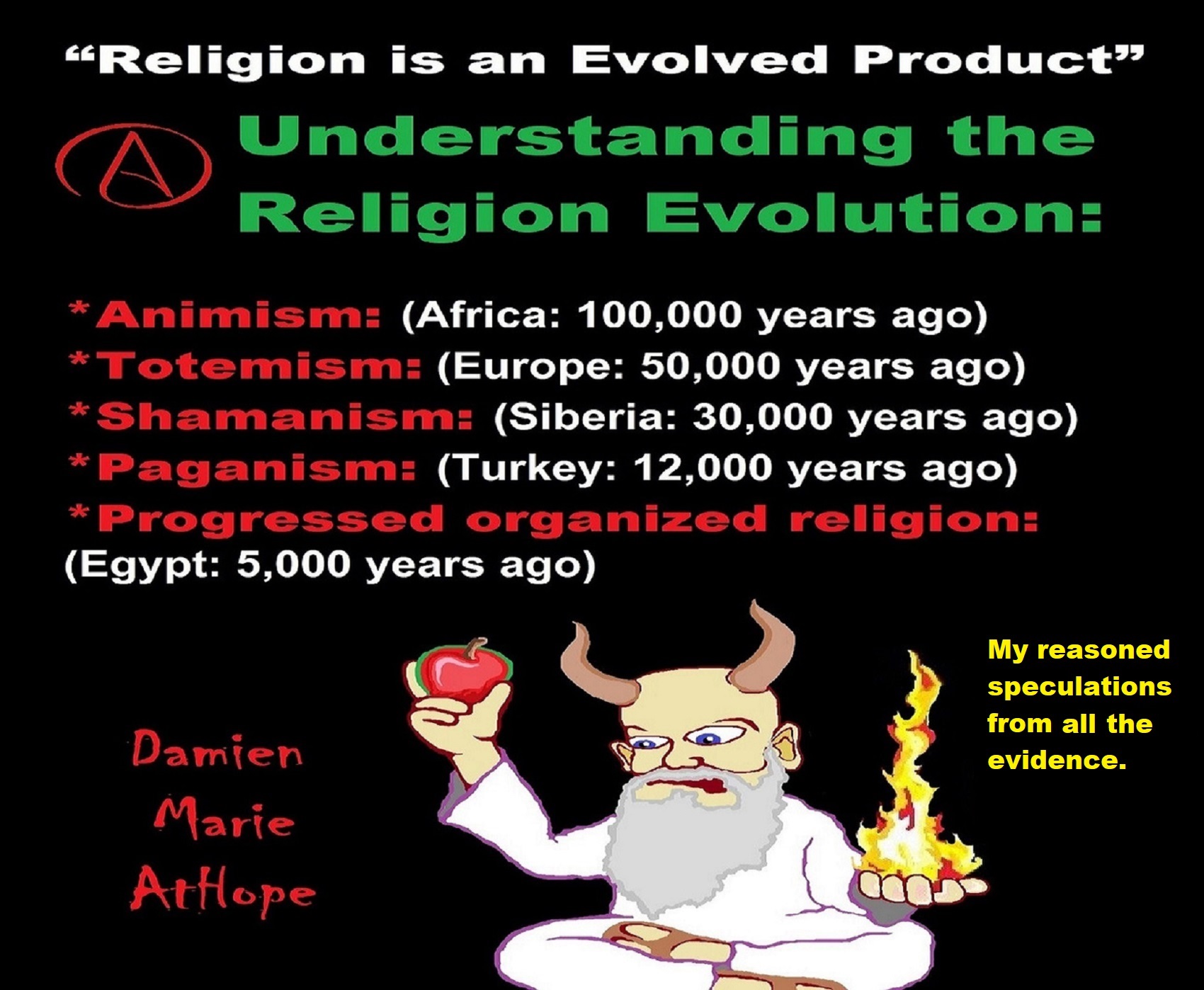
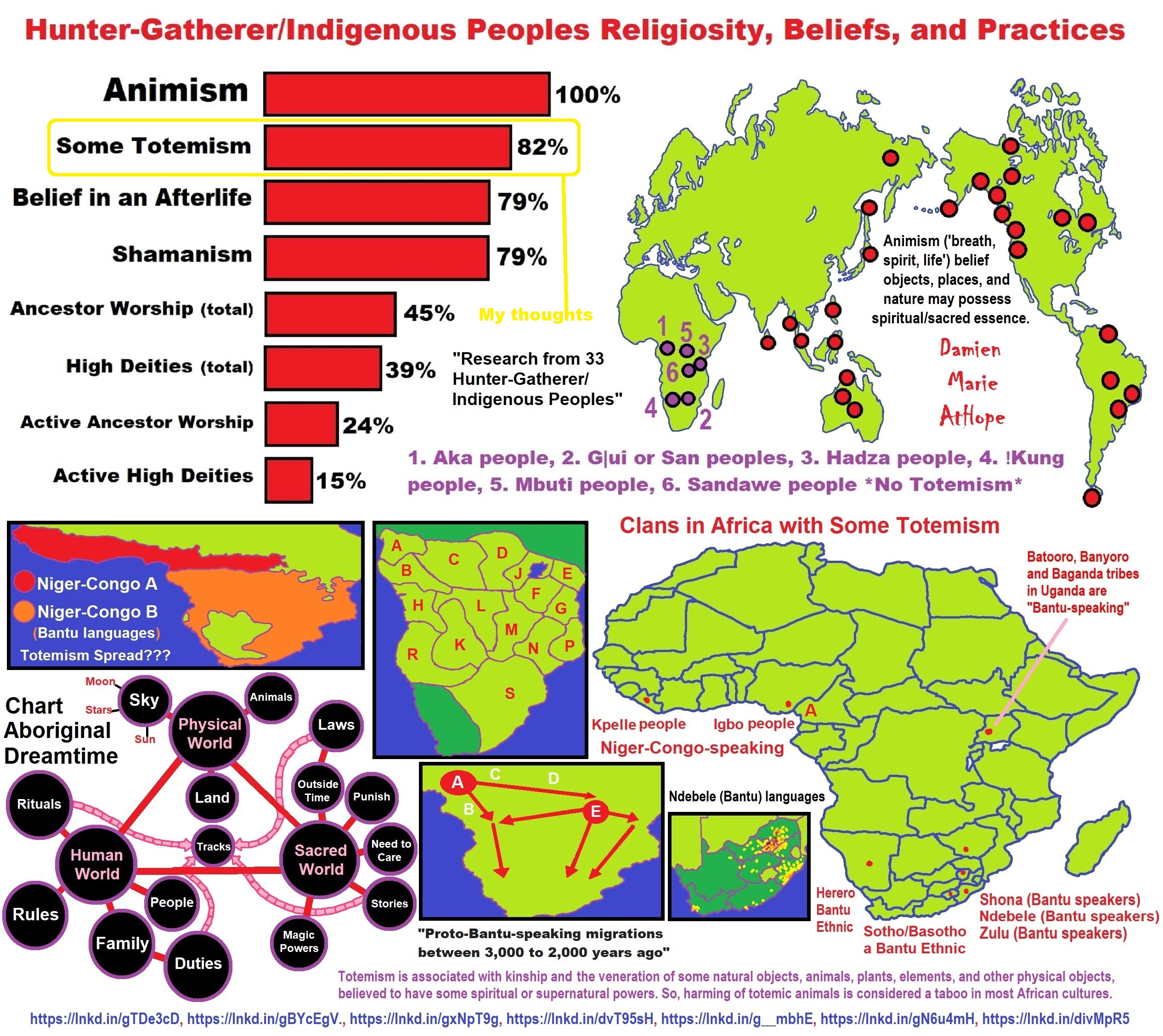
Not all “Religions” or “Religious Persuasions” have a god(s) but
All can be said to believe in some imaginary beings or imaginary things like spirits, afterlives, etc.
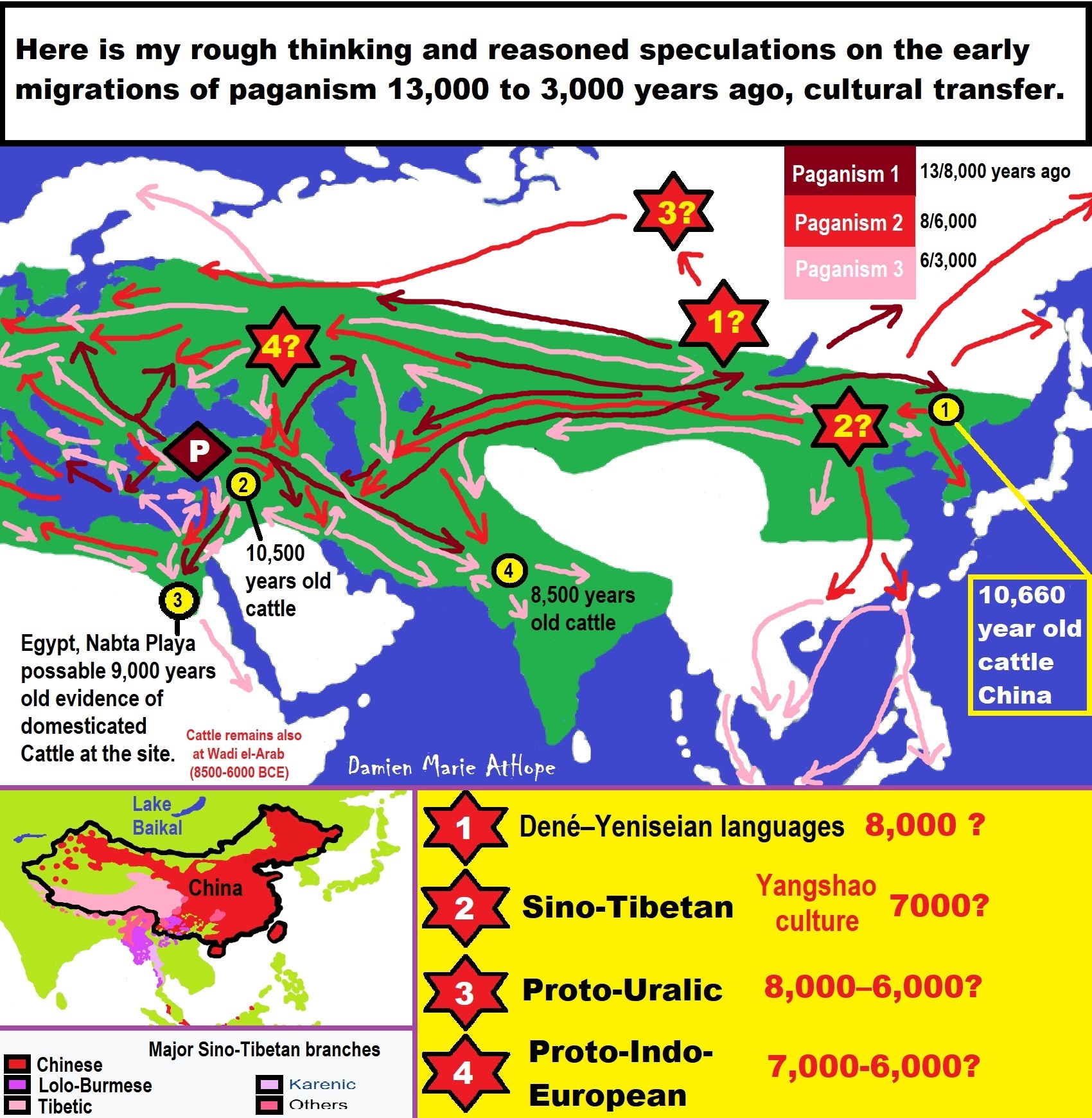
Paganism 12,000-4,000 years old
12,000-7,000 years old: related to (Pre-Capitalism)
7,000-5,000 years old: related to (Capitalism) (World War 0) Elite and their slaves!
5,000 years old: related to (Kings and the Rise of the State)
4,000 years old: related to (First Moralistic gods, then the Origin time of Monotheism)
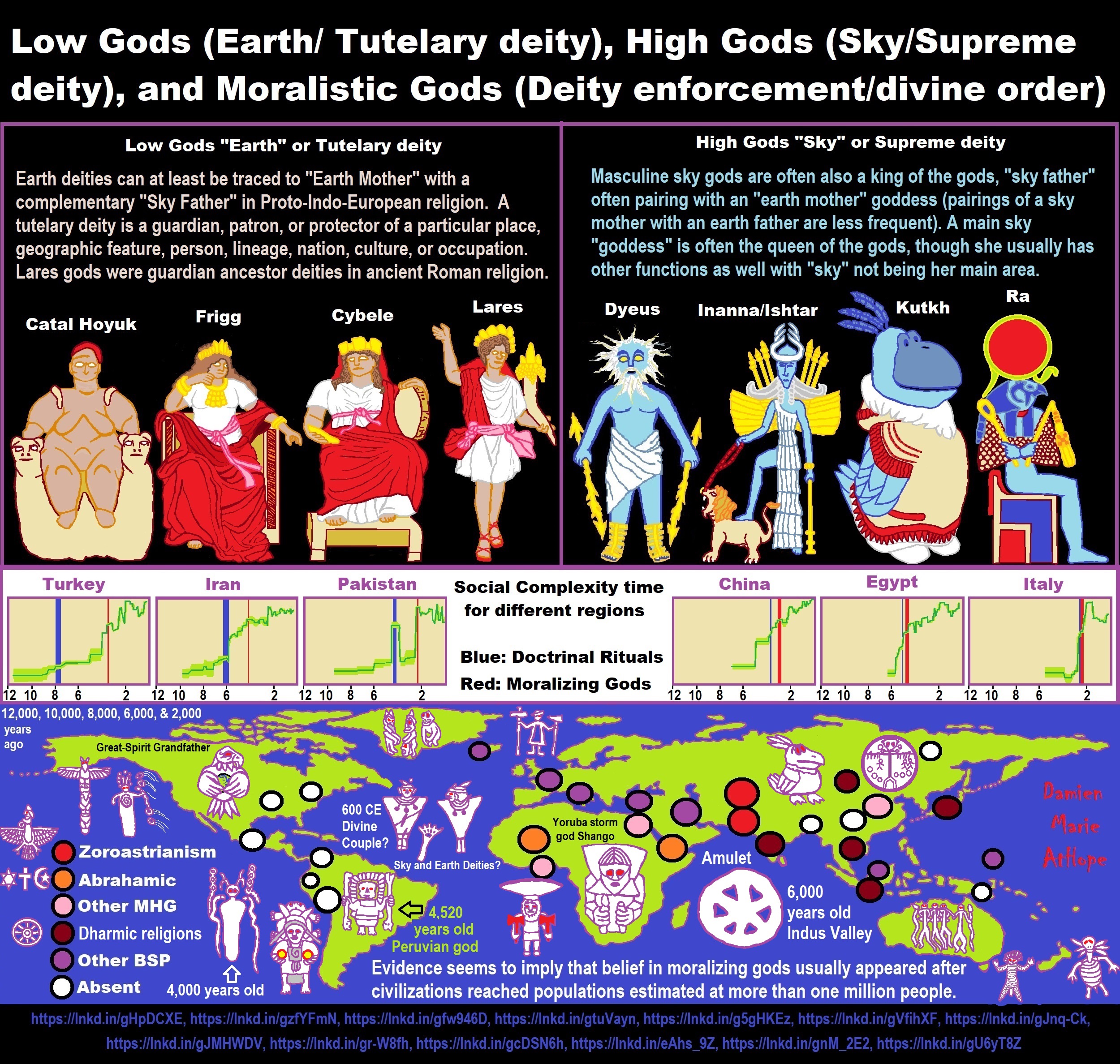
ref, ref, ref, ref, ref, ref, ref, ref, ref, ref, ref, ref, ref, ref, ref, ref, ref, ref, ref, ref, ref
Low Gods “Earth” or Tutelary deity and High Gods “Sky” or Supreme deity
“An Earth goddess is a deification of the Earth. Earth goddesses are often associated with the “chthonic” deities of the underworld. Ki and Ninhursag are Mesopotamian earth goddesses. In Greek mythology, the Earth is personified as Gaia, corresponding to Roman Terra, Indic Prithvi/Bhūmi, etc. traced to an “Earth Mother” complementary to the “Sky Father” in Proto-Indo-European religion. Egyptian mythology exceptionally has a sky goddess and an Earth god.” ref
“A mother goddess is a goddess who represents or is a personification of nature, motherhood, fertility, creation, destruction or who embodies the bounty of the Earth. When equated with the Earth or the natural world, such goddesses are sometimes referred to as Mother Earth or as the Earth Mother. In some religious traditions or movements, Heavenly Mother (also referred to as Mother in Heaven or Sky Mother) is the wife or feminine counterpart of the Sky father or God the Father.” ref
“Any masculine sky god is often also king of the gods, taking the position of patriarch within a pantheon. Such king gods are collectively categorized as “sky father” deities, with a polarity between sky and earth often being expressed by pairing a “sky father” god with an “earth mother” goddess (pairings of a sky mother with an earth father are less frequent). A main sky goddess is often the queen of the gods and may be an air/sky goddess in her own right, though she usually has other functions as well with “sky” not being her main. In antiquity, several sky goddesses in ancient Egypt, Mesopotamia, and the Near East were called Queen of Heaven. Neopagans often apply it with impunity to sky goddesses from other regions who were never associated with the term historically. The sky often has important religious significance. Many religions, both polytheistic and monotheistic, have deities associated with the sky.” ref
“In comparative mythology, sky father is a term for a recurring concept in polytheistic religions of a sky god who is addressed as a “father”, often the father of a pantheon and is often either a reigning or former King of the Gods. The concept of “sky father” may also be taken to include Sun gods with similar characteristics, such as Ra. The concept is complementary to an “earth mother“. “Sky Father” is a direct translation of the Vedic Dyaus Pita, etymologically descended from the same Proto-Indo-European deity name as the Greek Zeûs Pater and Roman Jupiter and Germanic Týr, Tir or Tiwaz, all of which are reflexes of the same Proto-Indo-European deity’s name, *Dyēus Ph₂tḗr. While there are numerous parallels adduced from outside of Indo-European mythology, there are exceptions (e.g. In Egyptian mythology, Nut is the sky mother and Geb is the earth father).” ref
Tutelary deity
“A tutelary (also tutelar) is a deity or spirit who is a guardian, patron, or protector of a particular place, geographic feature, person, lineage, nation, culture, or occupation. The etymology of “tutelary” expresses the concept of safety and thus of guardianship. In late Greek and Roman religion, one type of tutelary deity, the genius, functions as the personal deity or daimon of an individual from birth to death. Another form of personal tutelary spirit is the familiar spirit of European folklore.” ref
“A tutelary (also tutelar) in Korean shamanism, jangseung and sotdae were placed at the edge of villages to frighten off demons. They were also worshiped as deities. Seonangshin is the patron deity of the village in Korean tradition and was believed to embody the Seonangdang. In Philippine animism, Diwata or Lambana are deities or spirits that inhabit sacred places like mountains and mounds and serve as guardians. Such as: Maria Makiling is the deity who guards Mt. Makiling and Maria Cacao and Maria Sinukuan. In Shinto, the spirits, or kami, which give life to human bodies come from nature and return to it after death. Ancestors are therefore themselves tutelaries to be worshiped. And similarly, Native American beliefs such as Tonás, tutelary animal spirit among the Zapotec and Totems, familial or clan spirits among the Ojibwe, can be animals.” ref
“A tutelary (also tutelar) in Austronesian beliefs such as: Atua (gods and spirits of the Polynesian peoples such as the Māori or the Hawaiians), Hanitu (Bunun of Taiwan‘s term for spirit), Hyang (Kawi, Sundanese, Javanese, and Balinese Supreme Being, in ancient Java and Bali mythology and this spiritual entity, can be either divine or ancestral), Kaitiaki (New Zealand Māori term used for the concept of guardianship, for the sky, the sea, and the land), Kawas (mythology) (divided into 6 groups: gods, ancestors, souls of the living, spirits of living things, spirits of lifeless objects, and ghosts), Tiki (Māori mythology, Tiki is the first man created by either Tūmatauenga or Tāne and represents deified ancestors found in most Polynesian cultures). ” ref, ref, ref, ref, ref, ref, ref
Mesopotamian Tutelary Deities can be seen as ones related to City-States
“Historical city-states included Sumerian cities such as Uruk and Ur; Ancient Egyptian city-states, such as Thebes and Memphis; the Phoenician cities (such as Tyre and Sidon); the five Philistine city-states; the Berber city-states of the Garamantes; the city-states of ancient Greece (the poleis such as Athens, Sparta, Thebes, and Corinth); the Roman Republic (which grew from a city-state into a vast empire); the Italian city-states from the Middle Ages to the early modern period, such as Florence, Siena, Ferrara, Milan (which as they grew in power began to dominate neighboring cities) and Genoa and Venice, which became powerful thalassocracies; the Mayan and other cultures of pre-Columbian Mesoamerica (including cities such as Chichen Itza, Tikal, Copán and Monte Albán); the central Asian cities along the Silk Road; the city-states of the Swahili coast; Ragusa; states of the medieval Russian lands such as Novgorod and Pskov; and many others.” ref
“The Uruk period (ca. 4000 to 3100 BCE; also known as Protoliterate period) of Mesopotamia, named after the Sumerian city of Uruk, this period saw the emergence of urban life in Mesopotamia and the Sumerian civilization. City-States like Uruk and others had a patron tutelary City Deity along with a Priest-King.” ref
“Chinese folk religion, both past, and present, includes myriad tutelary deities. Exceptional individuals, highly cultivated sages, and prominent ancestors can be deified and honored after death. Lord Guan is the patron of military personnel and police, while Mazu is the patron of fishermen and sailors. Such as Tu Di Gong (Earth Deity) is the tutelary deity of a locality, and each individual locality has its own Earth Deity and Cheng Huang Gong (City God) is the guardian deity of an individual city, worshipped by local officials and locals since imperial times.” ref
“A tutelary (also tutelar) in Hinduism, personal tutelary deities are known as ishta-devata, while family tutelary deities are known as Kuladevata. Gramadevata are guardian deities of villages. Devas can also be seen as tutelary. Shiva is the patron of yogis and renunciants. City goddesses include: Mumbadevi (Mumbai), Sachchika (Osian); Kuladevis include: Ambika (Porwad), and Mahalakshmi. In NorthEast India Meitei mythology and religion (Sanamahism) of Manipur, there are various types of tutelary deities, among which Lam Lais are the most predominant ones. Tibetan Buddhism has Yidam as a tutelary deity. Dakini is the patron of those who seek knowledge.” ref
“A tutelary (also tutelar) The Greeks also thought deities guarded specific places: for instance, Athena was the patron goddess of the city of Athens. Socrates spoke of hearing the voice of his personal spirit or daimonion:
You have often heard me speak of an oracle or sign which comes to me … . This sign I have had ever since I was a child. The sign is a voice which comes to me and always forbids me to do something which I am going to do, but never commands me to do anything, and this is what stands in the way of my being a politician.” ref
“Tutelary deities who guard and preserve a place or a person are fundamental to ancient Roman religion. The tutelary deity of a man was his Genius, that of a woman her Juno. In the Imperial era, the Genius of the Emperor was a focus of Imperial cult. An emperor might also adopt a major deity as his personal patron or tutelary, as Augustus did Apollo. Precedents for claiming the personal protection of a deity were established in the Republican era, when for instance the Roman dictator Sulla advertised the goddess Victory as his tutelary by holding public games (ludi) in her honor.” ref
“Each town or city had one or more tutelary deities, whose protection was considered particularly vital in time of war and siege. Rome itself was protected by a goddess whose name was to be kept ritually secret on pain of death (for a supposed case, see Quintus Valerius Soranus). The Capitoline Triad of Juno, Jupiter, and Minerva were also tutelaries of Rome. The Italic towns had their own tutelary deities. Juno often had this function, as at the Latin town of Lanuvium and the Etruscan city of Veii, and was often housed in an especially grand temple on the arx (citadel) or other prominent or central location. The tutelary deity of Praeneste was Fortuna, whose oracle was renowned.” ref
“The Roman ritual of evocatio was premised on the belief that a town could be made vulnerable to military defeat if the power of its tutelary deity were diverted outside the city, perhaps by the offer of superior cult at Rome. The depiction of some goddesses such as the Magna Mater (Great Mother, or Cybele) as “tower-crowned” represents their capacity to preserve the city. A town in the provinces might adopt a deity from within the Roman religious sphere to serve as its guardian, or syncretize its own tutelary with such; for instance, a community within the civitas of the Remi in Gaul adopted Apollo as its tutelary, and at the capital of the Remi (present-day Rheims), the tutelary was Mars Camulus.” ref
Household deity (a kind of or related to a Tutelary deity)
“A household deity is a deity or spirit that protects the home, looking after the entire household or certain key members. It has been a common belief in paganism as well as in folklore across many parts of the world. Household deities fit into two types; firstly, a specific deity – typically a goddess – often referred to as a hearth goddess or domestic goddess who is associated with the home and hearth, such as the ancient Greek Hestia.” ref
“The second type of household deities are those that are not one singular deity, but a type, or species of animistic deity, who usually have lesser powers than major deities. This type was common in the religions of antiquity, such as the Lares of ancient Roman religion, the Gashin of Korean shamanism, and Cofgodas of Anglo-Saxon paganism. These survived Christianisation as fairy-like creatures existing in folklore, such as the Anglo-Scottish Brownie and Slavic Domovoy.” ref
“Household deities were usually worshipped not in temples but in the home, where they would be represented by small idols (such as the teraphim of the Bible, often translated as “household gods” in Genesis 31:19 for example), amulets, paintings, or reliefs. They could also be found on domestic objects, such as cosmetic articles in the case of Tawaret. The more prosperous houses might have a small shrine to the household god(s); the lararium served this purpose in the case of the Romans. The gods would be treated as members of the family and invited to join in meals, or be given offerings of food and drink.” ref
“In many religions, both ancient and modern, a god would preside over the home. Certain species, or types, of household deities, existed. An example of this was the Roman Lares. Many European cultures retained house spirits into the modern period. Some examples of these include:
- Brownie (Scotland and England) or Hob (England) / Kobold (Germany) / Goblin / Hobgoblin
- Domovoy (Slavic)
- Nisse (Norwegian or Danish) / Tomte (Swedish) / Tonttu (Finnish)
- Húsvættir (Norse)” ref
“Although the cosmic status of household deities was not as lofty as that of the Twelve Olympians or the Aesir, they were also jealous of their dignity and also had to be appeased with shrines and offerings, however humble. Because of their immediacy they had arguably more influence on the day-to-day affairs of men than the remote gods did. Vestiges of their worship persisted long after Christianity and other major religions extirpated nearly every trace of the major pagan pantheons. Elements of the practice can be seen even today, with Christian accretions, where statues to various saints (such as St. Francis) protect gardens and grottos. Even the gargoyles found on older churches, could be viewed as guardians partitioning a sacred space.” ref
“For centuries, Christianity fought a mop-up war against these lingering minor pagan deities, but they proved tenacious. For example, Martin Luther‘s Tischreden have numerous – quite serious – references to dealing with kobolds. Eventually, rationalism and the Industrial Revolution threatened to erase most of these minor deities, until the advent of romantic nationalism rehabilitated them and embellished them into objects of literary curiosity in the 19th century. Since the 20th century this literature has been mined for characters for role-playing games, video games, and other fantasy personae, not infrequently invested with invented traits and hierarchies somewhat different from their mythological and folkloric roots.” ref
“In contradistinction to both Herbert Spencer and Edward Burnett Tylor, who defended theories of animistic origins of ancestor worship, Émile Durkheim saw its origin in totemism. In reality, this distinction is somewhat academic, since totemism may be regarded as a particularized manifestation of animism, and something of a synthesis of the two positions was attempted by Sigmund Freud. In Freud’s Totem and Taboo, both totem and taboo are outward expressions or manifestations of the same psychological tendency, a concept which is complementary to, or which rather reconciles, the apparent conflict. Freud preferred to emphasize the psychoanalytic implications of the reification of metaphysical forces, but with particular emphasis on its familial nature. This emphasis underscores, rather than weakens, the ancestral component.” ref
“William Edward Hearn, a noted classicist, and jurist, traced the origin of domestic deities from the earliest stages as an expression of animism, a belief system thought to have existed also in the neolithic, and the forerunner of Indo-European religion. In his analysis of the Indo-European household, in Chapter II “The House Spirit”, Section 1, he states:
The belief which guided the conduct of our forefathers was … the spirit rule of dead ancestors.” ref
“In Section 2 he proceeds to elaborate:
It is thus certain that the worship of deceased ancestors is a vera causa, and not a mere hypothesis. …
In the other European nations, the Slavs, the Teutons, and the Kelts, the House Spirit appears with no less distinctness. … [T]he existence of that worship does not admit of doubt. … The House Spirits had a multitude of other names which it is needless here to enumerate, but all of which are more or less expressive of their friendly relations with man. … In [England] … [h]e is the Brownie. … In Scotland this same Brownie is well known. He is usually described as attached to particular families, with whom he has been known to reside for centuries, threshing the corn, cleaning the house, and performing similar household tasks. His favorite gratification was milk and honey.” ref
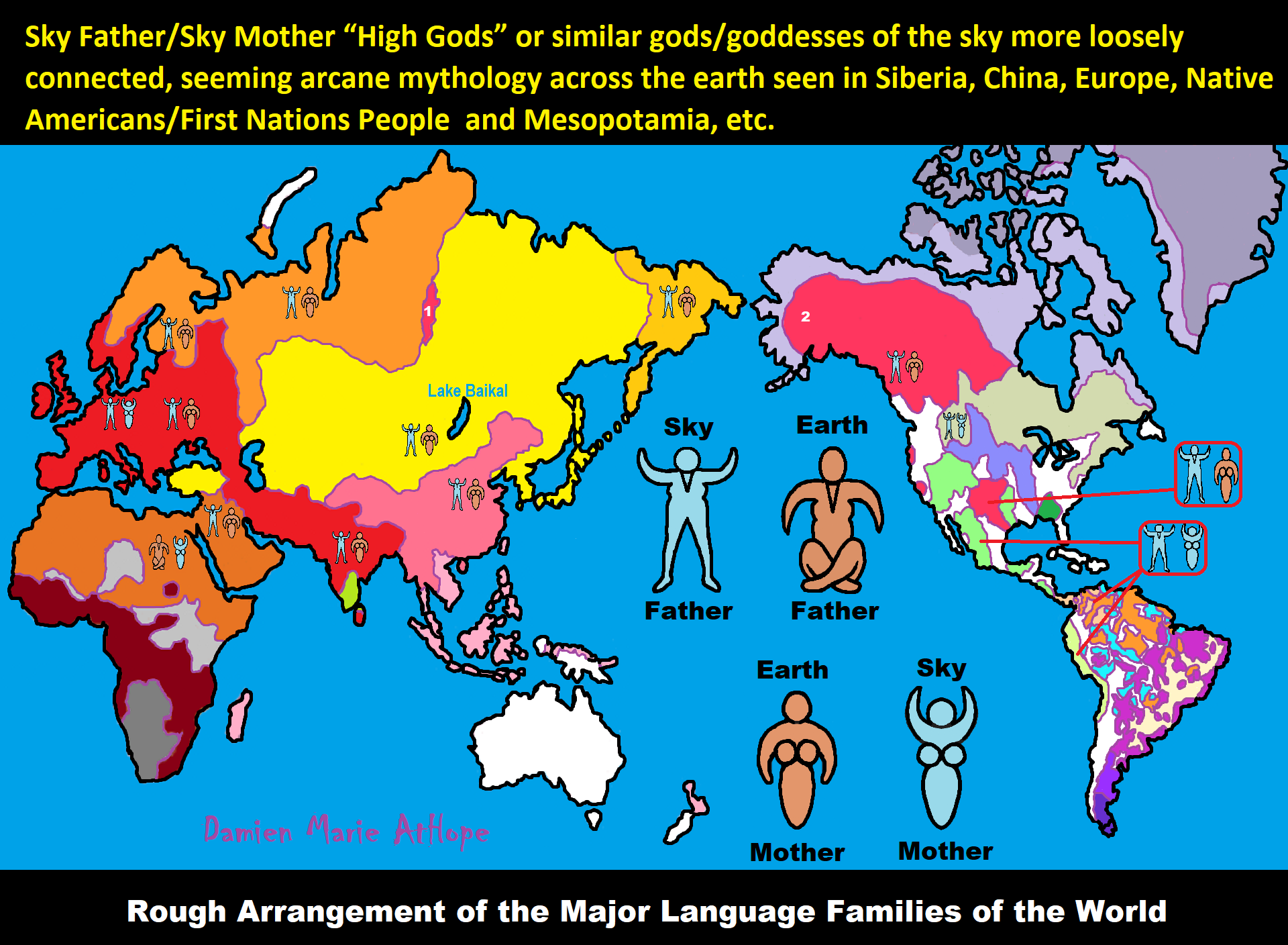
ref, ref, ref, ref, ref, ref, ref, ref, ref, ref, ref, ref, ref, ref, ref, ref, ref
“These ideas are my speculations from the evidence.”
I am still researching the “god‘s origins” all over the world. So you know, it is very complicated but I am smart and willing to look, DEEP, if necessary, which going very deep does seem to be needed here, when trying to actually understand the evolution of gods and goddesses. I am sure of a few things and less sure of others, but even in stuff I am not fully grasping I still am slowly figuring it out, to explain it to others. But as I research more I am understanding things a little better, though I am still working on understanding it all or something close and thus always figuring out more.
Sky Father/Sky God?
“Egyptian: (Nut) Sky Mother and (Geb) Earth Father” (Egypt is different but similar)
Turkic/Mongolic: (Tengri/Tenger Etseg) Sky Father and (Eje/Gazar Eej) Earth Mother *Transeurasian*
Hawaiian: (Wākea) Sky Father and (Papahānaumoku) Earth Mother *Austronesian*
New Zealand/ Māori: (Ranginui) Sky Father and (Papatūānuku) Earth Mother *Austronesian*
Proto-Indo-European: (Dyḗus/Dyḗus ph₂tḗr) Sky Father and (Dʰéǵʰōm/Pleth₂wih₁) Earth Mother
Indo-Aryan: (Dyaus Pita) Sky Father and (Prithvi Mata) Earth Mother *Indo-European*
Italic: (Jupiter) Sky Father and (Juno) Sky Mother *Indo-European*
Etruscan: (Tinia) Sky Father and (Uni) Sky Mother *Tyrsenian/Italy Pre–Indo-European*
Hellenic/Greek: (Zeus) Sky Father and (Hera) Sky Mother who started as an “Earth Goddess” *Indo-European*
Nordic: (Dagr) Sky Father and (Nótt) Sky Mother *Indo-European*
Slavic: (Perun) Sky Father and (Mokosh) Earth Mother *Indo-European*
Illyrian: (Deipaturos) Sky Father and (Messapic Damatura’s “earth-mother” maybe) Earth Mother *Indo-European*
Albanian: (Zojz) Sky Father and (?) *Indo-European*
Baltic: (Perkūnas) Sky Father and (Saulė) Sky Mother *Indo-European*
Germanic: (Týr) Sky Father and (?) *Indo-European*
Colombian-Muisca: (Bochica) Sky Father and (Huythaca) Sky Mother *Chibchan*
Aztec: (Quetzalcoatl) Sky Father and (Xochiquetzal) Sky Mother *Uto-Aztecan*
Incan: (Viracocha) Sky Father and (Mama Runtucaya) Sky Mother *Quechuan*
China: (Tian/Shangdi) Sky Father and (Dì) Earth Mother *Sino-Tibetan*
Sumerian, Assyrian and Babylonian: (An/Anu) Sky Father and (Ki) Earth Mother
Finnish: (Ukko) Sky Father and (Akka) Earth Mother *Finno-Ugric*
Sami: (Horagalles) Sky Father and (Ravdna) Earth Mother *Finno-Ugric*
Puebloan-Zuni: (Ápoyan Ta’chu) Sky Father and (Áwitelin Tsíta) Earth Mother
Puebloan-Hopi: (Tawa) Sky Father and (Kokyangwuti/Spider Woman/Grandmother) Earth Mother *Uto-Aztecan*
Puebloan-Navajo: (Tsohanoai) Sky Father and (Estsanatlehi) Earth Mother *Na-Dene*
ref, ref, ref, ref, ref, ref, ref, ref, ref, ref, ref, ref, ref, ref, ref, ref, ref, ref, ref, ref, ref, ref, ref, ref, ref, ref, ref
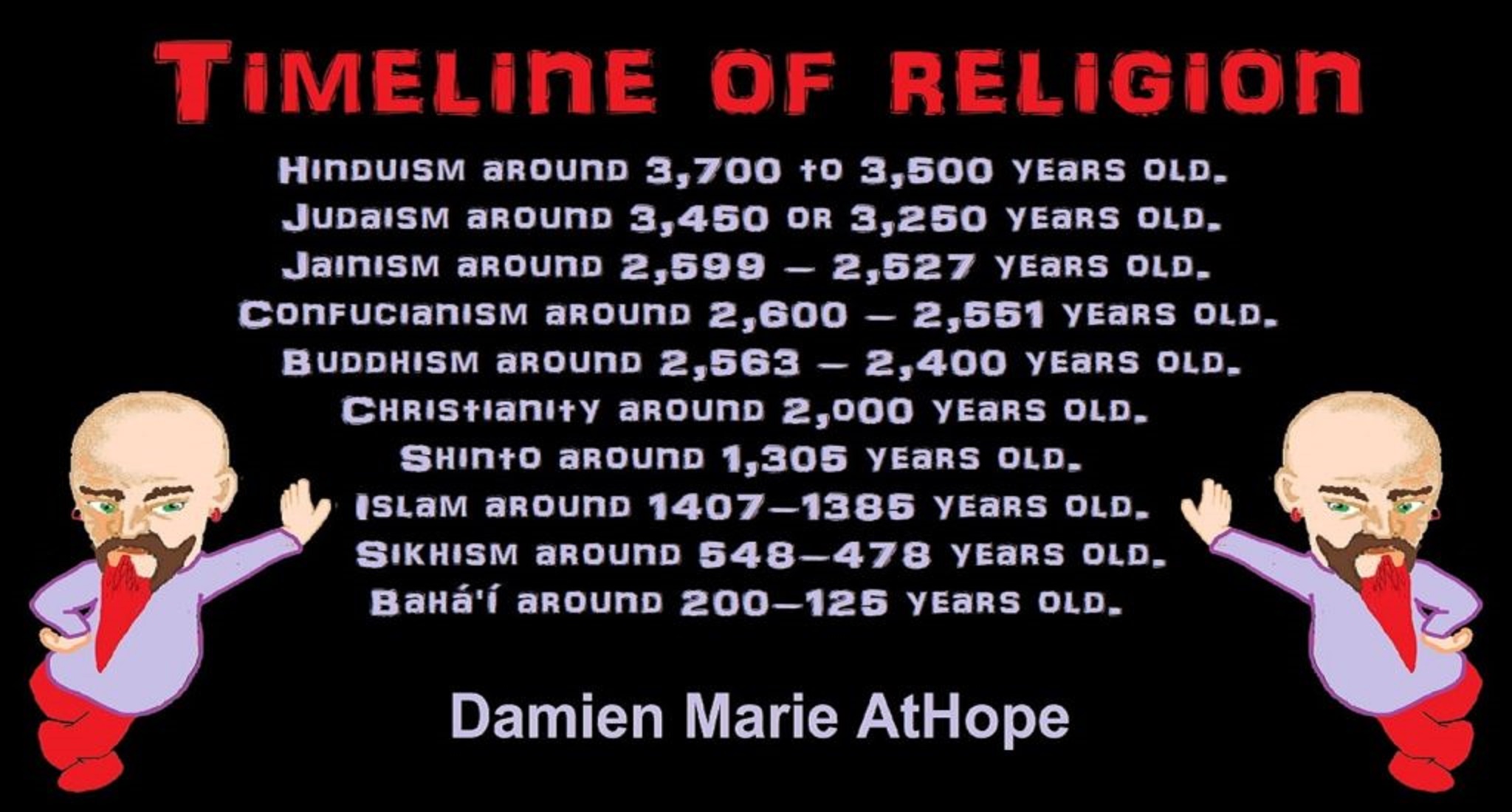
Hinduism around 3,700 to 3,500 years old. ref
Judaism around 3,450 or 3,250 years old. (The first writing in the bible was “Paleo-Hebrew” dated to around 3,000 years ago Khirbet Qeiyafa is the site of an ancient fortress city overlooking the Elah Valley. And many believe the religious Jewish texts were completed around 2,500) ref, ref
Judaism is around 3,450 or 3,250 years old. (“Paleo-Hebrew” 3,000 years ago and Torah 2,500 years ago)
“Judaism is an Abrahamic, its roots as an organized religion in the Middle East during the Bronze Age. Some scholars argue that modern Judaism evolved from Yahwism, the religion of ancient Israel and Judah, by the late 6th century BCE, and is thus considered to be one of the oldest monotheistic religions.” ref
“Yahwism is the name given by modern scholars to the religion of ancient Israel, essentially polytheistic, with a plethora of gods and goddesses. Heading the pantheon was Yahweh, the national god of the Israelite kingdoms of Israel and Judah, with his consort, the goddess Asherah; below them were second-tier gods and goddesses such as Baal, Shamash, Yarikh, Mot, and Astarte, all of whom had their own priests and prophets and numbered royalty among their devotees, and a third and fourth tier of minor divine beings, including the mal’ak, the messengers of the higher gods, who in later times became the angels of Judaism, Christianity and Islam. Yahweh, however, was not the ‘original’ god of Israel “Isra-El”; it is El, the head of the Canaanite pantheon, whose name forms the basis of the name “Israel”, and none of the Old Testament patriarchs, the tribes of Israel, the Judges, or the earliest monarchs, have a Yahwistic theophoric name (i.e., one incorporating the name of Yahweh).” ref
“El is a Northwest Semitic word meaning “god” or “deity“, or referring (as a proper name) to any one of multiple major ancient Near Eastern deities. A rarer form, ‘ila, represents the predicate form in Old Akkadian and in Amorite. The word is derived from the Proto-Semitic *ʔil-, meaning “god”. Specific deities known as ‘El or ‘Il include the supreme god of the ancient Canaanite religion and the supreme god of East Semitic speakers in Mesopotamia’s Early Dynastic Period. ʼĒl is listed at the head of many pantheons. In some Canaanite and Ugaritic sources, ʼĒl played a role as father of the gods, of creation, or both. For example, in the Ugaritic texts, ʾil mlk is understood to mean “ʼĒl the King” but ʾil hd as “the god Hadad“. The Semitic root ʾlh (Arabic ʾilāh, Aramaic ʾAlāh, ʾElāh, Hebrew ʾelōah) may be ʾl with a parasitic h, and ʾl may be an abbreviated form of ʾlh. In Ugaritic the plural form meaning “gods” is ʾilhm, equivalent to Hebrew ʾelōhîm “powers”. In the Hebrew texts this word is interpreted as being semantically singular for “god” by biblical commentators. However the documentary hypothesis for the Old Testament (corresponds to the Jewish Torah) developed originally in the 1870s, identifies these that different authors – the Jahwist, Elohist, Deuteronomist, and the Priestly source – were responsible for editing stories from a polytheistic religion into those of a monotheistic religion. Inconsistencies that arise between monotheism and polytheism in the texts are reflective of this hypothesis.” ref
Jainism around 2,599 – 2,527 years old. ref
Confucianism around 2,600 – 2,551 years old. ref
Buddhism around 2,563/2,480 – 2,483/2,400 years old. ref
Christianity around 2,o00 years old. ref
Shinto around 1,305 years old. ref
Islam around 1407–1385 years old. ref

Knowledge to Ponder:
Stars/Astrology:
- Possibly, around 30,000 years ago (in simpler form) to 6,000 years ago, Stars/Astrology are connected to Ancestors, Spirit Animals, and Deities.
- The star also seems to be a possible proto-star for Star of Ishtar, Star of Inanna, or Star of Venus.
- Around 7,000 to 6,000 years ago, Star Constellations/Astrology have connections to the “Kurgan phenomenon” of below-ground “mound” stone/wood burial structures and “Dolmen phenomenon” of above-ground stone burial structures.
- Around 6,500–5,800 years ago, The Northern Levant migrations into Jordon and Israel in the Southern Levant brought new cultural and religious transfer from Turkey and Iran.
- “The Ghassulian Star,” a mysterious 6,000-year-old mural from Jordan may have connections to the European paganstic kurgan/dolmens phenomenon.
“Astrology is a range of divinatory practices, recognized as pseudoscientific since the 18th century, that claim to discern information about human affairs and terrestrial events by studying the apparent positions of celestial objects. Different cultures have employed forms of astrology since at least the 2nd millennium BCE, these practices having originated in calendrical systems used to predict seasonal shifts and to interpret celestial cycles as signs of divine communications. Most, if not all, cultures have attached importance to what they observed in the sky, and some—such as the Hindus, Chinese, and the Maya—developed elaborate systems for predicting terrestrial events from celestial observations. Western astrology, one of the oldest astrological systems still in use, can trace its roots to 19th–17th century BCE Mesopotamia, from where it spread to Ancient Greece, Rome, the Islamicate world and eventually Central and Western Europe. Contemporary Western astrology is often associated with systems of horoscopes that purport to explain aspects of a person’s personality and predict significant events in their lives based on the positions of celestial objects; the majority of professional astrologers rely on such systems.” ref
Around 5,500 years ago, Science evolves, The first evidence of science was 5,500 years ago and was demonstrated by a body of empirical, theoretical, and practical knowledge about the natural world. ref
Around 5,000 years ago, Origin of Logics is a Naturalistic Observation (principles of valid reasoning, inference, & demonstration) ref
Around 4,150 to 4,000 years ago: The earliest surviving versions of the Sumerian Epic of Gilgamesh, which was originally titled “He who Saw the Deep” (Sha naqba īmuru) or “Surpassing All Other Kings” (Shūtur eli sharrī) were written. ref
Hinduism:
- 3,700 years ago or so, the oldest of the Hindu Vedas (scriptures), the Rig Veda was composed.
- 3,500 years ago or so, the Vedic Age began in India after the collapse of the Indus Valley Civilization.
Judaism:
- around 3,000 years ago, the first writing in the bible was “Paleo-Hebrew”
- around 2,500 years ago, many believe the religious Jewish texts were completed
Myths: The bible inspired religion is not just one religion or one myth but a grouping of several religions and myths
- Around 3,450 or 3,250 years ago, according to legend, is the traditionally accepted period in which the Israelite lawgiver, Moses, provided the Ten Commandments.
- Around 2,500 to 2,400 years ago, a collection of ancient religious writings by the Israelites based primarily upon the Hebrew Bible, Tanakh, or Old Testament is the first part of Christianity’s bible.
- Around 2,400 years ago, the most accepted hypothesis is that the canon was formed in stages, first the Pentateuch (Torah).
- Around 2,140 to 2,116 years ago, the Prophets was written during the Hasmonean dynasty, and finally the remaining books.
- Christians traditionally divide the Old Testament into four sections:
- The first five books or Pentateuch (Torah).
- The proposed history books telling the history of the Israelites from their conquest of Canaan to their defeat and exile in Babylon.
- The poetic and proposed “Wisdom books” dealing, in various forms, with questions of good and evil in the world.
- The books of the biblical prophets, warning of the consequences of turning away from God:
- Henotheism:
- Exodus 20:23 “You shall not make other gods besides Me (not saying there are no other gods just not to worship them); gods of silver or gods of gold, you shall not make for yourselves.”
- Polytheism:
- Judges 10:6 “Then the sons of Israel again did evil in the sight of the LORD, served the Baals and the Ashtaroth, the gods of Aram, the gods of Sidon, the gods of Moab, the gods of the sons of Ammon, and the gods of the Philistines; thus they forsook the LORD and did not serve Him.”
- 1 Corinthians 8:5 “For even if there are so-called gods whether in heaven or on earth, as indeed there are many gods and many lords.”
- Monotheism:
- Isaiah 43:10 “You are my witnesses,” declares the LORD, “and my servant whom I have chosen, so that you may know and believe me and understand that I am he. Before me no god was formed, nor will there be one after me.
Around 2,570 to 2,270 Years Ago, there is a confirmation of atheistic doubting as well as atheistic thinking, mainly by Greek philosophers. However, doubting gods is likely as old as the invention of gods and should destroy the thinking that belief in god(s) is the “default belief”. The Greek word is apistos (a “not” and pistos “faithful,”), thus not faithful or faithless because one is unpersuaded and unconvinced by a god(s) claim. Short Definition: unbelieving, unbeliever, or unbelief.
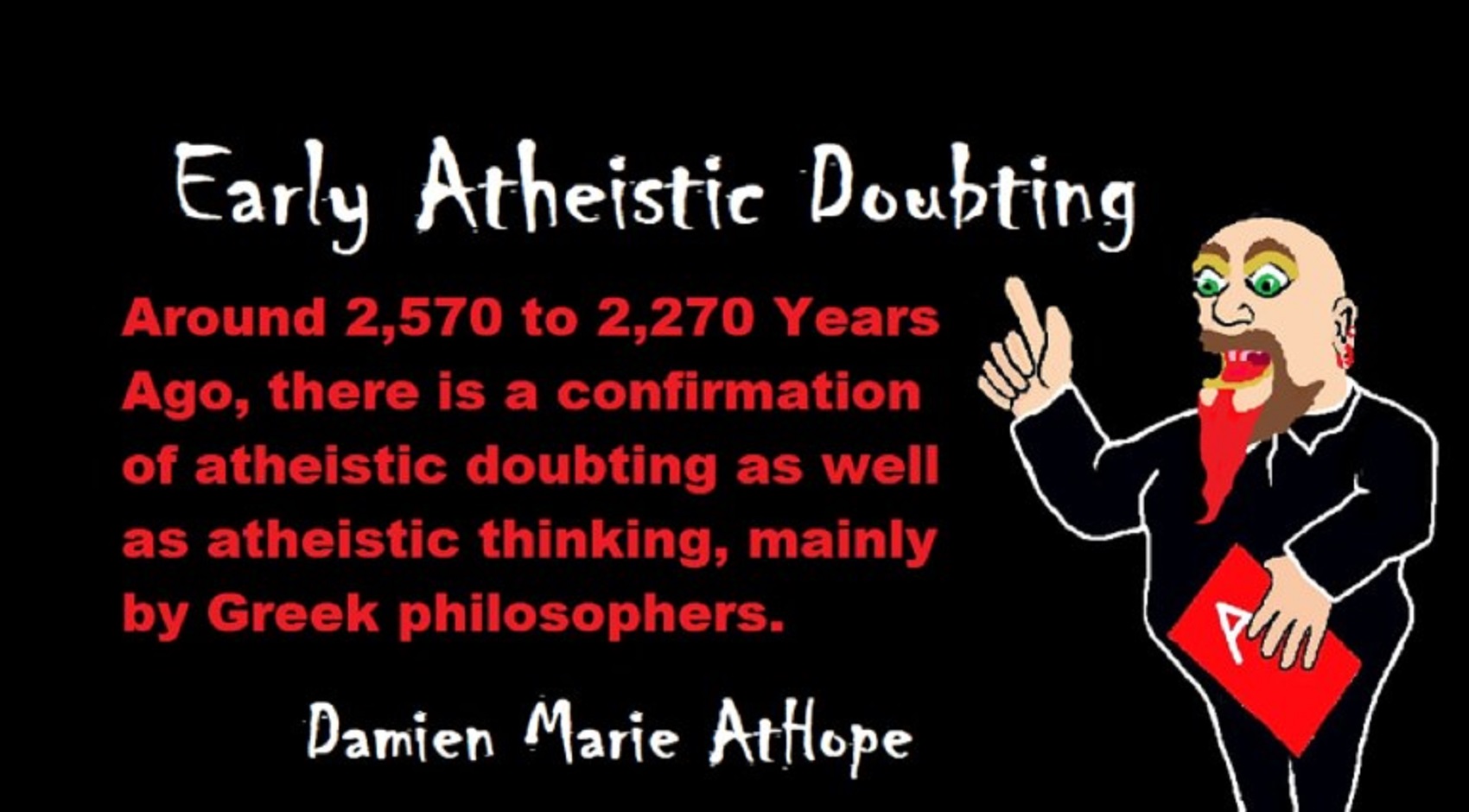
Expressions of Atheistic Thinking:
- Around 2,600 years ago, Ajita Kesakambali, ancient Indian philosopher, who is the first known proponent of Indian materialism. ref
- Around 2,535 to 2,475 years ago, Heraclitus, Greek pre-Socratic philosopher, a native of the Greek city Ephesus, Ionia, on the coast of Anatolia, also known as Asia Minor or modern Turkey. ref
- Around 2,500 to 2,400 years ago, according to The Story of Civilization book series certain African pygmy tribes have no identifiable gods, spirits, or religious beliefs or rituals, and even what burials accrue are without ceremony. ref
- Around 2,490 to 2,430 years ago, Empedocles, Greek pre-Socratic philosopher and a citizen of Agrigentum, a Greek city in Sicily. ref
- Around 2,460 to 2,370 years ago, Democritus, Greek pre-Socratic philosopher considered to be the “father of modern science” possibly had some disbelief amounting to atheism. ref
- Around 2,399 years ago or so, Socrates, a famous Greek philosopher was tried for sinfulness by teaching doubt of state gods. ref
- Around 2,341 to 2,270 years ago, Epicurus, a Greek philosopher known for composing atheistic critics and famously stated, “Is God willing to prevent evil, but not able? Then he is not omnipotent. Is he able, but not willing? Then he is malevolent. Is he both able and willing? Then whence cometh evil? Is he neither able nor willing? Then why call him god?” ref
This last expression by Epicurus, seems to be an expression of Axiological Atheism. To understand and utilize value or actually possess “Value Conscious/Consciousness” to both give a strong moral “axiological” argument (the problem of evil) as well as use it to fortify humanism and positive ethical persuasion of human helping and care responsibilities. Because value-blindness gives rise to sociopathic/psychopathic evil.
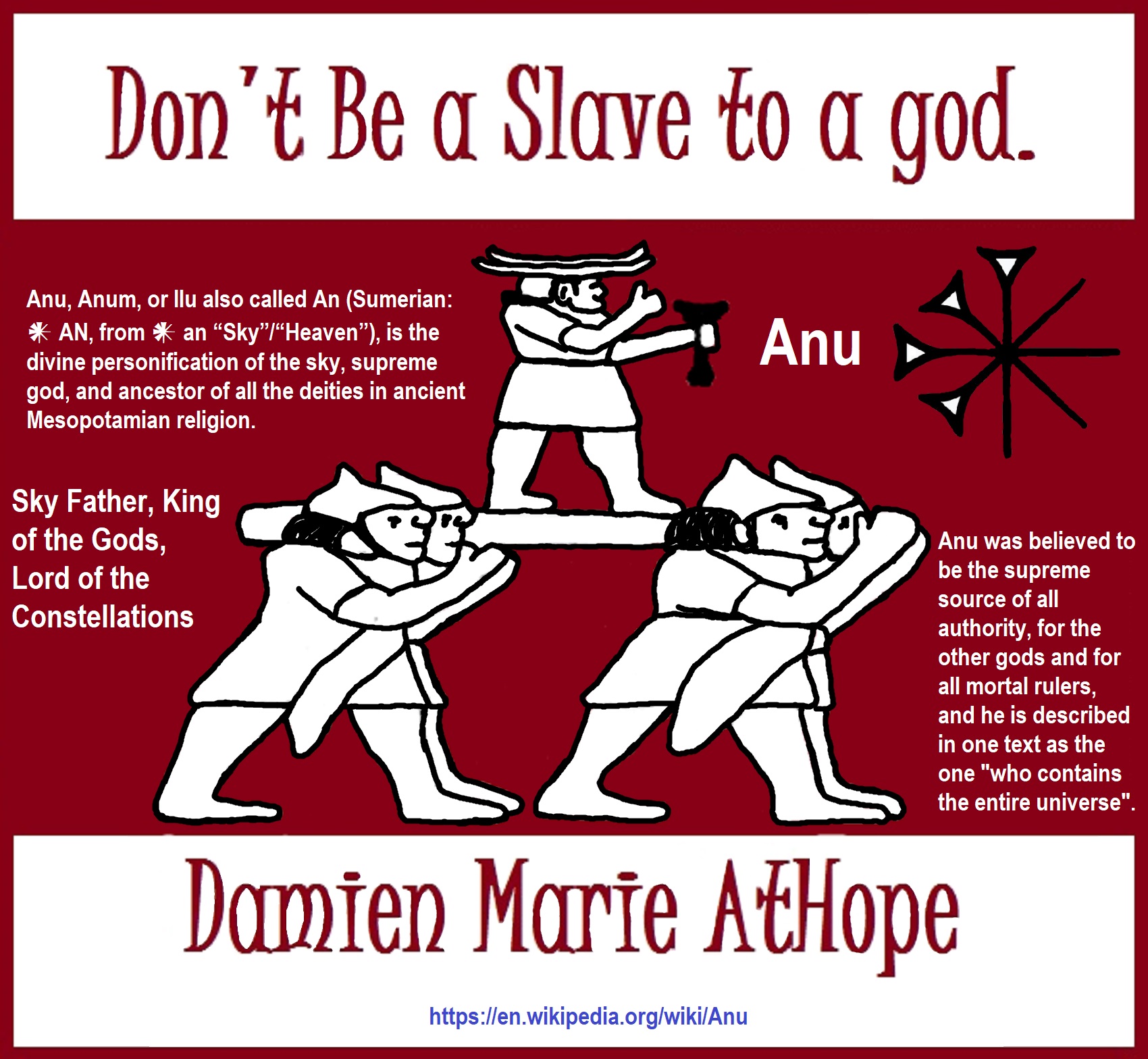
“Theists, there has to be a god, as something can not come from nothing.”
Well, thus something (unknown) happened and then there was something. This does not tell us what the something that may have been involved with something coming from nothing. A supposed first cause, thus something (unknown) happened and then there was something is not an open invitation to claim it as known, neither is it justified to call or label such an unknown as anything, especially an unsubstantiated magical thinking belief born of mythology and religious storytelling.
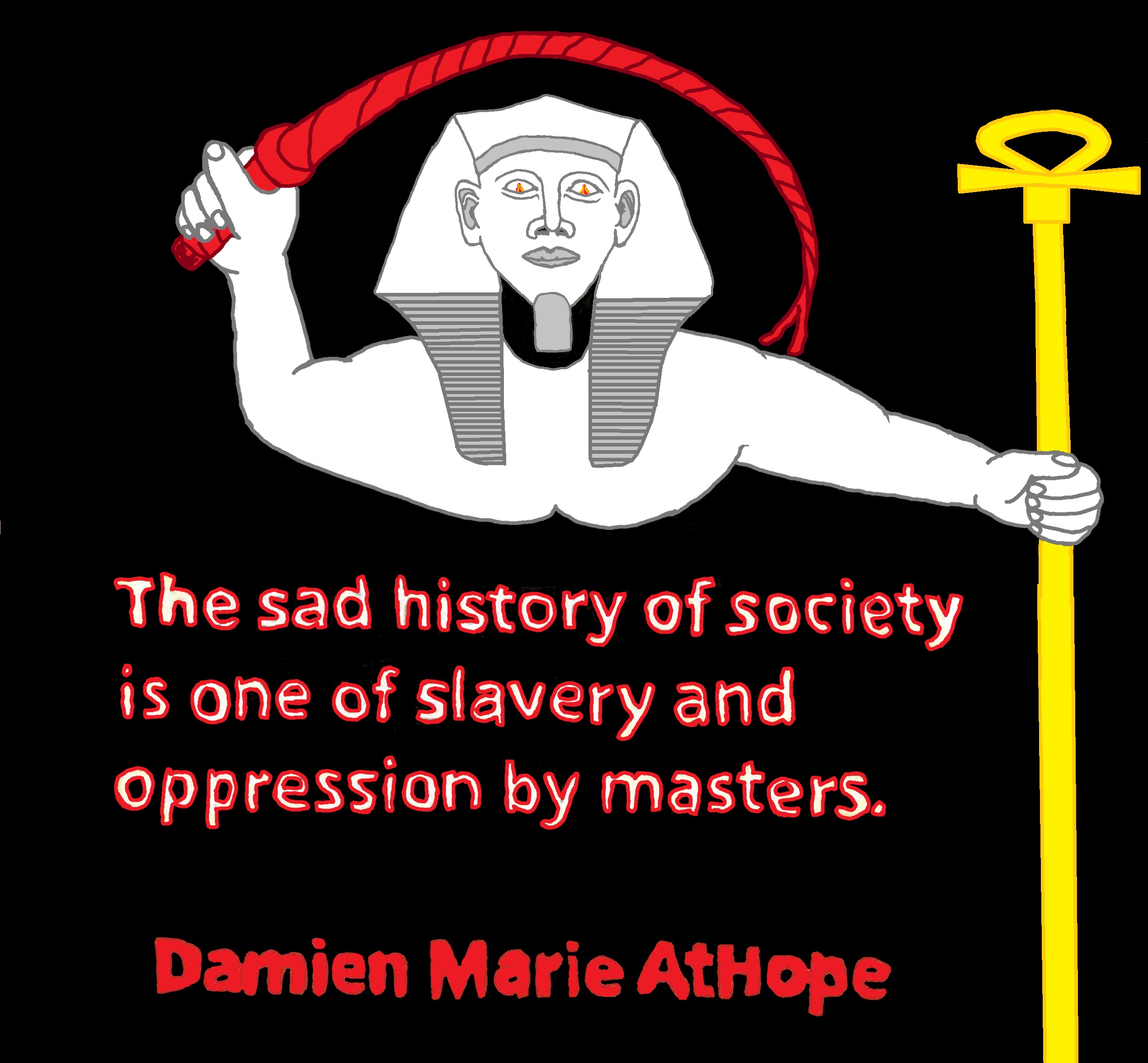
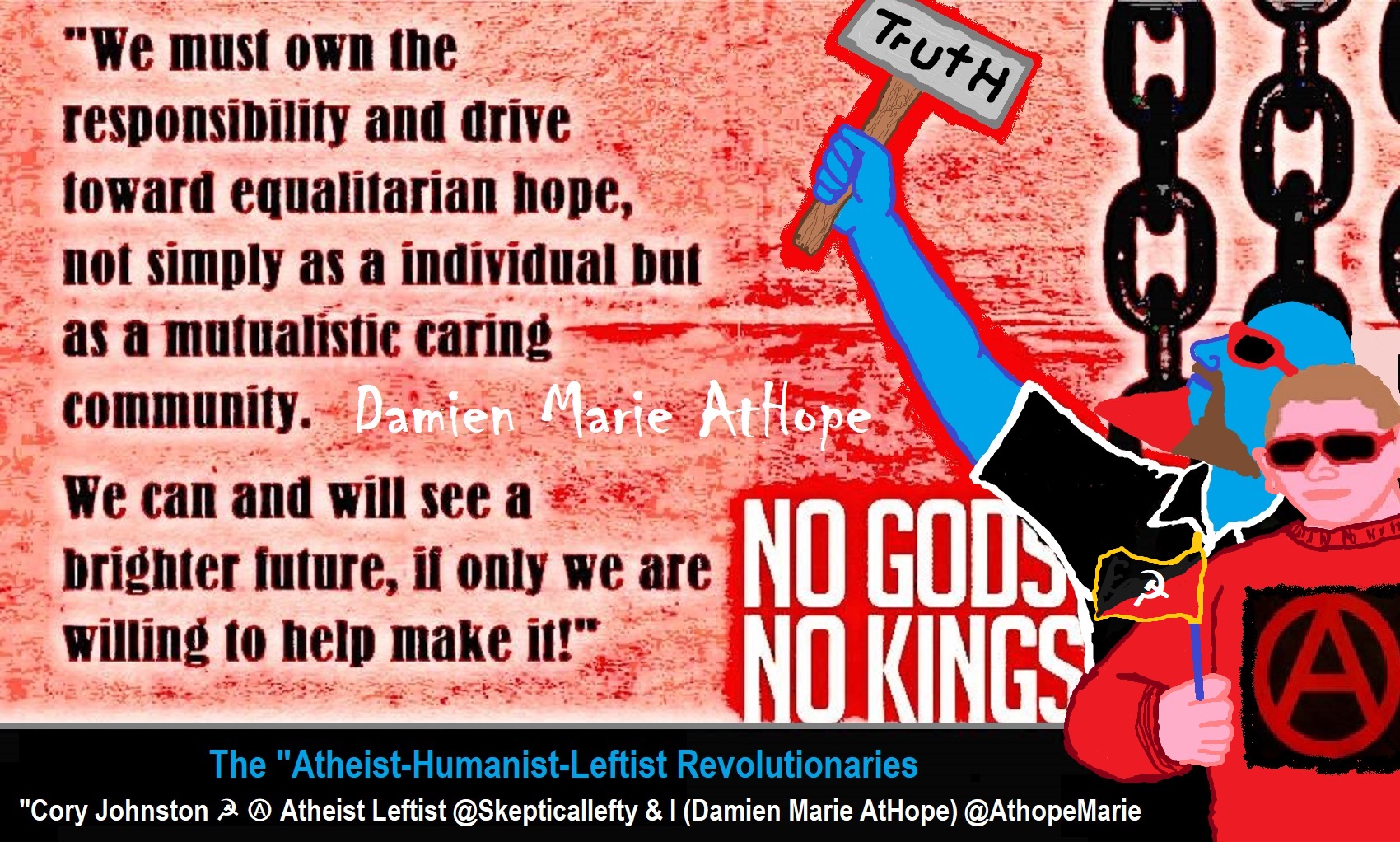
While hallucinogens are associated with shamanism, it is alcohol that is associated with paganism.
The Atheist-Humanist-Leftist Revolutionaries Shows in the prehistory series:
Show two: Pre-animism 300,000 years old and animism 100,000 years old: related to “Anarchism and Socialism”
Show tree: Totemism 50,000 years old: related to “Anarchism and Socialism”
Show four: Shamanism 30,000 years old: related to “Anarchism and Socialism”
Show five: Paganism 12,000 years old: related to “Anarchism and Socialism”
Show six: Emergence of hierarchy, sexism, slavery, and the new male god dominance: Paganism 7,000-5,000 years old: related to “Anarchism and Socialism” (Capitalism) (World War 0) Elite and their slaves!
Prehistory: related to “Anarchism and Socialism” the division of labor, power, rights, and recourses: VIDEO
Pre-animism 300,000 years old and animism 100,000 years old: related to “Anarchism and Socialism”: VIDEO
Totemism 50,000 years old: related to “Anarchism and Socialism”: VIDEO
Shamanism 30,000 years old: related to “Anarchism and Socialism”: VIDEO
Paganism 12,000 years old: related to “Anarchism and Socialism” (Pre-Capitalism): VIDEO
Paganism 7,000-5,000 years old: related to “Anarchism and Socialism” (Capitalism) (World War 0) Elite and their slaves: VIEDO
Paganism 5,000 years old: progressed organized religion and the state: related to “Anarchism and Socialism” (Kings and the Rise of the State): VIEDO
Paganism 4,000 years old: related to “Anarchism and Socialism” (First Moralistic gods, then the Origin time of Monotheism): VIEDO
I do not hate simply because I challenge and expose myths or lies any more than others being thought of as loving simply because of the protection and hiding from challenge their favored myths or lies.
The truth is best championed in the sunlight of challenge.
An archaeologist once said to me “Damien religion and culture are very different”
My response, So are you saying that was always that way, such as would you say Native Americans’ cultures are separate from their religions? And do you think it always was the way you believe?
I had said that religion was a cultural product. That is still how I see it and there are other archaeologists that think close to me as well. Gods too are the myths of cultures that did not understand science or the world around them, seeing magic/supernatural everywhere.
I personally think there is a goddess and not enough evidence to support a male god at Çatalhöyük but if there was both a male and female god and goddess then I know the kind of gods they were like Proto-Indo-European mythology.
This series idea was addressed in, Anarchist Teaching as Free Public Education or Free Education in the Public: VIDEO
Our 12 video series: Organized Oppression: Mesopotamian State Force and the Politics of power (9,000-4,000 years ago), is adapted from: The Complete and Concise History of the Sumerians and Early Bronze Age Mesopotamia (7000-2000 BC): https://www.youtube.com/watch?v=szFjxmY7jQA by “History with Cy“
Show #1: Mesopotamian State Force and the Politics of Power (Samarra, Halaf, Ubaid)
Show #2: Mesopotamian State Force and the Politics of Power (Eridu “Tell Abu Shahrain”)
Show #3: Mesopotamian State Force and the Politics of Power (Uruk and the First Cities)
Show #4: Mesopotamian State Force and the Politics of Power (First Kings)
Show #5: Mesopotamian State Force and the Politics of Power (Early Dynastic Period)
Show #6: Mesopotamian State Force and the Politics of Power (King/Ruler Lugalzagesi)
Show #7: Mesopotamian State Force and the Politics of Power (Sargon and Akkadian Rule)
Show #9: Mesopotamian State Force and the Politics of Power (Gudea of Lagash and Utu-hegal)
Show #12: Mesopotamian State Force and the Politics of Power (Aftermath and Legacy of Sumer)
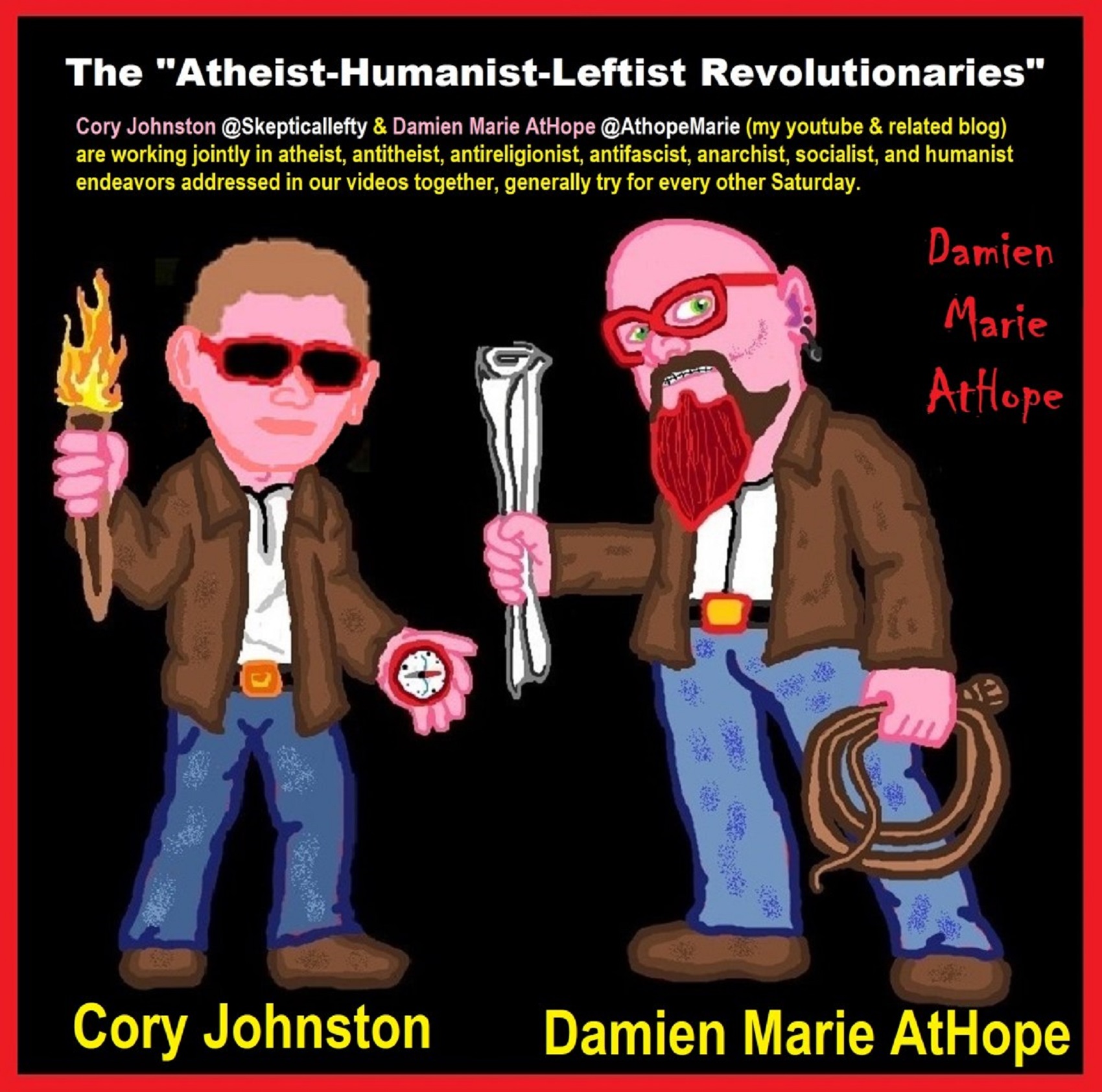
The “Atheist-Humanist-Leftist Revolutionaries”
Cory Johnston ☭ Ⓐ Atheist Leftist @Skepticallefty & I (Damien Marie AtHope) @AthopeMarie (my YouTube & related blog) are working jointly in atheist, antitheist, antireligionist, antifascist, anarchist, socialist, and humanist endeavors in our videos together, generally, every other Saturday.
Why Does Power Bring Responsibility?
Think, how often is it the powerless that start wars, oppress others, or commit genocide? So, I guess the question is to us all, to ask, how can power not carry responsibility in a humanity concept? I know I see the deep ethical responsibility that if there is power their must be a humanistic responsibility of ethical and empathic stewardship of that power. Will I be brave enough to be kind? Will I possess enough courage to be compassionate? Will my valor reach its height of empathy? I as everyone, earns our justified respect by our actions, that are good, ethical, just, protecting, and kind. Do I have enough self-respect to put my love for humanity’s flushing, over being brought down by some of its bad actors? May we all be the ones doing good actions in the world, to help human flourishing.
I create the world I want to live in, striving for flourishing. Which is not a place but a positive potential involvement and promotion; a life of humanist goal precision. To master oneself, also means mastering positive prosocial behaviors needed for human flourishing. I may have lost a god myth as an atheist, but I am happy to tell you, my friend, it is exactly because of that, leaving the mental terrorizer, god belief, that I truly regained my connected ethical as well as kind humanity.
Cory and I will talk about prehistory and theism, addressing the relevance to atheism, anarchism, and socialism.
At the same time as the rise of the male god, 7,000 years ago, there was also the very time there was the rise of violence, war, and clans to kingdoms, then empires, then states. It is all connected back to 7,000 years ago, and it moved across the world.
Cory Johnston: https://damienmarieathope.com/2021/04/cory-johnston-mind-of-a-skeptical-leftist/?v=32aec8db952d
The Mind of a Skeptical Leftist (YouTube)
Cory Johnston: Mind of a Skeptical Leftist @Skepticallefty
The Mind of a Skeptical Leftist By Cory Johnston: “Promoting critical thinking, social justice, and left-wing politics by covering current events and talking to a variety of people. Cory Johnston has been thoughtfully talking to people and attempting to promote critical thinking, social justice, and left-wing politics.” http://anchor.fm/skepticalleft
Cory needs our support. We rise by helping each other.
Cory Johnston ☭ Ⓐ @Skepticallefty Evidence-based atheist leftist (he/him) Producer, host, and co-host of 4 podcasts @skeptarchy @skpoliticspod and @AthopeMarie
Damien Marie AtHope (“At Hope”) Axiological Atheist, Anti-theist, Anti-religionist, Secular Humanist. Rationalist, Writer, Artist, Poet, Philosopher, Advocate, Activist, Psychology, and Armchair Archaeology/Anthropology/Historian.
Damien is interested in: Freedom, Liberty, Justice, Equality, Ethics, Humanism, Science, Atheism, Antiteism, Antireligionism, Ignosticism, Left-Libertarianism, Anarchism, Socialism, Mutualism, Axiology, Metaphysics, LGBTQI, Philosophy, Advocacy, Activism, Mental Health, Psychology, Archaeology, Social Work, Sexual Rights, Marriage Rights, Woman’s Rights, Gender Rights, Child Rights, Secular Rights, Race Equality, Ageism/Disability Equality, Etc. And a far-leftist, “Anarcho-Humanist.”
I am not a good fit in the atheist movement that is mostly pro-capitalist, I am anti-capitalist. Mostly pro-skeptic, I am a rationalist not valuing skepticism. Mostly pro-agnostic, I am anti-agnostic. Mostly limited to anti-Abrahamic religions, I am an anti-religionist.
To me, the “male god” seems to have either emerged or become prominent around 7,000 years ago, whereas the now favored monotheism “male god” is more like 4,000 years ago or so. To me, the “female goddess” seems to have either emerged or become prominent around 11,000-10,000 years ago or so, losing the majority of its once prominence around 2,000 years ago due largely to the now favored monotheism “male god” that grow in prominence after 4,000 years ago or so.
My Thought on the Evolution of Gods?
Animal protector deities from old totems/spirit animal beliefs come first to me, 13,000/12,000 years ago, then women as deities 11,000/10,000 years ago, then male gods around 7,000/8,000 years ago. Moralistic gods around 5,000/4,000 years ago, and monotheistic gods around 4,000/3,000 years ago.
To me, animal gods were likely first related to totemism animals around 13,000 to 12,000 years ago or older. Female as goddesses was next to me, 11,000 to 10,000 years ago or so with the emergence of agriculture. Then male gods come about 8,000 to 7,000 years ago with clan wars. Many monotheism-themed religions started in henotheism, emerging out of polytheism/paganism.

Damien Marie AtHope (Said as “At” “Hope”)/(Autodidact Polymath but not good at math):
Axiological Atheist, Anti-theist, Anti-religionist, Secular Humanist, Rationalist, Writer, Artist, Jeweler, Poet, “autodidact” Philosopher, schooled in Psychology, and “autodidact” Armchair Archaeology/Anthropology/Pre-Historian (Knowledgeable in the range of: 1 million to 5,000/4,000 years ago). I am an anarchist socialist politically. Reasons for or Types of Atheism
My Website, My Blog, & Short-writing or Quotes, My YouTube, Twitter: @AthopeMarie, and My Email: damien.marie.athope@gmail.com

